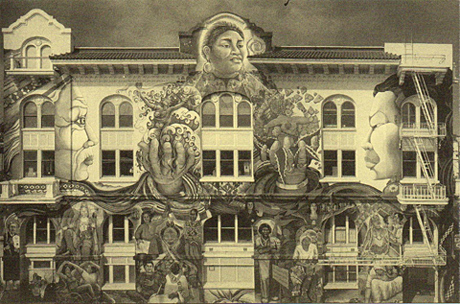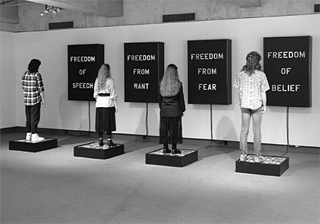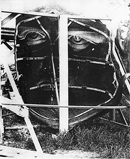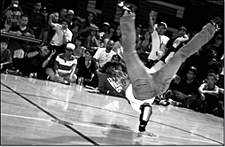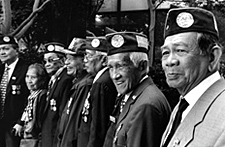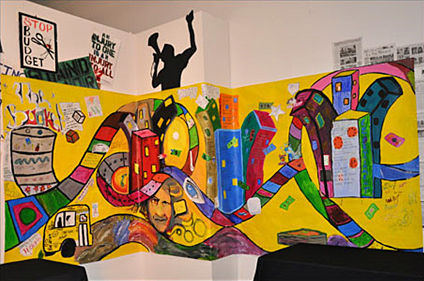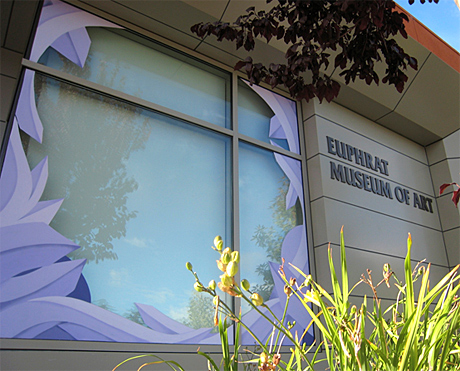 |
|
|
Roots and Offshoots - The Blossoming of Silicon Valley's Arts Community
"Roots and Offshoots, the Blossoming of Silicon Valley's Arts Community," a cross-cultural, interdisciplinary essay, was first posted here in August 2014 and published in the Californian, Fall 2014. The revised essay is now the opening essay in the book Roots and Offshoots, Silicon Valley's Arts Community published in 2017.
For more information about historical San José area arts development, including the Silicon Valley Arts Council, and an overview of San José arts activity in the 1970s and early '80s, see "The First San José Biennial" essay, Jan Rindfleisch, for The First San José Biennial, 1986, San José Museum of Art.
The story of the development of the arts in Silicon Valley has just begun to be told. Its art history is filled with people who were often marginalized, people who stood up to the status quo, people with the guts and love to persevere and build a community that nourished all, at a time when that was not easy to do. It's time to tell the story.
How did we get from the largely monochromatic, exclusive, and repressive landscape of the 1970s to where we are now? In this article, I will introduce various elders and others who have contributed creatively to the blossoming of Silicon Valley, place them in a broader context of community building, and set the stage for individual profiles still being collected. We need context for current discussion, and for our historical documentation that is so easily lost—websites included. My intent is to raise questions and ideas about how the arts, community, and democracy can flourish in Silicon Valley. I suggest that academics, community leaders, artists, activists, and students can take action to enrich and document the arts forum across cultures, academic and professional disciplines, and economic sectors. This examination should consider new types of arts roots, startups, and offshoots. All can be incorporated into our Silicon Valley identity, already known for its innovative problem-solving culture. Despite the levels of complexity in our local art history, the tale remains instructive and relevant. For some of the people involved, the story of what they were up against and how they worked to change it is their legacy; for many more, it is what they continue to do. Common among all of them is a grounded connection to fundamental human concerns, plus an ability to relate to diverse communities. Let's begin to meet some of these fascinating people and see where a good heart can take us. The death of Consuelo Santos-Killins in 2012 was a wake-up call for me and other arts activists to start telling the story of arts community building in Silicon Valley. During her long lifetime, she was a key figure in the effort. She brought an overarching vision integrating art, socioeconomic issues, and politics, with an understanding of basic human needs, important for leaders and activists of any age. The vivacious redhead served on the San José Fine Arts Commission, the Santa Clara County Arts Council, and the California Arts Council, among other arts organizations. She argued for substantive arts programs in the schools and community, and more diverse participation in arts governing boards. Compassionate and generous toward all in need, Santos-Killins—once a nurse—did not limit her activism to the arts, but the arts remained foremost for her.1 San José Mercury News columnist Scott Herhold remembers, "You could talk to Santos-Killins about, say, the need for corporate directors to ask more questions, and before your talk was over, she would have convinced you utterly of the need for ceramics and music and painting in the schools." "The assumption is that quality exists only in highly visible cultural institutions—the truth is an abundance of artistic quality exists in Santa Clara Valley… As in San José, significant progress in the arts will occur when people speak up in order to change attitudes toward art—people who believe in the area they live in." — Santos-Killins Making an Arts Community
Building an arts environment requires energy, courage, and determination, but Santos-Killins wasn't the only one. Silicon Valley blossomed in the last quarter of the 20th century with the formation of arts offshoots, spin-offs, and startups that tapped into the area's increasing ferment of ideas and involved myriad supporters across all walks of life.2 Through my own long and varied involvement in the arts as an educator, presenter (producer, director), author, community activist, and fellow artist, I witnessed the growth of this community. I worked with an unusual cast of characters and discovered some seldom-discussed basics of a sustainable, stimulating arts/cultural system.
What follows is a personal narrative with perspectives drawn from my experiences with the art world and with Silicon Valley artists and arts institutions that stood apart from, challenged, or broadened, the mainstream perspective. Along the way, I hope to provoke timely and substantive questions and draw answers that elucidate what it means to build a vibrant arts community, such as the importance of small organizations in the cultural mix and of experimenting with open and flexible organizational structures. The Early Cultural Landscape
The road toward arts development in the South San Francisco Bay Area was paved by the San José Art League,3 formed in 1938 by a group of San José artists, mostly San José State University (SJSU) teachers and students, to stimulate public interest in art. In Depression-era Santa Clara Valley, the agricultural economy still functioned because of the blossoming of trees, the stone fruit that followed, and the diverse labor pool available. Post-WWII movements for civil rights in the 1950s and '60s laid the groundwork for change, opening doors in academia, community, and workplace, but change took longer to resonate in Santa Clara Valley, today better known as Silicon Valley. Conservatism accompanied Cold War fears and a local economy that increasingly stemmed from defense (Lockheed, FMC, Varian, later Fairchild Semiconductor, Intel). There were valiant attempts to open up the valley to new ideas. When post-WWII migration to California brought urban sprawl, the Art League sought to improve San José's downtown image and bring culture to the city center. Pioneers like art professor John De Vincenzi and artist Mary Parks Washington guided the Art League in the 1960s and '70s, went on to influence further art developments like the San José Museum of Art and their Black on Black Film Festival, and provided counsel during tumultuous times. The community branched out to found new museums, such as the Triton Museum in Santa Clara. De Vincenzi and Washington racked up decades of teaching, honors, and community service in the arts via multiple tacks, from the San José Fine Arts Commission to the San José Chapter of Links, Inc. The de Saisset Museum at Santa Clara University featured a permanent California history exhibition, including Native American art and art from Mission Santa Clara, plus changing contemporary art exhibitions. The de Saisset, in keeping with the university's culture of service, had a social justice component from the start, reaching out to diverse communities, including hiring women directors,4 when that was not the norm.
Mary Parks Washington, Erik, 1999. Mixed media, c 38"x30". Image courtesy Mary Emma Harris, Black Mountain College. A memorial tribute to her son, a screenwriter. Washington—artist, arts advocate, educator, historian—created "histcollages," embedding historic documents into her art. Her research shows artistry in the local African American community going back to the 1800s; a story of a janitor, a leading suffragist, and art stars from different centuries, three women of different racial/ethnic backgrounds; and the contemporary politics of art placement, substance, and importance in the Dr. Martin Luther King, Jr. Library and city spaces.
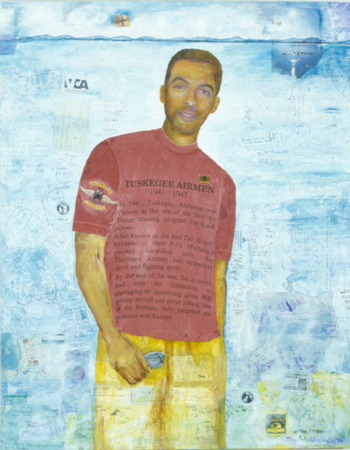
Despite these efforts, a sustained cultural blossoming has been difficult. Maintenance of routine practices with exclusionary results checked the momentum built on the groundwork of the 1960s. The newborn San José Museum of Art (SJMA) sought instant status and funding in the 1970s by emphasizing art history exhibitions, a common tactic using conventional groupings—artists abroad, Impressionism, Post-Modernism—rather than the diverse talents available here and elsewhere. Simultaneously, the San José State University (SJSU) art department, a white-male bastion closely aligned with the SJMA, banked on their 1960s legacy "School of San José," with its elegant objects, industrial techniques, and materials. Not surprisingly, for Stanford Museum of Art's 1974 Ten West Coast Artists, all ten artists selected were male. Even as late as 1986, when the SJSU galleries featured the School of San José exhibition for The First San José Biennial, of 23 participating artists, there were only one African American and one female represented. To make matters worse, in the 1970s and long afterward, people of means in the South Bay often went north for culture, even as our lingering orchards gave way to tract homes5 and de facto segregated communities.6 Considered a frill and scantily funded, the arts—in education and the community—encountered rough times, and many artists left the South Bay for San Francisco.7 For example, as a result of the enactment of Proposition 13 in 1978, funding for our fledgling Euphrat Museum of Art (then called Euphrat Gallery), founded in 1971 at De Anza College in Cupertino, was essentially cut to zero.8 Large arts organizations,9 often seen as the backbone of an arts community, had their own survival problems as they tried to cultivate individual donors and basic support from local government and the business community,10 but the loss of funding from tax revenue was particularly devastating to public arts education, social services, and community cultural programs. The 1970s: Pervasive Exclusion
The politics of inclusion in the arts was and continues to be contentious. Today, various kinds of discourse are taken for granted—how the arts might be used to advocate for human rights, social justice, and peaceful conflict resolution and promote cultural understanding and recognition; examinations of the function and place of art in the schools and our lives, or the relationship of art with government; the interaction of the arts with other academic disciplines. We had to fight to have those ideas taken seriously.
When I was a student in the 1970s, exclusion was pervasive—of women, people of color, people with disabilities, people considered "different" for whatever reason. There were essentially no women in art history survey texts used in universities. My first art history text was the 1973 version of H.W. Janson's History of Art: A Survey of the Major Visual Arts from the Dawn of History to the Present Day, then the prevailing college text in the United States. It was a man's art history; no women were included, not even Impressionist Berthe Morisot or the legendary Georgia O'Keeffe. Much of the non-Western world was passed over or lumped into a section on "primitive art" and a nine-page postscript, "The Meeting of East and West." Contemporary non-European art scarcely merited a mention, with the exception of a dismissively judgmental paragraph about Expressionism in Mexico.11 It was a long road from the woman as nude model or male fantasy object to a fully realized woman as professional artist, academic, and/or cultural leader. SJSU art department alumnae remember "fanny pinching in the elevator back in the '70s. Wine and cigarettes were the bill of fare for critiques." There were some discussions,12 but the art world clearly needed a jolt and an overhaul. At SJSU, visiting professor Judith Bettelheim did shake things up. In my early years as the director of the Euphrat Museum of Art, she contributed to the Museum's first major publication (1981) with an essay about Leila McDonald and "women's hobby art," citing barrier-breaking art historian Lucy Lippard.13 In her magazine Visual Dialog,14 satiric printmaker/educator Roberta Loach of Los Altos published statistics quantifying the appalling discrimination against female artists. Not only did that resonate with my scientific training in basing theory upon measurable information, it made the case to others who need to see the numbers.15
Visual Dialog, Vol. 2, No. 3, 1977, the second of two issues on "Women in the Arts." Roberta Loach published, edited, and wrote for Visual Dialog, 1975–1980, a scholarly California journal of the visual arts.
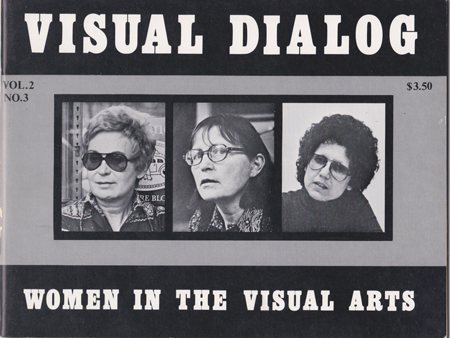
Even though in the 1970s more women, people of color, and those with diverse gifts and backgrounds were hired in teaching and administration, the institutionalized culture then prevalent in academia, galleries, and museums did not truly value diversity of issues and ideas.16 Working within these organizations, one often paid a heavy price personally, politically, and economically for advocating openness and inclusion. Tokenism—hiring a single female or nonwhite person, or programming exhibitions encapsulating artists by gender or ethnicity to demonstrate the institution's commitment to diversity—reigned.17 The general climate in many university arts programs undercut initiatives for change. Art that had any sort of socially relevant content (different from the status quo) was disparaged as "political art," as opposed to "real art."
Pioneer artists Patricia Rodriguez and Marjorie Eaton with Rodriguez's heart sculpture in the exhibition Staying Visible, The Importance of Archives in 1981. Rodriguez, from San Francisco, described prevalent art world responses in the '70s: "[they] turned up their noses," "they didn't know how to accept my art," "it was difficult because I was not in step." She chose to do hearts instead of the usual abstract "yellow canvas with a white dot." Her art was cultural, emotional, as was Eaton's, and both had a passion for evocative murals. Eaton could have told Rodriguez about how it was painting with emotive artists Diego Rivera and Frida Kahlo in the 1930s, because she lived it. Eaton loved people. For many decades, Eaton nurtured a diverse avant-garde arts colony in the Palo Alto foothills on the historic ranch site of legendary Juana Briones and shared her legacy of caring. Contemporary academic research on Briones and Eaton is illuminating their times and their lasting meaning for California cultural development. Photo: Helen Fleming.
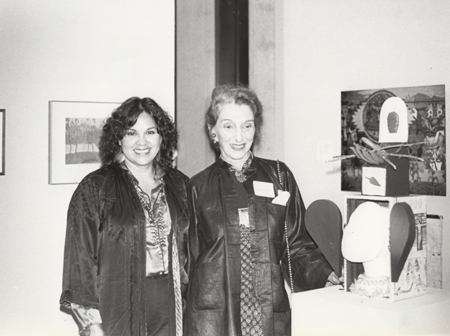
Breaking New Ground: Creative Strategies
The blossoming of Silicon Valley into a home for vibrant cultural startups was the result of three key growth factors: 1) The desire and courage to widen the vista and dialogue of new ideas and values begun by pioneering activists; 2) Formation of flexible, open structures that combine vision with a grounded understanding of real-world struggles that kept in touch with our basic humanity; and 3) Involvement of dedicated individuals, who provided counsel, advocacy, and investment of time and money. The combination of these attitudes and actions energized the breaking of new ground in addressing the issue of exclusion in the arts.
As a college instructor in studio art and art history, I was one of the change-seekers who rewrote studio and art history courses and books (late 1970s, early '80s),18 adding women and people of color, as well as unusual media and ideas. Some women altered their first names; others, including artist/activist/educator Ruth Tunstall Grant and me, occasionally used only our first initials to sidestep prejudice (for example, to get our work into an exhibition). But most exciting of all, we started to connect with others around the Bay. For me, as a motivated educator/presenter/activist, that meant learning from acclaimed visionary artists/activists, including Ruth Asawa, who developed whole-person art programs in San Francisco public schools starting in 1968 and her renowned Ruth Asawa San Francisco School of the Arts in 1982; Patricia Rodriguez, founder of Las Mujeres Muralistas (women muralists), who created brightly colored murals in Balmy Alley and elsewhere in San Francisco's Mission District from 1970 to 1979; Carlos Villa, who directly challenged the entire academic/cultural establishment from within,19 organizing diverse, thought-provoking programs at San Francisco Art Institute; and then-novice artist Mildred Howard, Berkeley, who curated a Heartfelt Hearts exhibition in 1977 that included her own mixed-media textile constructions, Chocolate Hearts.20 Years later, Howard would be featured in top galleries, museums, and art history survey texts. Building New Forms
We began to build new forms of arts startups from scratch in the cities of the Peninsula and South Bay, gathering together a unique blend of people from the arts and academia, along with forward-thinking government and business leaders. Without the decades-long dedication of a broad base of partners and leaders, all the good that was accomplished would have taken much longer and been far more difficult than anyone could have possibly imagined. Our new hybrids included old-timers, newcomers, people finding their way in satellite cities, special-needs populations, supportive nonprofits, people from other parts of the world. Building community with a group of insightful, innovative dynamos proved to be the real energizer.
Two such dynamos were cartoonist Gen Pilgrim Guracar and historian Connie Young Yu, an amazing duo on the Peninsula who moved past barriers as early as the 1970s. They reached across cultures and disciplines, and brought together people from different walks of life. Using pen and paper, needle and thread, they combined living art and democracy. Guracar organized the dozens of women creating The People's Bicentennial Quilt (1974), and Yu wrote the book The People's Bicentennial Quilt: A Patchwork History (1976) that tells the story behind each square. At the Euphrat, we wrote about this early collaborative public art as part of our exhibition and publication The Power of Cloth: Political Quilts, 1845–1986.21
Patchwork History, The People's Bicentennial Quilt, Connie Young Yu. 1976 version printed by UP PRESS, East Palo Alto, CA. Republished by the Saratoga Historical Foundation in 2010.
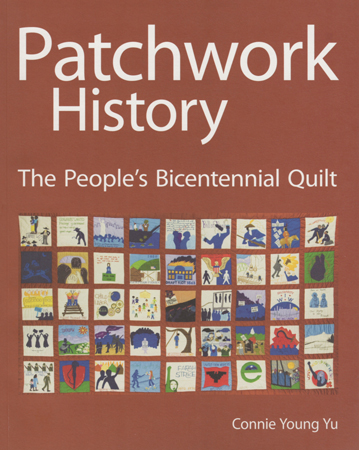 "We made this quilt," wrote organizer Gen Guracar, "in answer to those who would commercialize our Bicentennial celebration … leaving us without a spiritual link to those who struggled so hard for the rights that we have now." In her foreword, Connie Young Yu writes: "We wanted to portray the people as making history: the nameless, countless members of movements and struggles that have affected the soul and character of America. We felt there was much in American history that could unite us and inspire us in a cynical time…We hope to inspire other community groups to celebrate American culture and history in a true revolutionary spirit." In the same time frame, Deanna Bartels (now Tisone), Betty Estersohn and Joan Valdes used video—then "cutting-edge" technology—to explore and document breadth in San Francisco Bay Area art making, even art and open space. The three Peninsula artists taped early social activists/environmentalists Frank and Joséphine Duveneck, who purchased and used their land, Hidden Villa in Los Altos Hills, in order to protect an entire watershed, advance social justice, and promote environmental education. The trio's Marjorie Eaton video opened a world of hidden Silicon Valley cultural histories from Ohlone Indian and local pioneer struggles in post-Mission days to a modern family-like community of artists. It inspired me to collaborate with them on an exhibition, publication, and further programming. The NEA-funded First Generation videos included visual art stars like Ruth Asawa, dancers Jasmine and Xavier Nash in the early '70s in the Fillmore, and clay artist Bea Wax in Palo Alto. First Generation was one of Tisone's many collaborative, interdisciplinary art projects over the last decades. Today we are working on making more of this history accessible and available online. Shoots and Offshoots
In the late 1970s in San José, a group of aspiring curators with a strong SJSU contingent began a series of attempts to create viable spaces where emerging artists could show their work. Art professor Tony May and I first wielded hammers for art in an old building on Santa Clara Street in downtown San José. May was, and continues to be, a key catalyst.22 We put our energies into Works Gallery (1977), an offshoot of Wordworks, which in mid–1980 reopened as the San José Institute of Contemporary Art (SJICA). Works Gallery, SJICA, and others could be termed alternative art spaces, art lingo for increased non-traditional exhibition opportunities for emerging artists. Because artists, poets, and other creative people need multiple venues to flourish, the creation of these alternative organizations sparked cultural growth in Silicon Valley and put the area on the arts map.23The core groups I speak of here, however, might be called "alternative-alternative" organizations. These smaller organizations (and offshoots from large organizations that manage to grow independently from their parent group) often begin with altruistic goals and a commitment to community-building, and are free to exhibit more flexibility. Pioneers in this arena, like artist Ruth Tunstall Grant, led the way and overcame obstacles. Tunstall Grant gave SJMA and Silicon Valley new dimensions by drawing in community diversity, giving opportunities to creative people of color, and starting studio art programs in city schools and the county youth shelter.24 The alternative-alternative groups have often served as reality checks, providing grounding for the large institutions. These shoots and offshoots find new doors to open, notice diversity of ideas in their own backyard, meet needs of diverse artists and the student in all of us, and understand the social dynamics and issues of their communities.25 Opening the Door
During the late 1960s and continuing into the '70s and early '80s, various small organizations—hybrids of business, education, and volunteer models, supported at times with government funding—opened doors to other cultures. I grew to know and value their work, and collaborated extensively with some of these innovators. In 1968, two visionaries, artist/educator Cozetta Gray Guinn and her physicist husband Isaac "Ike" Guinn, established Nbari Art, a museum-quality gallery in Los Altos, highlighting the work of students at Stanford and UC Berkeley. Their gracious and welcoming shop featured imported African art and African American art, and offered us an invaluable cultural resource for four decades. In the early 1970s in an abandoned downtown San José storefront near First and San Carlos Streets, artist Mary Jane Solis26 and activist Adrian Vargas (founder/director of San José's Teatro de la Gente, 1967–1977) co-founded El Centro Cultural de la Gente, the South Bay's first Chicano/Latino cultural center. El Centro's exhibitions, art programs, and luminaries had an impressive roster, including: Lorna Dee Cervantes and her Mango Press, artist José Antonio Burciaga, Las Mujeres Muralistas, and Luis Valdez, the father of Chicano theater. Solis curated art exhibitions, managed arts programs, called attention to social justice related art, and spoke out for multicultural arts—for "a place to come together and feed the spirit." In 1973, renowned painter Paul Pei-Jen Hau (Hau Bei Ren) and Mary Hau opened their Chinese Fine Arts Gallery in downtown Los Altos. Their personal invitation to understand Chinese culture countered lingering anti-Chinese sentiment, and in 1979, with Paul Pei-Jen Hau as its guiding spirit, artists, and friends founded the American Society for the Advancement of Chinese Arts.27
Paul Pei-Jen Hau (born in 1917) and Mary Hau in 2009, celebrating at the reception for Looking Back, Looking Ahead.
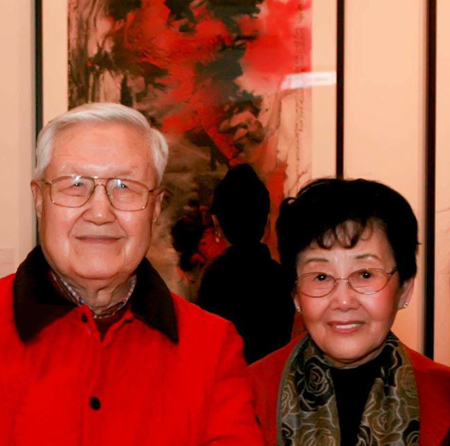
Artist Terese May remarkably opened the stubborn art world door to the culture of domesticity, through her quilts and paintings. Periodically, she assisted the San José Museum of Quilts & Textiles, the first museum in the U.S. to focus exclusively on quilts and textiles as an art form. Started in Los Altos in 1977, the museum was essentially a collaborative, volunteer organization for a decade before hiring its first paid director. In 1981 in Palo Alto, Trudy Myrrh Reagan started YLEM: Artists Using Science and Technology.28 With our similar backgrounds in science and art, Reagan and I exchanged ideas and collaborated on exhibitions. In 1984 at SJSU, quiet-but-determined art professor Marcia Chamberlain took the initial lead of CADRE Laboratory for New Media, an interdisciplinary academic and research program dedicated to the experimental use of information technology and art.29 We strategized frequently, and she invited me to write the essay for the CADRE '84 catalog. Expanding the Boundaries
While doors were opened, the struggle to change minds continued. Quilts, fiber arts, and "computer art" were saddled with countering prejudices about "women's work" or "right/left brain" thinking, and had little acceptance in the academic and institutional art world. In fact, the two worlds rarely communicated.30
In 1979, when I became director/curator at the Euphrat Museum of Art at De Anza College, I brainstormed with activists and potential staff and board members how we could build community, foster civic engagement, and go beyond disciplines and narrow definitions to explore new ideas. For us, the open-door policies of the community college system and the logic of partnerships were great avenues for experimentation. We realized the urgent need for new systems to open up opportunities, give visibility to contemporary artists and ideas from diverse sources, and promote thought and discussion. With this in mind, we initiated a unique campus/community partnership.31 Working with incredible innovators, beginning with artists/activists Jo Hanson (Art from Street Trash) and Carlos Villa (performance art with dramatic installations of feathered capes) and poet George Barlow, we expanded the boundaries of what could be considered art and what merited attention or discourse, and began a stellar poetry series that would include Dennis Brutus and Quincy Troupe. Early exhibition examples were The Workplace/The Refuge (Janet Burdick and Scott Miller recreating their San José studio in the Euphrat) and Men and Children (views from six Bay Area male artists with diverse backgrounds) in 1980; an exhibition to celebrate the 1981 International Year of Disabled Persons, developed with De Anza's Physically Limited Program; followed by our seminal Staying Visible, The Importance of Archives, which directly addressed visibility issues. CROSSOVER, the first of many art and technology exhibitions, came in 1982, and Commercial Illustrators, 1981, and Illustration/Design, 1983, introduced processes and artwork from Bay Area commercial artists, another discipline not recognized at that time by the art world.32 And that was just the beginning.33 We responded to suggestions from the community. A student asked me why there never seemed to be any religious art in modern art galleries. So in 1982, we investigated the subject in Art, Religion, Spirituality.343536
Signe Wilkinson, 6/23/82, San José Mercury News, reprinted in Illustration, Design. Commercial art was not recognized by the art world in the early '80s. To broaden the institutional mindset and see larger contexts to struggles, we worked with people in related fields such as Wilkinson. A cartoonist extraordinaire who got her start sitting in on San José Mercury News editorial sessions, Wilkinson went on to Philadelphia and became the first woman to win a Pulitzer in cartooning. Feisty and funny, she could open anyone's mind.

There were noticeable structural parallels between the growth of the alternative arts scene and that of Silicon Valley tech culture, although tech culture has had its own problems with insularity. From Hewlett Packard in its early days to Google, many companies saw the wisdom of loosening reins and regulations, and were increasingly open to new values, different cultures, and varied schedules and ways of working. Dress codes relaxed from the stiff suits of previous eras. Size played a role in cultural development. Large companies gave rise to spin-offs, and startups were staffed by even smaller teams. Via these spin-offs and startups, innovative individuals could make direct connections with education, youth, music, and gamers, as well as counterculture, geek and activist cultures, and the global community. Steve Jobs started Apple Computer in Cupertino in 1976, just down the street from the Euphrat. Apple supported and participated in many early Euphrat Museum exhibitions, and the Euphrat created art exhibitions in numerous Apple buildings. We connected with Apple on many levels.37 The Late 1980s/1990s: New Ventures, Ethnic Dimensions, Community Building
At Stanford, Cecilia and José Antonio Burciaga did something different. From 1985–1994, the couple lived at Casa Zapata as Resident Fellows—she as a top university administrator, he as resident artist—both working closely with student and community needs.38 José (a.k.a. Tony, Toñ o) created murals at Casa Zapata, and used comedy to attack racism and narrow divisive thinking, and published poetry and writings, e.g. Weedee Peepo (1988). ("…Tony remembers his parents preparing for their citizenship tests and saying to each other: 'Have you learned el Weedee Peepo?' That was how the Burciagas pronounced the words that perhaps more than anything else make American, Americans: 'We the People,' the first three words of the preamble to the Constitution." José Cardenás, Arizona Republic, 2005.)
José Antonio Burciaga taught us how to Drink Cultura. Drink Cultura was first published in 1979 by Lorna Dee Cervantes's Mango Press in San José. Detail of T-shirt accompanying the publication.
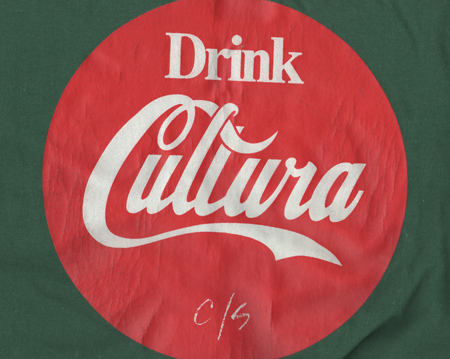
In 1989, artists/activists Betty Kano of Berkeley and Flo Oy Wong of Sunnyvale founded the Asian American Women Artists Association (AAWAA) in the Bay Area to "promote the visibility of Asian American women artists" who lacked recognition in their own traditional culture and were again overlooked when national museums sought Asian art stars. Also in 1989, Maribel Alvarez, Rick Sajor, and Eva Terrazas envisioned arts programming as a vehicle for civic dialogue and social equity and founded Movimiento de Arte y Cultura Latino Americana (MACLA) in downtown San José. Alvarez recalls, "When we got involved, the way to ignite the sort of movement included in our name…was a literary movement." We both worked with another powerful arts couple, poets Juan Felipe Herrera and Margarita Luna Robles. They organized poetry readings downtown, in East San José, and at the Euphrat Museum in the 1980s, lifting us all in spirit, bringing poems by, from and for the people, without shrinking from telling hard truths in poems like Robles's Suicide in the Barrio. I marveled at the ongoing vibrancy of Ruth Tunstall Grant, who in the 1990s founded Genesis/A Sanctuary for the Arts in San José creating exhibitions, presentations, performing arts, and artist studios, bringing together different cultures and simultaneously establishing a visible presence for the black community. Somehow, in the same decade, she developed the art program for foster youth at the Santa Clara County Children's Shelter, after directing and building the outstanding children's art school at SJMA in the 1980s. After she worked in San José, artist Jean La Marr introduced us to Urban Indian Girls, which became part of Euphrat's 1984 FACES exhibition; a decade later La Marr collaborated with the local Muwekma Ohlone Tribe to create The Ohlone Journey mural in Berkeley. Given the Native American Diaspora, my early knowledge of local Indian art often came through transient artists who connected both with far-flung traditional communities and part-time academic assignments around Northern California.39 As artist Consuelo Jimenez Underwood, Cupertino, put in an artist statement: "With beauty, grace, and traditional form, my work expresses the quiet rage that has permeated indigenous peoples of the Americas for over five hundred years."40 Underwood would develop and head the textiles/fiber program at SJSU for over twenty years.
Jean La Marr, Urban Indian Girls, 1981. Etching, 16"x18".
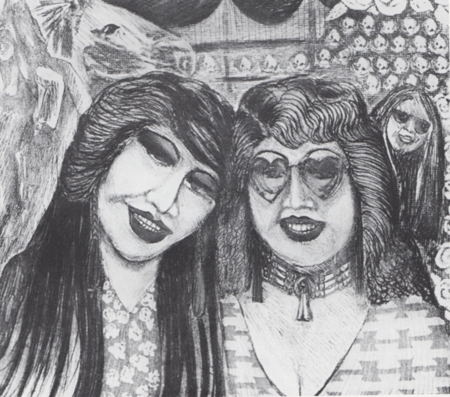
The above are just part of the story. There has long been arts activity beyond nonprofits. In her 2005 book There's Nothing Informal about It: Participatory Arts Within the Cultural Ecology of Silicon Valley,41 published by Cultural Initiatives Silicon Valley, Maribel Alvarez chronicled amateur, folk, commercial, and avocational arts.42 In the new millennium, Silicon Valley's cultural ecology was changing rapidly with immigration: the white population became a minority, displaced by a massive population of emigrants from India, Taiwan, Vietnam, and Mexico.43 At the same time, new systemic disparities in formal education and income levels would increasingly present both opportunities and challenges in social, economic, technological, and government realms. At a forward-looking event in 199544 at the Euphrat, the Arts Council under new director Bruce Davis applauded the "arts as an intervention for social ills,"45 connecting arts with government, schools, youth, veterans, social services, and prisons. Presenters included a county supervisor, a judge, and arts/community leaders from Menlo Park and East Palo Alto to Gilroy. "We had to run two sessions!" Davis recalled. Counsel, Advocacy, Support
What kept innovators going even in the face of personal attacks, political maneuverings, and endless barriers put in their paths by resistant administrators, colleagues and institutions? This brings me back to Consuelo Santos-Killins. Ruth Tunstall Grant and I both sought seasoned perspectives from Santos-Killins. She possessed insight and understood the unique value of new ventures. As she battled cancer for five years, Santos-Killins continued her wide-ranging activism, firing off letters to top policymakers. Grant and I, like many other arts advocates, faced incredible struggles. Grant: "One gets beat up. You think you know the answers; but after a while, you are not sure anymore." Even on our worst days and hers, Santos-Killins could be counted on. Good advice and support were gifts she brought to so many who struggled to build the arts and art education systems we have today.
Advocacy was another gift of Santos-Killins. Advocacy, little heralded or discussed, is a well-worn term with levels of meaning. The advocacy I laud and refer to here includes speaking up for people, ideas, and/or organizations in a public letter or at a public meeting.46 None of the blossoming could have happened without supporters, from a key trustee to a bold city councilmember or a few visionary county and state policymakers like Santos-Killins, to donors, board members, students, volunteers, brainstormers, barnstormers, activists, collectors, companies, and educators in other disciplines with fresh perspectives.47
Protect the Child, Ruth Tunstall Grant, c. 2004. Acrylic and spray paint on canvas, 5'x8'. From the series entitled, Breaking the Chain of Abuse. An enlarged reproduction became a section of the Japantown Mural Project (2012-2013), a community project by rasteroids design and the City of San José Public Art Program to celebrate an historic San José neighborhood. Art by 50 local artists, more than 60 large panels of color, covered chain-link fencing surrounding barren land, once San José's maintenance yard, and 100 years ago, one of San José's first Chinatown settlements known as "Heinlenville."
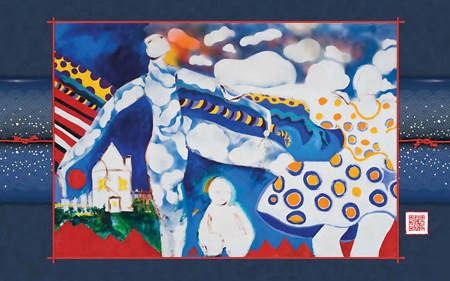
The New Millennium: Business, Democracy, Change
Today, our traditional cultural, educational, and media institutions, so important to our democracy, are challenged by new technologies and a changing economy that demand new business models. Daily newspapers search for successful ways to develop and monetize their online product. Educational and cultural institutions participate in online and other technological changes, adapting through private funding and unusual collaborations. As we sort out what is gained or lost,48 we have examples of new "alternative-alternative" organizations forging the trail, such as Silicon Valley De-Bug, with whom I worked often. This media, community-organizing, and entrepreneurial collective coordinated by Raj Jayadev has an expanded reading of art, information, and democracy as its basis.49
Abraham Menor, The Art Of War, 2009. Digital print. B-boys (breakdancers) presenting their skills at San José's largest b-boy/b-girl event. Menor has worked with Silicon Valley De-Bug and photographed a hidden Silicon Valley for years.
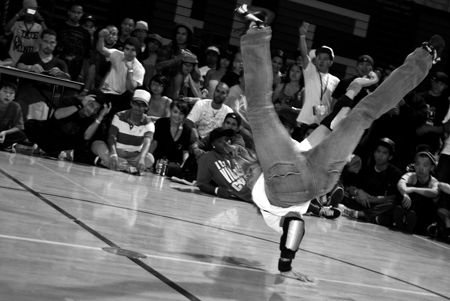
An open door in the arts plays an ongoing role in democracy; this is even more important today as we see exclusion continue in many ways. In News in a New America (2005), Sally Lehrman of Santa Clara University describes the "invisibility" of people and ideas in journalism and new media, emphasizing how access to information about each other is essential for our democracy. It is this same communication that is at the core of the arts. However, many people do not think of arts organizations and institutions as being essential for our democracy. "Invisibility" of people and ideas in the arts precludes exchange of information about each other. Jeanne Wakatsuki Houston reminded us of that recently in The Manzanar Lesson: Telling our stories strengthens democracy50 in which she urges people to tell their stories, experiences, and perspectives because "democracy depends on it."51 In 2004, Euphrat Museum spotlighted Titus Kaphar's Visual Quotations series,52 drawn from classical paintings illustrating one version of the founding of our country. Kaphar only painted the African American(s); the rest of the scene is white, leaving a disjointed figure(s). Kaphar wanted viewers to consider the individual represented, to see "a people of dignity and strength, whose survival is nothing less than miraculous," bringing the visibility issue to light. Have things changed in Silicon Valley's contemporary arts environment? Yes and no.53 We can see a lasting breakthrough in MACLA, which has an inclusive community vision that has brought dimension to South First Street in San José. Technology-oriented ZER01 and its Garage, and the San José Museum of Quilts and Textiles have become crucial anchors for the SoFA District arts community. Silicon Valley De-Bug boldly plows new ground. More Work to be Done
Some 50-plus years from the March on Washington for jobs and justice, so much community-building work remains. Does discussion about an "open arts community" really exist in our local academic world and cultural institutions? Much of Silicon Valley academia has dropped the ball in terms of providing a center for cohesive, open discussion, let alone a base for support, in part because funding cuts have exacerbated academic departments' territorial tendency to focus on their own bread-and-butter programs. Thus art departments tend to be insular, with other fields—women's, gender, and cultural studies, humanities, or other social and physical sciences—filling in where needed. Our local cultural institutions suffer from similar problems and financial vulnerability.
Moreover, even institutions grown in opposition to exclusion can, by defining themselves narrowly or through unconscious prejudicial behaviors, continue exclusion by class, educational level, discipline, or background. It is so easy to separate ourselves. In terms of visibility and participation, clearly more work needs to be done—with arts at the table—across all sectors, including with at-risk youth populations, low-income neighborhoods, threatened environments, out-of-whack justice systems, and out-of-balance boardrooms focused only on a myopic bottom line. It remains difficult to develop or discuss the region's integrated art history within its ongoing context. Recognition provided through random, selective awards and obituaries typically fails to provide a coherent, integrated appreciation or understanding. One local artist labels the drag on any art scene as "selfishness, contentment, lack of desire to do the hard work." I have suggested that we take action to extend and document the arts forum across cultures, disciplines, and sectors and include the role of arts roots, startups, and offshoots. In order to do this, we need a local archive or a locus of discussion, yet no central historical record is available online. Advancing previous cross-disciplinary and cross-sector initiatives without a clear place to start an examination of past efforts is especially challenging. We need ongoing attention to build on the contributions of our diverse forerunners. Too often websites are not archived and disappear. Cultural Initiatives Silicon Valley, Nbari Art, and Arts Council Silicon Valley (ACSV) sites no longer exist. Major institutions like ACSV (now Silicon Valley Creates, 2013) and SJMA have not given web attention and context to pioneers and change agents like Ruth Tunstall Grant. One option could be a multi-year, interdisciplinary campus and/or community project, with an annual published essay related to the meaning or practice of "the spectrum of the arts in Silicon Valley." Such a project would open doors, collaborate across disciplines and sectors, and connect side history with mainstream history. An accessible, ongoing web presence would be an essential element, combined with the involvement of students doing related research, documentation, and projects (including drama or other arts forms) on individuals, organizations, and/or concepts. Gathering and Flourishing
Juan Felipe Herrera, our California Poet Laureate, performed his poetry on April 4, 2012 at the Dr. Martin Luther King, Jr. Library, accompanied by jazz musicians. "Good words. Good hearts," he said. His poem, Let Us Gather in a Flourishing Way, speaks to us all. "Let us gather in a flourishing way… Let us gather in a flourishing way," he intoned with the drums. Ruth Tunstall Grant nodded when I mentioned the glowing experience to her. "Flourishing. One has no idea what will grow. But it needs to be face-to-face, not Facebook," she said.
Let us, then, learn from the various elders and all those who have worked "in a flourishing way." Face-to-face conversations and stories are the start of an ongoing gathering of the thoughts and experiences of some of our artists/activists who have contributed creatively to the blossoming of Silicon Valley. I have introduced some of them, presented a context of Silicon Valley community building, raised questions, and suggested actions for research, documentation, and discussion. But this essay is just the beginning. I invite you, the reader, to offer your perspective and to fill in the blanks in an appendix, available later on www.janrindfleisch.com, so we can recognize and give context to more key artists, organizations, and others who opened up new doors. Knowledge of the past will inform our dialogue as we move forward. Let us build upon their experiences to create a truly vibrant arts community in Silicon Valley. FOR FURTHER READING
San José Art History to 1985
Artist/educator Roberta Loach, Los Altos, published the quarterly magazine Visual Dialog, from 1975 to 1980, with essays, interviews, reviews and columns, expanding women's role in connecting Silicon Valley arts with Bay Area and national arts and arts activism. In 1979 and 1987, artist/professor Marcia Chamberlain published the Irregular Gazette, "a once in a while publication of the SJSU Art Department," an opportunity to think about and understand women's contributions, cultural diversity, and entrepreneurship. 1987 articles brought forward emerging artists, the art and humanism of Dorothy Liebes, and the future for CADRE Laboratory, fiber, and foundry programs. The ambitious A Celebration of 100 Years of the Department of Art, 2013, Natalie and James Thompson Art Gallery, refocuses on the SJSU art department's past to "tie to larger cultural and social movements" of today, but creates a sense of a more diverse and diversity-welcoming past academic cultural climate than existed. Importance of Archives For understanding the making of art history and the times, including local activism, see Staying Visible, The Importance of Archives, Jan Rindfleisch, 1981, exhibition publication, Euphrat Museum of Art. Foreword by Paul Karlstrom, West Coast Area Director, Archives of American Art, Smithsonian Institution. Commentaries included Michael Bell, Registrar/Cataloguer, Oakland Museum of California. Eleven articles involved researchers from various institutions concentrating on individual artists, all women, with a focus on putting material into archives. Karlstrom, Bell, and others brought project insight, guidance, and support, particularly important in our early critical days of discovery.
This essay would not have been possible without discussions and insight from Nancy Hom, Ruth Tunstall Grant, Judy Goddess, Laurel Bossen, Lucy Cain Sargeant, and Tom Izu, with additional assistance from Consuelo Jimenez Underwood, Mary Parks Washington, Gen Pilgrim Guracar and Connie Young Yu, Ann Sherman, Bruce Davis, John Kreidler, Michael Bell, Thomas Rindfleisch, Janet Burdick, Samson Wong, and many artists and activists mentioned in this essay, and unmentioned, with whom I spoke.
1In addition to arts organizations, including San José Symphony, Pacific Peoples Theater, and Institute for Arts and Letters at San José State University, Santos-Killins served two antipoverty agencies, as well as the Santa Clara County Mental Health Association and Friends of Guadalupe River Park. 2
The local contemporary art scene was then anchored by the academic/exhibiting centers of Santa Clara University, Stanford University, and San José State University (SJSU), augmented by the new community colleges, and by art associations, centers, leagues, guilds, societies, estates, and clubs usually of a regional nature, such as Los Gatos Art Association, or related to a specific arts medium. 3
In 1875, The Art Association, as it was then named, was formed in San José, with their first exhibition in 1876 at the Normal School (now SJSU). 4
First de Saisset Director Joséph J. Pociask, S.J. (1955–1967), in 1958 presented a prescient solo exhibition of Paul Hau, who had recently arrived from China and was teaching at the Pacific Art League in Palo Alto, then known as the Palo Alto Art Club. Directors Brigid Barton (1978–1984) and Georgiana Lagoria (1984–1986) gave early opportunities and critical exposure to women. Santa Clara University, a Jesuit institution, and the de Saisset Museum, which includes both art and history components, have been in a unique position to join arts, interdisciplinary and social justice programming, and discussion of values and ethics. 5 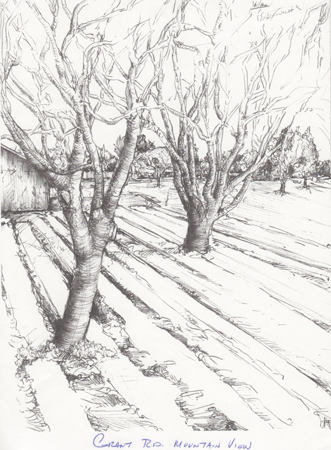 Carol Marschner Malone, Grant Road Mountain View. Marschner Malone has drawn/painted our evolving Silicon Valley; in the '80s, she chronicled old Cali & Bro. on Stevens Creek Boulevard, the Olson Orchard in Sunnyvale, St. Leo's Church in San José, guys playing Pac-Man. 6
The ethnic distribution in Santa Clara Valley during the 1970s could be generalized as follows: an overwhelmingly white population (94% in 1970); a small black population (in contrast to 61% in neighboring East Palo Alto in 1970); a sizable Latino population in areas of Mountain View, Sunnyvale, Santa Clara, and San José; and a small, fast-growing Asian population scattered.
7
Mountain View's Community School for Music and Arts began in 1968 with volunteer teachers; their first art education contracts with the Mountain View School District came in 1981. Support for the arts was so low in Cupertino that, in a budget crunch, high school art teachers told me administration wanted to let some of them go and have physical education teachers teach their art classes. 8
De Anza College's Euphrat Museum for years faced the constant threat of having its already truncated space turned into a computer lab. Before my directorship, in 1978, Proposition 13 resulted in the elimination of funding for the Euphrat, which had been supported by Community Services; about two-thirds of the original museum had already been converted to classroom space.
9
The major arts organizations included Stanford Museum of Art (established 1891, reopened in 1999 as Iris and B. Gerald Cantor Center for the Visual Arts after completion of revival begun in 1963), Montalvo Center for the Arts (1939), de Saisset Museum (1955), Triton Museum of Art (1965), and San José Museum of Art (1969 in former city library, 1991 new wing). 10
During my term as Euphrat director, I crossed paths with two San José mayors who stood out as supporters of the San José Museum of Art and of the arts in general: Janet Gray Hayes (1975–1982) and Susan Hammer (1991–1999). While Hammer built a solid arts support record and inspired a 10-year cultural plan for Silicon Valley, she also personally connected with local artists and collected their work. 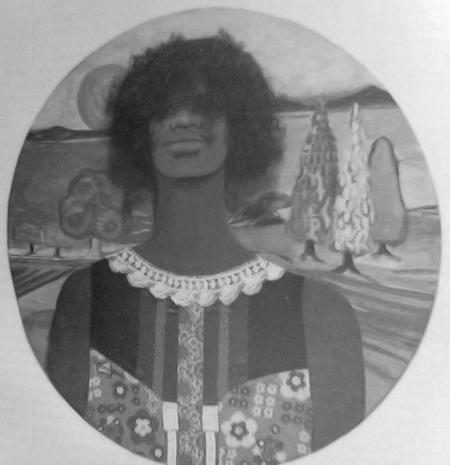 Marie Johnson Calloway, Sun Circle. Mixed media, 3' diameter. Collection of Mayor Susan Hammer. Photo: Helen Fleming. 11
The Janson text (1973 edition) said José Clemente Orozco and "a group of young painters" in Mexico in the 1920s and '30s, inspired by the Mexican Revolution, often overburdened their works with ideological significance. Orozco was identified as the artist "least subject to this imbalance." The text made no mention of iconic artists Frida Kahlo or Diego Rivera, who would have lasting international impact, he with provocative murals, she with piercing self-portraits. 12
Most of us were aware of artist/activist Judy Chicago (Through The Flower, 1975; premiere of Dinner Party, 1979, at San Francisco Museum of Modern Art) and, to a lesser extent, of artist/activist Carlos Villa (Other Sources, 1976, San Francisco Art Institute, symposium, events, publication, exhibitions of artists working on the "shadow side" and margins of the mainstream Bay Area art world).
13
Art historian Lucy R. Lippard inspired many of us, e.g. with From the Center, 1976. Bettelheim referenced Lippard's "Making Something from Nothing (Toward a Definition of Women's Hobby Art)," in Heresies, Winter 1978. Lippard described how women look at the objects in their physical environment and use them for their own creative goals. Bettelheim's dissertation on Caribbean street masquerades and her training in African art history also led her to greater understanding of the vast scope of art in our country.
14
"Does Sex Discrimination Exist in the Visual Arts?" Eleanor Dickinson and Roberta Loach, Visual Dialog, Vol. 1, No. 2, 1975-76. The U.S. box scores at the time for numbers of men (M) and women (F): group invitationals—M 1324, F 699; one-person shows—M 1421, F 38; Oakland Museum collection—M 413, F 119. Females made up 75 percent of students in U.S. art schools in 1971. Other statistics Dickinson and Loach researched and reported compared degrees, faculty, reviews, acquisitions, and gallery representation.
15
The marginalizing of "women artists" encouraged aberrant behaviors. Some women ignored or laughed off demeaning male behaviors, sexual innuendo, trivializing of ideas. Some fought back.
In the mid 1970s, a local sculptor and university arts professor exhibited a college art gallery full of his nude female bronzes, shown bound and gagged, prostrate and laid out. The academic gallery context offered the students elevated interpretations. Instead of accepting them, a Silicon Valley cartoonist Gen Guracar created a cartoon panel about standing up to such demeaning content. In the first cell, the male artist is shown sculpting a bound woman. But in subsequent cells, the female sculpture comes to life, jumps up full of anger, throws off the bindings and mouth gag, grabs the hammer and chisel, and chases the sculptor out of the studio. I saw the cartoon years later and applauded the cartoonist's spunk, but my basic question at the time was: What are we teaching?
For the arts to function in support of community and democracy, one needs freedom of expression and an educated populace, not rebuked and marginalized citizens.
16
Many experienced ongoing exclusion. In 1985, writing The First San José Biennial essay for SJMA, I noted the minimal ethnic representation overall. The biennial exhibitions did not give a sense of our ethnic mix nor in any way reflect the unique experiences of major portions of our population.
Overall, progress came with visionaries like Helen Jones, dynamic from her wheelchair. In 1980, Jones, head of De Anza's Physically Limited Program, proposed the exhibition To Deny the Right of Any Person is to Deny Our Own Humanity, revolving around related art and needs. For context, Oakland's Creative Growth, the oldest and largest art studio in the world for people with disabilities, only began in 1974.
Exclusion in the early 1970s extended to veering from the mainstream. Web designer Marte Thompson reminded me of Bill Martin, the legendary visionary artist who taught at SJSU in 1973-74, and Michael Whelan, a student there at the same time, who became a celebrated science fiction book cover illustrator. "In those years, representational painting was frowned upon by mainstream art, and these artists, and any instructors, notably Maynard Stewart and Dr. Raymond Brose, were ostracized for their insistence on teaching what is now called 'classical realism.'"
17
The large organizations' advances were often limited to Women's History Month or Black History Month. Topping the social/economic/academic hierarchies of collecting and validation, these institutions emphasized established artists and were often quite removed from basic life experiences of most artists.
Inclusion is not a simple matter of numbers or demographics or just working with the community you have, regardless of makeup. The question/crux is how we see ourselves in the world, how we understand underlying racism, sexism, and other forms of oppression, and what that means to us as individuals, a people, and a country.
18
Not long after, books like Women Artists: Recognition and Reappraisal from the Early Middle Ages to the Twentieth Century, Karen Peterson and J.J. Wilson, 1976, were published. The descriptive title highlights a long-standing conundrum; we are not "women artists" but artists. The same issue is raised by Black Artists on Art, Samella S. Lewis and Ruth Waddy, 1970. (Lewis founded the Museum of African American Art in Los Angeles in 1976.) 19
Villa (1936-2013) for decades developed diverse, thought-provoking programs at San Francisco Art Institute, nurtured students, connected with other artists and activists on a broad scale, and challenged the mainstream art world through exhibitions, conferences, and symposia.
20
Chocolate Hearts at Berkeley's Fiberworks (founded 1973) consisted of candy boxes where each "chocolate" was a portrait of a family member or ancestor, presenting black experience and history seldom seen in a "mainstream" art gallery. Howard and I reconnected in 2011 when she created a Blue Bottle House temporary public artwork in front of Palo Alto City Hall, almost a stone's throw from where three decades earlier we had visited the small international art colony of painter/actress Marjorie Eaton. 21
The Power of Cloth: Political Quilts, 1845–1986, was based on the national research of two other Silicon Valley quilt enthusiasts, Jane Benson and Nancy Olsen. The exhibition included an unknown artist's Underground Railroad quilt, c. 1860, supporting the abolitionist cause, and contemporary artist Faith Ringgold's The Purple Quilt, inspired by author Alice Walker. 22
Artist Tony May taught an Art in the Community class at SJSU for decades and created collaborative public art projects, such as a large umbrella memorial to San José community activist and spiritual leader Father Mateo Sheedy. May gave a group of us a ceramic fish from his temporary public installation Milagro de los Pescados. Many of May's students brought new dimensions to art and community. Hawaii-based artist Lonny Tomono, schooled in Shinto temple restoration in Japan, collaborated on a spiritual tree house with May. Artist Margaret Stainer developed the Ohlone College gallery in Fremont over three decades; she researched part of our Staying Visible publication, 1981. Valerie Patton, who went on to teach in the prisons, commented: he [Tony] could "get [us] past the pomp and circumstance of art to genuinely and spontaneously respond to ideas … a subversive force within the college art department … offer[ing] the alternative of an exploration of conceptual art…. Some of [the] temporary artworks produced collectively by students (and other collaborators) were this artist's best legacy of all." 23
"Art Wars" T-shirts memorialized the late '70s conflicts and growing pains. Works/San José and some others have good basic organizational histories on their websites.
24
Artist Ruth Tunstall Grant served on the first boards of Works and the Arts Council of Santa Clara County. She spearheaded Hands on the Arts, a multicultural arts festival that became Sunnyvale's signature event, soon going on its 30th year. She pioneered the San José Museum of Art studio art programs in city schools in the mid 1980s and wrote a winning grant for the seed money. Convincing the museum director to start this amazing outreach program to impoverished areas was not an easy sell for Tunstall Grant. She was uniquely able to develop unusual new programs and offshoots within the mainstream system, and also to start an arts nonprofit from scratch.
25
On national and state levels, various government programs utilized artists and gave them a taste for public service. Those with local impact included the federal CETA program employing artists in hospitals, prisons, and other public service (1973–1982), and California Arts-in-Corrections in the state prisons (1982-2003). The latter began in the '70s as the vision of Eloise Smith, the first California Arts Council Director, and her spouse Page Smith, founding provost of Cowell College at University of California Santa Cruz and activist for the homeless in Santa Cruz. 26
Solis helped found MACLA (Movimiento de Arte y Cultura Latino Americana) in 1989, and chaired Multicultural Arts Development, 1987-95, when on the San José Arts Commission. At the Santa Clara County Office of Human Relations (OHR) since 1997, she has been in charge of Community Relations and the Commission on the Status of Women; has created community projects that combine arts, culture, and human rights; and, with OHR and Human Relations Awards, has publicly honored similarly minded individuals and organizations. 27
In the coming decades, Hau would become very popular with an influx of Chinese into Silicon Valley who know and buy his work. But Hau's personal reach was always cross-cultural. Only two of the first ASACA members were Chinese. Connie Young Yu highlighted Hau in her 1986 book Profiles in Excellence: Peninsula Chinese Americans, published by the Stanford Chinese Club (1965) for their 20th anniversary. She did not gloss over how unfriendly some Palo Alto residents who did not want to have a Chinese family as neighbors were to Hau. 28
YLEM explores the intersection of the arts and sciences and considers the impact of science and technology on society. YLEM grew in part from the Graphics Gatherings spinoff from the Homebrew Computer Club at Stanford, but with broader reach, and exposed artists and public to research work through public forums, exhibitions, and field trips. 29
SJSU Professor of Art Marcia Chamberlain initiated the CADRE Project (Computers in Art, Design, Research, and Education) and served as first Project Director for the CADRE 1984 conference, papers, and publication. With eight satellite exhibitions, numerous YLEM members participated. 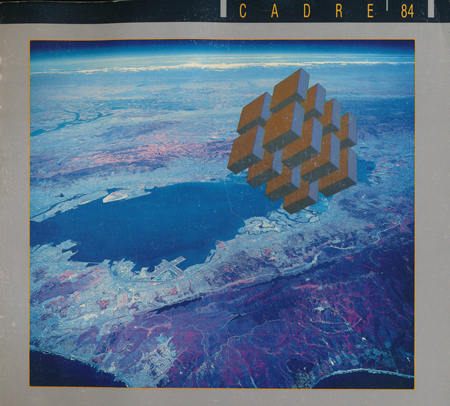 CADRE 84 cover. Logo design by Mary Sievert. Chamberlain also instituted SJSU's fiber arts program. Joel A. Slayton became CADRE director in 1988, and I would work with him again after he went on to direct ZERO1, the Art and Technology Network, founded in 2000. 30
For women, support would come from maverick female art historians, like Moira Roth at Mills College; from Stanford's Center for Research on Women (later name changes), which would also collaborate on the early Djerassi Resident Artists Program (1979) in Woodside; and cross-disciplinary campus groups that organized women's history months. Cultural support would come from campus departments, such as Intercultural Studies and a range of social sciences and language arts, along with historical societies, sororities like Links Inc., churches, and community organizations like Mid-Peninsula YWCA in Palo Alto. 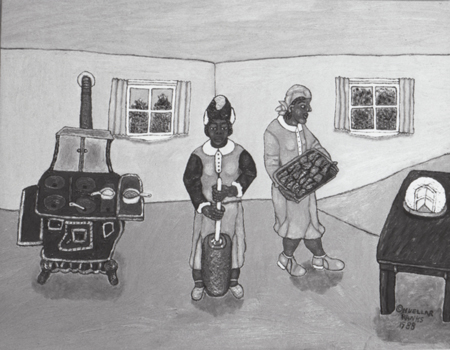 Huellar Banks, Milk Churning, 1988. Oil on canvas, 22"x27". For over 30 years, artist Banks, an East Palo Alto resident, painted childhood remembrances after spending her days cleaning houses. Her art was recognized by the Mid-Peninsula YWCA and Stanford's Institute for Research on Women and Gender. Community activists were supportive in general. Science- and technology-related arts were often orphans, but had energetic core supporters in specific areas. Early computer graphics were highlighted in the '80s by Bay Area ACM/SIGGRAPH, a local chapter of the Association of Computing Machinery/Special Interest Group for Graphics. A former Stanford research scientist, Penny Nii spanned two worlds in her 1986 Building Blocks quilt to celebrate the 30th anniversary of the field of Artificial Intelligence; created the Penny Nii Art Quilt Gallery in Mountain View and curated an exhibition at NASA Ames in the 1990s; then delved into book art 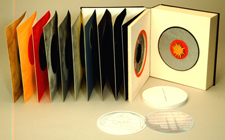 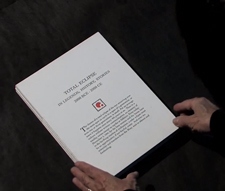 Nii's Totality (left), 2001, led to Totality (right), 2012, a Digital Over Analog (D/A) book Nii created with Mohammed Allababidi and Enrique Godivia, game animators and app developers. D/A books "straddle the world of the book (analog) and e-readers (digital)." 31
The Euphrat was founded as the Helen Euphrat Gallery in 1971 by way of a bequest and the vision of E.F. and Helen Euphrat. In 1978, as a result of Proposition 13, funding was cut to essentially zero. We began building the unique college/community partnership with a forum concept around 1980. With the expertise of art historian Patricia Albers, then director of special programs, we became the Euphrat Museum of Art in 1992. Given the meager and spotty remuneration, we would never have survived and succeeded in the early 1980s without the creativity of artist Kim Bielejec Sanzo, assistant to the director, and support from district trustees Franklin Johnson, Dr. Gerald Besson, and Dr. Raymond F. Bacchetti, the latter two serving on the first Euphrat board. The Euphrat board would grow, champion innovation and help build programs, outreach, and the new museum building, most unusual for a community college. 32
We worked on exhibitions and publications with award-winning illustrator and SJSU professor Alice (Bunny) Carter and Sunset magazine illustrator Lucy Cain Sargeant (later instructor at SJSU). These women were all business. Carter wrote about the client/illustrator process in designing a Star Wars game cover; she would become a legend in building the sought-after Animation/Illustration department at SJSU. Sargeant guided multiple Euphrat publications. There were people who "got it," and could speak up. For our exhibition FACES, 1984, we connected with vocal LaDoris Cordell, Superior Court Judge, Santa Clara County, 1982-2001, at the forefront of social justice; she understood the connection with art. Mary Andrade created a vehicle for art in 1978 as co-founder, co-publisher of the bilingual La Oferta, the oldest continuous Latino publication in San José. Andrade, an artist/activist and expert on Day of the Dead altar traditions, and I would discuss the importance of art in building community. I was overjoyed to exhibit her tender 1985 photograph, Juana Chavez, of Cesar Chavez's mother crocheting. Andrade's early photography and interviews of local elders inspired Ethnic Community Builders, 2007, by Francisco Jiménez, Alma M. García, and Richard A. García, about the struggle for citizenship rights in San José. 33
For decades, much of the art world was still distancing itself from communication and content. To quote art historian Moira Roth: "…the Aesthetic of Indifference was a more potent and dangerous model for the 1960s. It advocated neutrality of feeling and commitment in a period that otherwise might have produced an art of passion and commitment." We cited Roth's 1977 "Aesthetics of Indifference" essay in our publication CONTENT: Contemporary Issues, 1985. 34
For the book cover Peretz Wolf-Prusan, printmaker and calligrapher, created Ancient Religious Symbols—crescent, earth mother, pilgrimage of the soul, menorah, Vesta, and Russian-style cross. 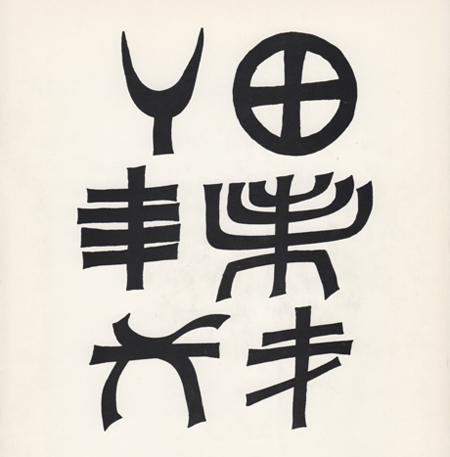 Wolf-Prusan's chapter treated the revival of the Ketubah, or Jewish marriage contract, an art form with calligraphy. Calligraphy of various spiritual traditions was also passed over by modern art institutions. (Fortunately Steve Jobs happened upon a Zen calligraphy class and developed a new way of seeing.) We all lost when the art world distanced itself from spiritual or philosophical issues, from exploring a range of shared core values and the accompanying questions and dialogue. How did we lose these essential connections? Investigations of fundamental human concerns occur, say, in a good literature class. The arts should play an equally important role in these universal inquiries. 35
The '80s were full of building up one's own organization and connecting with other organizations for support, at a time when government arts structures were still being built.
For example, the Arts Council of Santa Clara County started in 1982, but their focus in the '80s was on funding the "big five" arts organizations in San José. From around 1985–1988, smaller groups met monthly, often at the Euphrat, for the Arts Alliance, an Arts Council advisory group. Even when I was appointed to the Arts Council in 1988, it took a while to get smaller organizations on their radar. I met with Peter Hero, head of the Community Foundation, who understood the concerns, but said small organizations needed to "wait their turn." Meanwhile we, along with other small organizations, worked with Business Volunteers for the Arts, a new Arts Council program (1985–1986).
Also, just to get attention for the arts, people needed to start city arts commissions. With some Euphrat board members, we initiated the establishment of the Cupertino Art Commission in 1986-87. Cupertino City Council didn't approve it the first time, so we made our case again. We also worked with the City of Sunnyvale on decade-long exhibition programming at the Sunnyvale Community Center. We struggled to work with our three very different Silicon Valley cities, Cupertino, Sunnyvale, and Los Altos, each with their councils, commissions, and staff. 36
Nothing was easy. To build Euphrat art education partners and just nominal low-income program funding required long city council meetings and working with skeptical city staff. To reach families and communities, we developed ongoing programs with school districts, again with nominal funding. During the '80s we worked with faculty, staff, and school district trustees of the Fremont Union High School District and Cupertino Union School District. Among other things, we started FUHSD student shows to bolster the case of the beleaguered high school arts programs. We formed a Euphrat Board Art Education Committee, and later partnered with the SJSU art education department so we could train new graduates in community work. In the early years, partnerships were a hard sell, yet all came to enjoy the new programs and accolades that followed. With their experience, consultants Ruth Tunstall Grant and Maribel Alvarez brought a wealth of ideas to our education program and vision of a diverse arts community, including understanding of the needs of underserved populations and at-risk youth. We saw progress with the idea that responsive regional governments, schools districts, and others could partner with the arts to benefit their constituencies; that everyone, all ages, had a stake in the arts; and that there were special arts needs in some sectors, e.g., low-income. A breakthrough came in 1989, when the Euphrat was the site for a press conference sponsored by the Community Foundation, Santa Clara County Arts Council and National Endowment for the Arts to announce the creation of a major new endowed fund for small to mid-size arts organizations in Santa Clara County. While these grants were small, as were state grants from the California Arts Council, they made a difference. Recognition from a good peer review process was a prized accomplishment and critically important for small organizations pursuing diversified funding with corporate and individual support. 37
Apple supported and participated in many early Euphrat Museum exhibitions, and the Euphrat created art exhibitions in numerous Apple buildings: An extension of 1984's FACES with Luz Bueno, using Via Video System One; Lili Butler's dramatic larger-than-life sculptures, The White One and The Black One, in Apple's main lobby in 1985, the year of the Steve Jobs/Apple board clash; and 36 artists from our 1988 Art of the Computer exhibition, with works from a broad spectrum of research, artistic and commercial computer graphics. Euphrat placed exhibitions at Hewlett Packard and Tandem Computers, also. We organized an event with sculptor Bruce Beasley at the home of Hewlett Packard VP Joel Birnbaum. VPs from Hewlett Packard, Apple, and Tandem served on our Euphrat board. Steve Jobs saw the art in all he built, so I add a few thoughts about art, design, and money. Regis McKenna, whose advertising firm marketed Apple computers, chose designer Rob Janoff to create the iconic Apple logo, originally drawn by Carlos Pérez, in1977. McKenna credits artist Tom Kamifuji, Palo Alto, with inspiring the rainbow look. 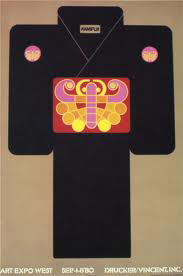 Kamifuji's bright-colored, bold kabuki silkscreen posters were hot items, and we included him in our 1981 Commercial Illustrators Show. Three decades later, in 2007, we enjoyed working with McKenna when Steve Yamaguma Associates designed our lively new Euphrat logo and we prepared for our impressive new building facing Stevens Creek Blvd. In 2011, Steve Jobs presented Cupertino City Council with designs for Apple's new circular headquarters farther down on Stevens Creek. I was at city hall that night because of annual city budget deliberations. We spoke briefly, and I wish it had been about art; we had recently completed our Learn to Play exhibition about games. But Jobs was on his last legs with terminal cancer. "Everyone needs money," he said. 38
José Antonio Burciaga (1940–1996), artist, poet, and writer, and Cecilia Burciaga (1945-2013) were Euphrat Museum board members in the early 1990s. Our intense discussions about art, education, and exhibitions took place around their Casa Zapata dinner table. Together they guided and mentored hundreds. Chon Noriega describes the strategic and the magical. Regarding the particular courage of Cecilia Burciaga, professor emerita Amalia Mesa-Bains, former head of visual and public arts at Cal State Monterey, said in a Monterey Herald obituary: "If things were unjust, unfair, not right, Cecilia would take up the cause and she wouldn't back down until the problem was fixed. I would consider her one of the people who most embodied the movement toward justice."
39
Regarding traditional arts with a dispersed population, in our early efforts to connect and learn, we featured Pomo basketry and Mabel McKay in 1982, included Central Coast baskets from the collection of local historian Austen Warburton in our CROSSOVER technology exhibition in 1982, and presented Art of the Bear Dance, A traditional Spring ceremony of the Maidu Indians in 1984. In 1986 the Muwekma Ohlone Tribe constructed a tule house for the de Saisset Museum, and subsequently contributed to public art projects, such as the Ohlone/Muwekma Tribute along the Park Avenue Bridge in Guadalupe River Park & Gardens. More recently at the de Saisset Museum, Director Rebecca Schapp has overseen renovation of their California History exhibition and a new iBook, which focuses on the history of Santa Clara from pre-European contact. 40
Underwood is attuned as Latina, Chicana, and Native American. Many of her weavings honor the indigenous Yaqui, whose homelands were cut open by the U.S-Mexico border. She was one of our "tell-it-like-it-is" board members.
41
Published by Cultural Initiatives Silicon Valley, the book was the result of a second study commissioned by John Kreidler. As Executive Director of Cultural Initiatives Silicon Valley from 2000-2006, Kreidler worked to implement a 10-year cultural plan for Silicon Valley. In 2004, CISV commissioned cultural anthropologist Dr. Pia Moriarty to examine informal performing arts groups in local immigrant communities (Immigrant Participatory Arts: An Insight into Community-building in Silicon Valley). CISV's final project, Medici's Lever, 2009, was an online suite of two games and one simulation laboratory probing regional cultural policy. One of the games is entitled SJ Renaissance. For more information see interview or go directly to Medici's Lever. 42
For a larger context, artist/faculty member Carlos Villa was the organizer and producer of "Sources of a Distinct Majority," a series of four heated symposia at San Francisco Art Institute, 1989–1991, that upped the pace of moving past stale structures. The publication Worlds In Collision, drawn from the symposia series, includes "diverse concerns of artists, activists, academics and street scholars from both ethnically marginalized and mainstream communities throughout the country. These four symposia, organized around issues of multiculturalism, education, identity politics and the role of the arts in contemporary culture, became venues for intense dialogues with broad implications for rethinking the relationships around cultural theory and activist agendas. The nearly 90 participants collectively and collaboratively explore strategies for a progressive art agenda that reflect a more accurate American Art History." I participated. It was invigorating to explore new strategies collectively. The concurrent Global Cultures, the 1990 Congress of the Arts, Los Angeles, described California: "Its successes and failures at managing the issues posed by ethnic diversity and interdependency with the global economy are a proving ground for the rest of the world." While I didn't attend, the event, sponsored by California Confederation of the Arts, helps understanding of context. Subtitled "A Challenge for the 1990s," this pragmatic gathering centered on government, business, foundations, and the arts, and included a mini-conference on "Art and Disabilities." 43
To give an idea of demographic changes, in 2000 the ethnic makeup of the county was roughly 54% white, 2.7% black, .7% Native American, 28% Asian or Pacific Islander, 24% Latino. In 2010 the three largest population groupings changed to 35% white, 32% Asian or Pacific Islander, and 27% Latino.
44
Also in October 1995, a public meeting on multicultural exhibition collaborations was held in San José. As Joe Rodriguez (then of the San José Office of Cultural Affairs) put it, the purpose was "to identify issues relevant to collaborations between San José-based multicultural arts groups which lack exhibition spaces, and visual arts organizations with space to house exhibitions."
45
With a welcome by County Supervisor Dianne McKenna, the two panels included Santa Clara County Superior Court Judge Tito Gonzales, East Palo Alto City Councilwoman Myrtle Walker, and artist/educator Ruth Tunstall Grant. Arts Council director Davis worked with an arts/activist staff that understood grassroots: Diem Jones, Lissa Jones, and Audrey Wong. 46
Consuelo Santos Killins spoke up in multiple ways. She promoted Northern California on the CAC, which has been dominated by Southern California. At a CAC meeting in 1989, Killins wanted to serve "all the people of California," and stated, "This is the last time I'm going to vote to fund applications for large-budget organizations unless board of directors' makeup starts to change radically." Advocacy normally isn't "speaking to the choir;" there is an element of activism, standing up to power on behalf of individuals. One of our Euphrat board members, Judy Goddess, used to work on "Individual Advocacy" for parents and kids having problems with public schools. She relates the joy of "bringing a system around to give a service a kid deserves." Where would we be without such advocates for the arts, education, for the marginalized, for those in need? This advocacy can also arise with active participation in a commission, nonprofit, or startup group. 47
Countywide, Adobe supported graphics grants. Applied Materials supported "Excellence in the Arts." Under director Bruce Davis (1994-2011), Arts Council Silicon Valley made great strides in helping fund diversity, increasing seed funding to small and mid-sized organizations. 48
MACLA and ZERO1 with its biennial festival have hit the big leagues. Cultural Initiatives Silicon Valley (1996-2006) inspired by Mayor Susan Hammer, a leader in regional cultural planning, brought movement on cultural policy and art education. Then 1stACT Silicon Valley, 2007, a high-end, five-year hybrid, leveraged a "network of networks" for leadership, participation, and investment in art, creativity, and technology. Silicon Valley Creates, 2013, is a merger of the Arts Council with 1stACT, with multiple programs. Enlightened government is a boon to cultural life, when it's lucky to have someone like Barbara Goldstein, San José Public Art Director, 2004-2013. I worked in recent years with Goldstein on the City Hall Exhibitions Committee, with Ruth Tunstall Grant from the Arts Commission serving as chair. One of our first exhibitions in City Hall connected art, history, and research, with a spotlight on artist Mary Parks Washington and ties to the local African American community going back to the 1800s. 49
SV DeBug works with artists with a keen understanding of community, such as Adrian Avila and Charisse Domingo, and has looser affiliations with artists like Abe Menor, an "at-risk" youth case manager and a community organizer/worker, who has for years photographically documented social and political movements and a hidden Silicon Valley, and Sam Rodriguez/Shorty Fatz, builder of collaborations that range from inspiring public art and community mural projects to small businesses in custom bikes and the art of street wear. SV DeBug offers a study opportunity, food for discussion, for classes in political science, criminal justice, journalism, and business, showing how the arts can be part of solutions. In 2014, SV DeBug won an Office of Humans Relations Award for justice work and contributing to our community fabric. 50
San José Mercury News, 5/12/12. Also Houston's memoir on the WWII internment of Japanese-Americans (Farewell to Manzanar, 1973) was one of five books anchoring a 2012 yearlong initiative by Cal Humanities (formerly the California Council for the Humanities) to create opportunities for Californians to explore the nature and needs of our democracy. 51
Nationally, Americans for the Arts has a special program Animating Democracy aimed at cultivating a landscape for creative social change and fostering civic engagement through arts and culture. Democracy came up repeatedly in Euphrat exhibitions. Freedom Views: 1991 featured a large Four Freedoms installation about freedom and responsibility by artist/educator Deborah Kennedy. 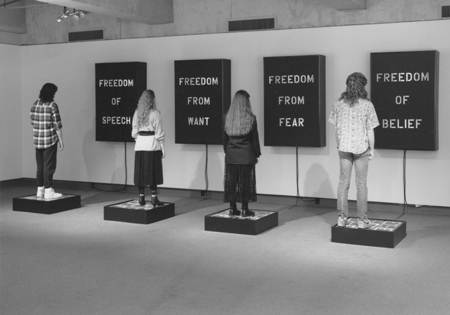 Deborah Kennedy, Four Freedoms, 1991. Mixed-media installation for exhibition Freedom Views, 1991 For In the Public Eye: Beyond the Statue in the Park, 1990, Thomas Marsh and anonymous students shared their Goddess of Democracy sculpture fashioned locally after the one used in the Tiananmen uprising in China. A long time ago, a student asked me about the meaning of a small printed word that was part of a large collage sculpture. The word was "apartheid." I think over the years of the ideas presented in artworks. Through art we have learned in unique, unexpected ways of the Tuskegee Airmen, lynching, the Nanjing Massacre, the Cherokee Trail of Tears, refugees, very short people, mental illness, AIDS, the paper bag test ("If your skin was lighter than a paper bag tacked on the door, then you could enter."), the I Hotel, gentrification, gender issues, bullying, human trafficking, the Chinese Exclusion Act, Manzanar, global warming, veterans issues, high student loan debt, extinction of native languages. Artists are often bellwethers of hidden trouble spots, human rights and social justice work, focusing on life that others have passed by or swept aside. That is what I mean when I say that art can be grounding. 52
Euphrat Edges exhibition. In referencing Emmanuel Leutze's George Washington Crossing the Delaware (1851), the African American appears disjointed — a head, part of an arm, half of a leg. Kaphar calls attention to the secondary roles African Americans played in a composition, that artists used formal devices, such as "light vs. dark, up vs. down, to visually reinforce institutionalized views of race and hierarchy." Kaphar, BFA from SJSU, MFA from Yale, focuses on alternative history. Priscilla Frank, Huffington Post, 7/2/12: "Kaphar cuts and shreds, he erases and whites out, he rumples, sews and paints in tar. … There is rebirth in the residue."
53
Nationally, there have been articles about the advances and alterations in curricula and strategies, e.g., in the women's movement, including the controversy that can surround change described by Susan Faludi in American Electra (Susan Faludi, "American Electra, Feminism's Ritual Matricide," Harper's Magazine, 10/2010). The National Museum of Women in the Arts reveals even in 2013, even with over half the visual artists today being women, only 5% of the art on display in U.S. museums is by female artists.
The field of arts-based community development has grown substantially, and William Cleveland states: "Many of the ideas that were considered radical fruitcake in 1977 can be found in the guidelines of many funders." Cleveland has produced arts programs in educational, community and social institutions, including leadership of California's Arts-In-Corrections Program and the California State Summer School for the Arts, and has written extensively on arts-based community development.
For the updated version of this essay, visit www.gingerpressbooks.com to purchase the book. Appendix: A Selected Timeline of Arts and Cultural Development in Silicon Valley
First posted April 2015, updated February 2017.This appendix gives a selected timeline of arts activism and cultural development in Silicon Valley. To give additional context for arts and community building, it focuses on key individuals who moved beyond the mainstream and worked communally to expand the conversation and breadth of opportunity for those sidelined. A few examples of the destruction of culturally significant places, structures or artworks are also included for context. The timeline is not comprehensive, and any amplification, refinement, and dialogue about it are welcome. At the end of the timeline is additional art and historical context with a list of organizations.
c.1100
Kuksu ceremonial pendants
made of red and black abalone
shells are found in archaeological
sites in downtown San José and
CA-ALA-329 in Coyote Hills,
Fremont. Jewelry is one example
of the long history of Ohlone art.
1844
Juana Briones purchases the
4,400-acre Rancho la Purísima
Concepción in the Palo Alto
foothills from two Mission Santa
Clara (Clareño) Ohlone men and
brings her vision to the land:
a hilltop home for her family
with an architecturally rare
construction. A humanitarian
and initiator of creative spaces,
she builds community, models
freedom and courage, and
advances opportunities for
women.
1873
Purchase of three marble
sculptures created by artist
Edmonia Lewis, who identifies as
African American and Ojibway/Chippewa and works out of
Rome in a neoclassical vein.
The Friends of San José Library
purchases Bust of Lincoln. San
José leader and suffragist Sarah
Knox Goodrich purchases
Awake
and Asleep. Lewis is the first
internationally known artist to
come exhibit in San José.
1875–1876
Art Association is formed in San
José. The first Art Association
exhibition is held at the Normal
School, now San José State
University (SJSU).
1887
Arson demolishes San José's
Market Street Chinatown (one
of five in the city). Within weeks,
the site is voted for San José's
new City Hall.
1891
Stanford Museum of Art is
established (revival in 1963).
1917
Hakone Estate and Gardens,
designed and built by Isabel
and Oliver Stine, is established.
Inspired by the 1915 Pan-Pacific
Exhibition, Isabel Stine travels to
Japan. Upon seeing Fuji-Hakone
National Park, she retains
architect Tsunematsu Shintani
and landscape gardener Naoharu
Aihara to build her own Hakone
Gardens in Saratoga.
1921
Pacific Art League is founded
in Palo Alto (founded as Palo
Alto Art Club; name would be
changed in 1984).
Late 1920s
Artist/actress Marjorie Eaton
initiates a family-like arts colony
in Palo Alto built around the stage
Juana Briones set at her home on
the hill. The colony flourishes for
most of the century, encouraging
women in the arts and crossing
racial barriers during decades of
de facto segregation in Palo Alto.
(Eaton and her colony would be
featured in a local documentary
video in the 1970s and in a local
publication in the early '80s.)
1930
Muwekma Ohlone language
songs sung by Muwekma
Elder Jose Guzman, the great-grandfather
of Muwekma Tribal
Councilwoman and Language
Committee Co-Chair Sheila
Guzman-Schmidt, are recorded in
Niles. Linguist John P. Harrington
records 27 songs from Guzman,
which are currently housed at the
Smithsonian Institution's Bureau
of American Ethnology.
1938
San Jose Art League established.
1939
Montalvo Arts Center, Saratoga
is established, including the third
artist residency program of its
type in the United States. (Now
known as the Sally and Don
Lucas Artist Residency Program,
it continues to support new
contemporary work.)
1948
YWCA of the Mid-Peninsula
opens as a recreation center
for businesswomen. It expands
to provide recreational and
social services for women that
meet the organization's mission
of "empowering women and
eliminating racism," and exhibits
local artists, including self-taught
painter Huellar Banks from East
Palo Alto. (The organization
would be based in Palo Alto until
its closing in 2003.)
1955
The de Saisset Museum is
established at Santa Clara
University (SCU), covering art
and history; includes Santa Clara
Mission art from the Galtes
Museum, formerly housed in the
basement of O'Connor Hall. (The
de Saisset would develop a focus
on exhibitions exploring social
justice issues.)
1950s and
subsequent decades
SJSU art professor John De
Vincenzi, WWII veteran, is a key
arts and community organizer,
from the San Jose Art League
to the Italian American Heritage
Foundation of San José. He keeps
substantial archives. Atlanta-born
artist/educator Mary Parks
Washington works with De
Vincenzi in expanding the South
Bay's arts vision beyond cultural
barriers.
1965
John De Vincenzi becomes
chair of the Gallery Advisory
Committee to the San José Fine
Arts Commission. The advisory
committee carries out the
planning process for the proposed
conversion of a San José public
library building into a city art
gallery.
Triton Museum of Art, Santa Clara, is founded as first non-university art museum in the county.
1965–1968
Spurred by his volunteer
activities in Mississippi during
1964's Freedom Summer, Frank
Cieciorka, graphic artist, former
SJSU student and activist,
develops the iconic clenched-fist
image of the New Left.
1968
Artist/educator Cozetta Gray
Guinn and her physicist husband
Isaac "Ike" Guinn establish Nbari
Art, a shop and museum-quality
gallery in Los Altos, featuring
imported African art and African
American art.
1969
With a grant from Signetics, artist
Talala Mshuja starts the Nairobi
Cultural Center in East Palo
Alto, which includes classes for
children.
1971
San Jose Civic Gallery (now
known as San José Museum of
Art) opens.
1973
Artist Mary Jane Solis and
activist Adrian Vargas (founder/director of San José's Teatro de
la Gente, 1967–1977) co-found El
Centro Cultural de la Gente, the
South Bay's first Chicano/Latino
cultural center, in downtown
San José. El Centro features
exhibitions; art programs; Lorna
Dee Cervantes and her Mango
Press; performance by Teatro
de la Gente; and Luis Valdez, the
father of Chicano theater. [Solis
would serve as gallery curator
(1973–1976) and mural program
manager (1978–1981). El Centro's
first staff member Elisa Marina
Alvarado would later go on to cofound
Teatro Visión, where she
continues as artistic director to
this day.]
Painter Paul Pei-Jen Hau and Mary Hau open the Chinese Fine Arts Gallery in Los Altos. Emphasizing performing arts, PJ and Roy Hirabayashi found San Jose Taiko and collaborate to revitalize San José's Japantown, one of only three Japantowns left in the country.
1974
Artist Gen Guracar, Mountain
View, organizes dozens of women
for the valley's first large-scale
quilt project,
The People's
Bicentennial Quilt.
1975
Visual Dialog, a quarterly
magazine with essays, dialogs,
reviews, and columns, edited by
artist Roberta Loach, Los Altos,
first appears. The publication
challenges discrimination against
women.
1976
Historian Connie Young Yu writes
The People's Bicentennial Quilt:
A Patchwork History a book
telling the story behind each quilt
square. [First edition, UP PRESS,
East Palo Alto, 1976; revised
edition, Saratoga Historical
Foundation, 2010.]
Mid- and Late 1970s
SJSU faculty member Jessica
Jacobs leads artists in developing
city exhibition space with broader
representation and more freedom
than the now "established" SJMA.
Jacobs and a number of her
students pioneer the first modern
art galleries in San José, starting
with Merz Gallery (later to be
replaced by Wordworks).
On the Peninsula, First Generation—Deanna Bartels (now Tisone), Betty Estersohn and Joan Valdes—use new video technology to explore and document Bay Area art, including that of artists Marjorie Eaton and Bea Wax. Consuelo Santos Killins directs Pacific Peoples Theater and begins three decades of activism—with the San José Fine Arts Commission, California Arts Council, Santa Clara County Arts Council, SJSU's Institute for Arts and Letters, Santa Clara County Mental Health Association, and Friends of Guadalupe River Park. She pushes for substantive school and community arts programs and more diverse participation across the board. Artist Anthony Quartuccio paints a mural above the altar of Holy Cross Church (1906) in an early Italian immigrant area of San José. (It would be lost in a fire in 2015.)
1977
San Jose Museum of Quilts & Textiles opens in Los Altos,
the first U.S. museum to focus
exclusively on quilts and textiles
as an art form. (It would be
essentially a collaborative,
volunteer organization for its first
two decades.)
Professor Diane Middlebrook becomes director of Stanford's Center for Research on Women (CROW, founded 1972). [In 1979 Professor Dr. Carl Djerassi would found the Djerassi Resident Artists Program. Initially administered through the art exhibition program of CROW, he and Middlebrook would establish an independent, comprehensive program by 1982. CROW would later become the Institute for Research on Women and Gender (1983), with exhibitions at Serra House, and still later, Clayman Institute for Gender Research (2004).]
1978
Nairobi Cultural Center moves
north to San Mateo County.
Photographer Mary Andrade creates a vehicle for art as co-founder, co-publisher of the bilingual La Oferta, the oldest continuous Hispanic publication in San José.
1979
With Paul Pei-Jen Hau as its
guiding spirit, artists and friends
found the American Society for
the Advancement of Chinese Arts
(ASACA).
Euphrat Art Gallery (1971), De Anza College, is resurrected after funding loss from Proposition 13, differentiated by an unusual vision of collaboration across cultures and disciplines. Jan Rindfleisch, director, develops a unique college/community partnership that produces innovative, vibrant museum programming for over three decades. (Gallery becomes the Euphrat Museum of Art in 1992.)
Early 1980s
Poets Juan Felipe Herrera and
Margarita Luna Robles organize
poetry readings in downtown and
East San José, and at the Euphrat
Gallery.
Artist Ruth Tunstall Grant directs and expands the children's art school at the San José Museum of Art, initiating art classes in underserved city schools. San José State University professor José Colchado creates murals, working with youth in the East Side Union High School District and Janie Perez, director of the Barrio Leadership Training Program (later known as East Side Youth Center). Activist artist Julia Iltis creates artwork for political posters. Stop the Repression! (1982) commemorates the fi nal speech made by Monsignor Oscar Romero, Archbishop of San Salvador, the day before his 1980 assassination. Guilty of the Gospel promotes a 1984 presentation in honor of four U.S. women missionaries martyred in El Salvador in 1980. (Both would be added to the Oakland Museum of California's All of Us or None Archive in 2010.)
1980
Mythili Kumar founds Abhinaya
Dance Company, teaching and
performing Bharatanatyam, a
South Indian classical dance.
1981
In Palo Alto, artist Trudy Myrrh
Reagan starts YLEM: Artists
Using Science and Technology
to exchange ideas, explore the
intersection of the arts and the
sciences, and consider the impact
of science and technology on
society.
Jan Rindfleisch, Lucy Cain Sargeant and Kim Bielejec Sanzo create the Euphrat exhibition and publication Staying Visible: The Importance of Archives; foreword by Paul J. Karlstrom, West Coast director, Archives of American Art, Smithsonian Institution. The pivotal project focuses on women in the arts, featuring multiple interviewers and authors.
1982
Arts Council of Santa Clara
County is established.
1984
SJSU art professor Marcia
Chamberlain organizes the
first Computers in Art, Design,
Research, and Education
(CADRE) conference and
publication, and becomes the
first director of SJSU's CADRE
Laboratory for New Media, an
interdisciplinary academic and
research program dedicated
to the experimental use of
information technology and art.
1985
Cecilia and José Antonio Burciaga
become Resident Fellows living
at Stanford's Casa Zapata—she
as a top university administrator,
he as resident artist, both
working closely with student
and community needs. [For the
next nine years, José (aka Tony,
Toño) would create murals at
Casa Zapata, use comedy to
attack racism and narrow divisive
thinking, and publish poetry and
writings.]
Jeanne Farr McDonnell starts the Women's Heritage Museum, with a focus on California history and culture. (To create a larger organization, in 1997 it would become the International Museum of Women.) The Dr. Martin Luther King, Jr. Association of Santa Clara Valley inaugurates the Freedom Train on Martin Luther King, Jr. Day. The train travels the 54 mile– Caltrain route from San José to San Francisco to approximate the distance of the historic 1965 civil rights march from Selma to Montgomery, Ala. led by Dr. King to spur passage of the Voting Rights Act. (The group will organize the annual event for the next 30 years.)
1986
While serving on the Arts
Council of Santa Clara County,
Ruth Tunstall Grant initiates
Hands on the Arts as an Arts
Council project. (The all-day
children's art festival would
become a joint venture of the Arts
Council and the City of Sunnyvale
the following year, and beginning
in 1988, an annual city event.)
Activist Connie Young Yu, longtime promoter of the art of marginalized Chinese and Chinese Americans, highlights renowned painter Hau Bei Ren (Paul Pei-Jen Hau) in her book Profiles in Excellence: Peninsula Chinese Americans, published by the Stanford Chinese Club. Rick Sajor and Margarita Luna Robles convene "The Arts Lobby" to increase Latino representation on the San José Art Commission and to monitor policies in the arts locally and regionally.
1987
Consuelo Jimenez Underwood
(Huichol, mestiza), Cupertino,
begins teaching at SJSU. (She
would develop and head the
textile department for over 20
years, simultaneously illuminating
indigenous and hybrid cultures
and border issues.)
Salwa Mikdadi Nashashibi,
Lafayette, founder and director
of International Council for
Women in the Arts, participates
in a Euphrat Museum exhibition
and publication on refugees. (She
would later co-author Forces of
Change: Artists in the Arab World,
the catalog for an unusual 1994
traveling exhibition of artwork
by contemporary Arab women
sponsored by Nashashibi's
organization.)
San Jose Multicultural Artists Guild is formed from Maiko Women's Poetry and Drum Ensemble, Tabia African American Theater Ensemble, and Teatro Familia Aztlán, with executive director Arlene Sagun. (Venues would include social service agencies, battered women's shelters, juvenile detention facilities, Juneteenth and Kwanzaa celebrations, plus academic and community sites for Dia de los Muertos arts exhibitions. Mary Jane Solis would curate their Day of the Dead exhibitions from 1986– 2013.) Dr. Jerry Hiura chairs San José Arts Commission (SJAC) and appoints Mary Jane Solis chair for Multicultural Arts Development (1987–1995). Almost 92% of grant allocations in the mid-1980s goes to six large-budget institutions, such as the San Jose Symphony, San Jose Cleveland Ballet, and SJMA.
1988
Joel A. Slayton is named director
of CADRE Laboratory for New
Media.
1989
Artists Betty Kano of Berkeley
and Flo Oy Wong of Sunnyvale
found the Asian American
Women Artists Association
(AAWAA) in the Bay Area to
"promote the visibility of Asian
American women artists," who
lack recognition even in their own
traditional culture. Local artists
Terry Acebo Davis and Dawn
Nakanishi participate.
Maribel Alvarez, Mary Jane Solis, Rick Sajor and Eva Terrazas envision arts programming as a vehicle for civic dialogue and social equity and found Movimiento de Arte y Cultura Latino Americana (MACLA) in downtown San José. Multicultural Arts Action Group (MAAG), led by two MACLA board members, Rick Sajor and Sonia Gray, with representatives from existing multicultural arts groups, is established to encourage more civic support for small organizations meeting different cultural needs. After the Northern California Chapter hosts the 1989 Women's Caucus for Art (WCA) National Conference, artists Ruth Waters and Marta Thoma develop Peninsula and South Bay chapters. [The South Bay Chapter would become Silicon Valley Women's Caucus for Art (SVWCA) in 2014.]
1990
Under Mayor Janet Gray Hayes,
the City of San José establishes
the Office of Cultural Affairs
(OCA) to work with the San
José Art Commission. Yankee
Johnson becomes its Director
(1990–1999).
1991
SJMA opens a new wing.
Mayor Susan Hammer (1991–1999) appoints the Mayor's Task Force on Multicultural Arts Development and issues the "Vision 2000 Report" to address immediate needs of the growing diverse multicultural community and its artists. Mexican Heritage Corporation is founded, the first and only multicultural arts organization to be considered a "major institution" by the City of San José. In its first year, MHC establishes the Mariachi Festival in San José.
1992
The Multicultural Arts Incubation
Pilot (MAIP) becomes a national
model for supporting the
development and stabilization of
multicultural arts programming.
Artist Joe B. Rodriguez, arts
program manager (1990–2011)
for the OCA, implements the
program. (Between 1992–2004,
the city would invest and secure
federal, state, and foundation
grants totaling over $1 million
for Arts Incubation initiatives.
Thirty MAIP graduates would
generate $3.2 million of new
revenues by the end of their third
year, creating arts-related jobs
and enhancing local economic
potential.)
Ruth Tunstall Grant founds Genesis / A Sanctuary for the Arts in San José with exhibitions, presentations, performing arts, and artist studios, bringing together different cultures at three locations—Ryland Street, 40 North First Street, and The Alameda—with Claude Ferguson as artistic director. (At the Alameda site, she would renovate and build studios in a warehouse that is now The Alameda Artworks studios. Tunstall Grant also would develop the art program for foster youth at the Santa Clara County Children's Shelter.) The Association for Viet Arts is founded by Hoa Trinh Glassey and Man Bui to foster excellence in Vietnamese-American performing, visual, and literary arts. AVA is the first nonprofit Vietnamese arts organization in the Bay Area. Chike Nwoffi ah starts Oriki Theatre, Mountain View, to provide a shared experience of authentic African culture, from recreating an African village to school programs and seasonal productions. In East Palo Alto, Bart Decrem founds Plugged In, one of the nation's first digital-divide programs. The Muwekma Ohlone Tribe reclaims the arts of naming and installation. Tamien Station, an intermodal passenger transportation station in San José, is named after the valley and tribal region which the Spanish priests recorded as Thámien when they founded the first site of Mission Santa Clara de Thamien in 1777. Tamien Station is named to honor the ancestors of the Muwekma Ohlone after its construction uncovered a major ancestral heritage archaeological site containing around 172 ancestors. (A planned permanent exhibition of artifacts found on the site has not yet been constructed.)
1995
The Arts Council, under new
director Bruce Davis, convenes
a forward-looking countywide
event to applaud the "arts as
an intervention for social ills,"
connecting arts with government,
schools, youth, veterans, social
services, and prisons. Director
Davis (1994–2011), working
with Diem Jones, Lissa Jones,
and Audrey Wong, expands
the Arts Council's community
importance and increases seed
funding to small and mid-sized
organizations.
Working with Muwekma, Amah-Mutsun and Esselen Nation Costanoan/Ohlone tribal communities, artist Jean LaMarr creates a mural (restored in 2013) The Ohlone Journey, located in Ohlone Park in Berkeley, which celebrates Ohlone life and culture on four walls. The local Muwekma Ohlone Tribe, led by chairwoman Rosemary Cambra, uses performance art, academic research, language revitalization, and public art to build community.
1996
Cultural Initiatives Silicon Valley
(1996–2006) is inspired by Mayor
Susan Hammer, a leader in
regional cultural planning. The
initiative advances cultural policy
and art education. [Executive
Director John Kreidler
(2000–2006) would implement a
10-year cultural plan for Silicon
Valley, and produce two major
publications on participatory
arts with Pia Moriarty (2004)
and Maribel Alvarez (2005). Arts
Council of Santa Clara County
would later be renamed Arts
Council Silicon Valley.]
1997
David Yohn (Ojibway), executive
director, and Diane Way (Lakota/Cheyenne), artistic director,
start ABLEZA: Native American
Arts and Media Institute in San
José. Exhibitions are held at the
American Indian Center, part
of the Indian Health Center off
The Alameda, a long-standing
community gathering point.
(ABLEZA programming would
include a 1999 virtual art
exhibit entitled Honor and Pain,
juxtaposing computer-rendered
photos of traditional powwow
dancers with sports mascots and
images on commercial products.)
Mary Jane Solis initiates an extended period highlighting arts programming in conjunction with her work in community and public relations at the Office of Human Relations, Santa Clara County.
1999
Mexican Heritage Plaza, a
cultural center built with San José
Redevelopment Agency funds,
opens in San José.
2000
ZERO1, the Art and Technology
Network is founded by Andy
Cunningham. (Joel A. Slayton
would serve as director, 2008–2016.)
2001
Silicon Valley De-Bug, a media,
community organizing, and
entrepreneurial collective
coordinated by Raj Jayadev, is
established in San José. Part
of SV De-Bug's core group,
community artists Adrian Avila,
Charisse Domingo, and Jean
Melesaine, would tackle projects
with photo-essays and videos.
Diane Way becomes the first Native American artist to win the Literary Fellowship in Playwriting from Arts Council of Silicon Valley. In addition to her visual art, Way taught script writing and oral tradition at SJSU and Stanford.
2003
MACLA is recognized in 2003
by Cultural Initiatives Silicon
Valley as Santa Clara County's
"most practiced and mature site
of cultural-citizenship-building
through participatory arts."
2004
Jianhua Hsu establishes the
Silicon Valley Asian Arts
Center in Santa Clara, offering
exhibitions of local and Chinese
art, seminars, music recitals,
publications, art education and
community fundraising events.
Mid-2000s
Self-taught muralist Frank Torres
makes positive impact on gang
infestation through community
collaborations: murals at Pop's
Mini-Mart, Payless Shoes store,
the visitors' room at the Santa
Clara County Hall of Justice,
and the Elmwood Correctional
Facility (Elmwood's history).
2008
Empire Seven Studios and
Gallery is founded by Juan Carlos
Araujo and Jennifer Ahn in San
José's Japantown, as "a beacon to
underground art culture in the
South Bay."
Content Magazine, The Innovative and Creative Culture of Silicon Valley, is started by Daniel Garcia, Cultivator.
2011
Activist Tina Morrill starts Art
Box San José, a community-driven
project depicting art on
utility boxes.
The Juana Briones House, a key link to a woman who was a California change-agent in multiple fields, is torn down. A careful deconstruction occurs, both to salvage materials and to preserve a section of wall that shows its unusual construction.
2013
Juan Carlos Araujo and Jennifer
Ahn establish the E7S Mural
Project in San José to promote
community murals.
2014
Raj Jayadev writes an essay
about De-Bug's approach and
philosophy: "The Anatomy of an
'Un-Organization': Explaining
#DebugScience."
2015
Exhibition District is a nonprofit
established to paint 40,000 sq.
ft. of blank space in downtown
San José. Organized by local
muralist Erin Salazar, the plan
is a follow-up to work done by
muralists like Paul J. Gonzales
and Phuong-Mai Bui-Quang. (ED
murals completed to date include
Labor of Love, a tribute to the
working men and women who
built the valley on the side of the
Workingman's Emporium on N.
First Street, and Life Abundant in
the Face of Imminent Death, on
the Hotel De Anza.)
Artists Robin Lasser, Trena Noval, and Genevieve Hastings create Our Lives in This Place at the request of the city. The project is part of Envision San José 2040 planning for "urban villages" such as East Santa Clara Street from Seventh to 17th Street. Community members are brought together and voice ideas to make the neighborhood more interesting. "Imagine" postcards featuring these ideas are created and circulated via a kiosk that travels the neighborhood. 2016 Bay Area Society for Art & Activism develops a timeline for the Bay Area's history of art and media activism: http://artandactivism.org/timeline/.
2017
For the Women's March in
downtown San José, about
30,000 people marched for civil
rights, many wearing handmade
pink "pussyhats," in diverse,
intergenerational groups. As
part of a global awakening and
rededication, they spoke up
through words, music, attire,
and artful signs about concerns,
values, and hope.
For additional information pertaining to the greater San Francisco Bay Area: See the digital archive/wiki FoundSF.org; docspopuli.org, a digital archive of protest and advocacy artwork of the 20th century; and Women Eco Arts Dialog, promoting ecological and social justice art. Art and Historical Context: For more information about mid–20th century San José area arts development, starting with artist/activist John De Vincenzi and including the Arts Council Silicon Valley (1982), see Rindfleisch, Jan. Essay. First San José Biennial. San José Museum of Art, 1986. For subsequent context and discussion, starting with community activist Consuelo Santos Killins and artist/activist Mary Parks Washington, see Rindfleisch, Jan. "Roots and Offshoots: The Blossoming of Silicon Valley's Art Community." Californian Vol. 37 (October): 5–15. For information regarding arts activity beyond nonprofits, see Alvarez, Maribel. There's Nothing Informal about It: Participatory Arts Within the Cultural Ecology of Silicon Valley. Cultural Initiatives Silicon Valley, 2005. Large organizations that served as historical markers The early local contemporary art scene The scene was anchored by the academic/exhibiting centers of SCU, Stanford University, and SJSU, augmented by the new community colleges, and by city arts commissions, other organizations, art associations, centers, leagues, guilds, societies, estates, and clubs usually of a regional nature, such as Los Gatos Art Association, or related to a specific arts medium. Some of these are listed below to give a larger feeling of the Silicon Valley art scene as it developed. Other larger arts or related organizations: The TechMuseum of Innovation: 1978 idea of Junior Leagues of Palo Alto and San José, resulted in "the Garage" in the former convention center on San Carlos Street, 1990; "The Tech" relocated in a new building on S. Market Street, 1998. Children's Discovery Museum (1990) 1stACT Silicon Valley (2007–2013): leveraged a "network of networks" for leadership, participation, and investment in art, creativity, and technology. Silicon Valley Creates (2013–present): a merger of Arts Council Silicon Valley with 1stACT Silicon Valley, with multiple programs. Office of Cultural Affairs, City of San José Office of Human Relations, Santa Clara County Specialty historical museums: Rosicrucian Egyptian Museum (1929; 1966 new museum), San José History San José (activities began 1949, managed by city; incorporated 1998) with African American Heritage House, Chinese American Museum at the Ng Shing, Greenwalt House (Museum of the Boat People and Republic of Vietnam), Portuguese Historical Museum at the Imperio, and more. California History Center Many Silicon Valley cities have their own historical organizations and museums. Alternative arts organizations and endeavors open to emerging artists: Los Gatos Art Association (1948 first discussions) Smith Anderson Gallery (1969): begun by Paula and Phillip Kirkeby in Palo Alto. Palo Alto Cultural Center (1971) Gallery 9 (Menlo Park in 1970, moved to Los Altos in 1973): a cooperative gallery. Works/San José (1977): a community art and performance center inspired by Tony May, was an offshoot of Wordworks, inspired by Jessica Jacobs. The latter continued until it morphed into SJICA. San José Institute of Contemporary Art (SJICA) (1980): a member-supported, nonprofit organization committed to presenting visually compelling and conceptually challenging contemporary art. dp Fong Gallery (1989–2007), San José. Frederick Spratt Gallery (1993–2006), San José. Anno Domini//the second coming of Art and Design (2000): a San José–based collective of artists and cultural entrepreneurs created by Cheri Lakey and Brian Eder. Primary organizers of South First Fridays Artwalk and Art Market. Art Boutiki and Gallery (2001): comics store, art gallery, and live music venue in downtown San José. Heart of Chaos Artisan Collective/Catalyst for Youth (2002): founder/executive director Joanne Hobbs Kaleid Gallery (2006): an offshoot of San José's Phantom Galleries (a project exhibiting art in vacant storefronts & alternative spaces). Over 60 fine artists and designers from the San José area make use of a 6,000-square-foot retail space with individual exhibits in a variety of media. Art Ark Gallery (2006) on the Art Ark Apartments property: an artisan village in the heart of San José's Martha Gardens Arts District, featuring the work of local artists in one-person shows and group exhibitions. Gallery coordinator, Valerie Raps (2006–present). CreaTV San José (2007): a member-based, nonprofit community media center that helps the residents, businesses, schools and organizations in San José to effectively communicate their message to a broader audience using our public and education television and Internet channels. Seeing Things Gallery (2012): downtown San José Other arts-related events and organizations: Tapestry in Talent Festival of the Arts (1976–2009; 2011) Silicon Valley Open Studios (1986): a free annual event allowing the public to visit Peninsula and South Bay artists' studios is established. Downtown Doors (2003): an art competition and outdoor exhibit for middle and high school students produced by the San José Downtown Foundation. Luna Park Arts Foundation: organizers of the annual Luna Park Chalk Art Festival, San José Arts organizations dedicated to particular media: Bay Area Basketry Guild (1984), Judé Silva and Maxine Kirmeyer founders. Citadel Print Center (1987), Glen Rogers Perrotto, Betty Bates. Bay Area Book Artists (1995) Bay Area Glass Institute (BAGI) (1996) Orchard Valley Ceramic Arts Guild (2000) Private independent arts organizations and events: PreNeo Press Anne and Mark's Art Party (2007) Bill Gould's annual exhibition event at Artik Art and Architecture, curated by Kathryn Funk M. Lee Stone Fine Prints (1976): focus on WPA and Depression era, social commentary, Chicano artists, industrial and cityscapes, and labor themes. A Spiral Through Time: Silicon Valley Arts and Culture from Ancestral Ohlone to Today
This article, first posted here in June 2015, has been revised and is now a transitional essay in the book Roots and Offshoots, Silicon Valley's Arts Community. A towering, sleek bus glides between its passengers' homes in culturally sophisticated metropolitan San Francisco and their work places in Silicon Valley, a region constantly reinventing itself with tilt-ups, office parks, and campuses for the latest Google wannabe. It's helpful to have a sense of our diverse historical roots, as well as the forces of change and new ideas, as we ponder Silicon Valley's unique cultural development. This article will look back 10,000 years to the ancestors of today's Ohlone Indians and consider their long and ongoing history; then examine the stories of 19th century pioneer Juana Briones and last century's Marjorie Eaton. The investigation will provide an informative and provocative temporal bridge that spans from early Native American cultures to the contemporary local community and art stars like Consuelo Jimenez Underwood. The ability of these resourceful and generous women to honor indigenous heritage, draw from different sources, and shape new creative environments has left a timeless legacy. Building and sustaining a vibrant, innovative system of arts and culture in Silicon Valley has always started with engaging newcomers and transcending the divisions between art, history, cultures, economics, ethics, and other disciplines. A Natural Weave of Art and Community Life: The Ohlone The exquisite basketry and elaborate adornment of the Ohlone once reflected their lifestyle, which was in sync with nature; their appreciation of the artistic skills of women; and their social stratification, with a well-decked out, finely feathered elite. The indigenous Ohlone people hunted, fished, and harvested a diversity of plants and seeds. They created fiber art with materials derived from the natural world and sustainable architecture, such as a tupentak roundhouse that could accommodate 250 people. They wove baskets for leaching acorn meal, cooking, fishing, and winnowing grain; as well as for storing ornaments of abalone, cut-and-drilled beads from Olivella shells, and complex feather dance regalia. 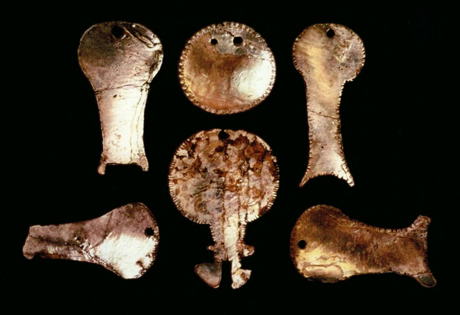
Photo: Joe Cavaretta (Muwekma Tribe) Kuksu ceremonial pendants, c. AD 1100, from CA-ALA-329 in Coyote Hills, similar to those found in downtown San José made of red and black abalone shells. Certain art forms were owned; jewelry (shell ornamentation and regalia) was associated with status and wealth based upon the family's lineage and ranking in the community. Other art had to do with shamanic visions and ceremonial religious performances. The architectural "shellmounds" of Coyote Hills were sacred landscapes, ceremonial burial grounds for nobility—California's pyramids. Once widely known for their fine basketry with geometric designs, Ohlone women lost much of their material and spiritual culture when they labored in the valley's emerging agricultural economy. At Franciscan Mission Santa Clara de Asis, Thamién Ohlone–speaking women turned to weaving cotton clothing, blankets, and carpets for the community. With the establishment of Spanish ranchos and an increasing hide trade, the decimated Ohlone population became a hidden minority, their native way of life increasingly influenced by Spanish/Mexican culture. Their traditional arts often took a back seat to the arts of survival. 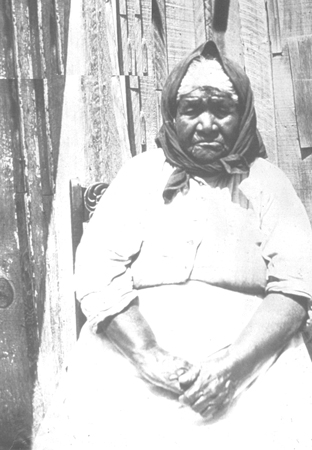
Maria de los Angeles (Angela Colos) , c. 1925, born in the Santa Teresa Hills in San José, at Alisal Rancheria between Pleasanton and Sunol, where her family found refuge. The American conquest of California and the Gold Rush (1849), followed by statehood in 1850, ushered in an extended period in which indigenous Californians were robbed of basic rights and had to hide out for their safety. Angela Colos, born in 1839, daughter of Indians who were married at Mission San José in 1838, was one of the principal linguistic consultants for many anthropologists.1 A fluent speaker of the Chocheño Ohlone language, she shared her linguistic knowledge. Stating that "muwékma" means "la gente (the people)," she also passed along other traditions about the tribe. Her living descendants are enrolled members of the Muwekma Ohlone Tribe of the San Francisco Bay Area, which continues the traditional arts and gives precedence to new art for building community.2 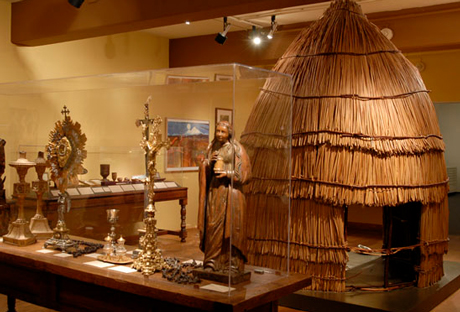
Photo: Chuck Barry, © 2006 Santa Clara University. Installation image, California History from the Permanent Collection exhibition. In 1986, Muwekma Ohlone tribal members and their children constructed a tule house (rúwwa) for the de Saisset Museum. The Museum recently launched its new iPad textbook focused on the California History exhibit and the Mission. Today, we are learning more about how Ohlones have been denied their cultural existence and how their languages and place names were erased, replaced by Hispanic and Anglo ones. Contemporary art historians know well the art of erasure (for example, artist Robert Rauschenberg's Erased de Kooning Drawing) and also what anthropologists call "nominative cartography." Colonial systems have "remade, restructured, and renamed landscapes," literally transforming the map of the San Francisco Bay area. "Mapping Erasure,"3 written by anthropologist Les W. Field with Alan Leventhal, Muwekma Tribal Ethnohistorian, and Rosemary Cambra, elected chairwoman of the Muwekma Ohlone Tribe of the San Francisco Bay Area4, is one of numerous articles in which Leventhal and Cambra describe and counter colonial systems and the widespread art of erasure. For instance, Moffett Field, a former naval air station, is currently a joint civil-military airport whose airfield is leased to Google for 60 years. It is known for its tremendous Hangar One, one of the world's largest freestanding structures. Moffett used to be Rancho Posolmi, home of Lope Yñigo, who bridged three cultures. Born in 1781 in an Indian village near Mission Santa Clara, Yñigo was baptized at the Mission in 1789 and served it from 1789–1839. He was given a land grant to the rancho, where he raised crops and livestock, defended his land grant for over two decades, and resided till his death in 1864. Yñigo was buried somewhere on this land. At Moffett Field, there's no sign of any of this past. Similarly, Stanford lands incorporate former Indian villages, both in their archeological preserve and at Jasper Ridge. In one article5, archeology professor and campus archaeologist Laura Jones describes a place as possibly sacred, because there are tiny holes (cupules) in the rocks, suitable for grinding medicine and pigments used in rituals. She also notes the Ohlone nature friendly style of human organization: "It's extremely effective—and low impact." Yet the Ohlone place names have disappeared from Stanford. A rare exception is Ulistac Natural Area near the new Levi's Stadium in Santa Clara, which may mean "place of the basket" in several Ohlone languages. The Ohlone have reclaimed the arts of naming and installation, having renamed the Tamien Railroad Station in San José. In 1777, Father Tomas de la Peña and an escort of soldiers and settlers arrived at the banks of the Guadalupe River, built an arbor of thatched tule reeds for a temporary shelter, and thus founded the Mission Santa Clara de Thámien. Peña mentioned in a letter to Father President Junipero Serra that the natives called the area of the mission Thámien. Shortly after the mission was founded, the Governor of Alta California, Felipe de Neve, sent instructions to establish a pueblo nearby. Commander Jose Joaquin Moraga of the San Francisco Presidio took a group of settlers and retired soldiers to the Guadalupe River to found California's first civil establishment, El Pueblo de San José de Guadalupe—now the City of San José. After construction of the railroad station uncovered a major ancestral archeological site containing around 172 ancestors, the Muwekma Ohlone renamed it as Tamien Station to honor their ancestors and the memory of the thousands of Ohlones who had lived in Thámien. A permanent exhibition of "artifacts" found on the site has been planned but not yet constructed. Regarding sacred burial grounds and cultural history, the Ohlone now work in a heartbeat alliance with archeologists and anthropologists and use art forms such as performance art, installations, language revitalization, and public art. A close-knit community, the Muwekma employ Internet strategies as well as traditional gatherings. One moving public ceremony occurred in 2010 when a Pacific Gas and Electric Company (PG&E) gas line replacement project within the Mission Santa Clara Indian Neophyte Cemetery required the excavation and then reburial of ancestral remains.6 The reburial honoring ceremony included Native American spiritual beliefs and Roman Catholic religious traditions. Reburial layers interred the remains with associated regalia, sand, church-consecrated objects, and an abalone shell containing purifying sage and mugwort, or estafiate, turned upside down. The ceremony ended with the Lord's Prayer in the Santa Clara (Clareño) Thámien Ohlone language. Noted artist/activist Jean LaMarr (Pit River/Paiute, Susanville), working with tribal members, counters the long-standing erasure of Ohlone presence. With her art, she speaks to the cultural identity and ongoing struggles of Ohlone people living today. LaMarr's 1995 mural (restoration and celebration 2013) The Ohlone Journey, located in Ohlone Park in Berkeley, celebrates Ohlone life and culture on four walls. The westward-facing panel, "Modern Life Transitions," honors individuals who lived in the 19th and 20th centuries, depicting members of indigenous families based on photographs taken over the generations and lent to the artist by their descendant family members. Maria de los Angeles Colos is far left. "The Strong Walk Back to the Future" faces south. In terms of general Native American cultural history and concerns, the Indian Health Center (IHC) in San José has played a basic but significant role while undergoing multiple moves and divisions. The IHC was originally part of the Indian Community Center (ICC), established in 1969. Then it became San José American Indian Center in 1970, a gathering place that provided art exhibition space. At one point it sponsored ABLEZA: Native American Arts and Media Institute, which began in 1997. Muwekma Ohlone visibility has benefited from a more focused multigenerational and multidisciplinary approach of dedicated individuals. "Makkin Mak Muwekma Wolwoolum, 'Akkoy Mak-Warep, Manne Mak Hiswi! We Are Muwekma Ohlone, Welcome To Our Land, Where We Are Born!" Tribal Vice Chairwoman and webmaster Monica V. Arellano keeps the tribe's website updated with current information about activities from ceremonies to academic conferences.7 In spring 2015, Gilbert Martinez, a young active Muwekma tribal member, shared or reposted several pertinent touch points on the Internet. The first of these was a 1930 recording of a Muwekma Ohlone language song sung by Muwekma Elder José Guzman, the great-grandfather of Muwekma Tribal Councilwoman and Language Committee Co-Chair Sheila Guzman-Schmidt, who lived in Niles and the Sunol/Pleasanton rancheria. Linguist John P. Harrington's recordings of 27 songs from Guzman are currently housed at the Smithsonian Institution's Bureau of American Ethnology. The second posting noted the 2015 grand opening ceremony of the new Balermino Park in San José, which the tribe helped name for Ohlone ancestor Robert Antonio Balermino, a Mission Santa Clara Clareño-Thámien (Costanoan/Ohlone) who had been granted the land in 1844. Martinez also shared a link to an article by Stanford PhD student Fanya Becks on Muwekma archeology and ownership of the ancestral past.8 Changing Context: Mission-era Art Regalia and cultural objects, integral to community life, were created and cherished by the ancestral Ohlone people. Subsequently, art and cultural objects in the valley were increasingly created or acquired, displayed, saved, and contextualized by religious, academic, and public institutions with Euro-American roots and global networks and interests. The preponderant system of cultural values changed. In 1851, Jesuits founded Santa Clara College, later known as Santa Clara University (SCU), at the Mission site. Through their permanent collection, SCU's de Saisset Museum of Art and History offers a window to the diversity and global influences of Mission-era art. For example, their textile art collection encompasses opulent vestments from France and Spain (mainly 1650–late 18th century); brightly colored vestments embroidered in China, fabricated in the Philippines and distributed to the missions from Mexico; and somber matte velvet funeral vestments sewn by Ohlone living at the mission. In 2012, the de Saisset curated a historic display of Central Coast baskets and traditional Ohlone arts with select old ecclesiastical vestments from around the world found at the Mission. The two collections complemented an exhibition of contemporary textile art, Beyond Function: Fiber, Fabric, and Finery, with garments that utilize, pay tribute to, and draw from the earlier forms. Personal Freedom and Rich Interaction: Juana Briones de Miranda (1802-1889) Living through the Mission era, the ever-inventive Juana Briones de Miranda set the stage for future cultural development in the valley. Briones was of mixed European, African, and Native American ancestry. Her grandparents immigrated to Alta California to escape a "racial caste system" and a deteriorating economic climate in New Spain (now Mexico). Her mother9 was about five years old when her family came with the De Anza expedition to California in 1776, a year before Mission Santa Clara and the old pueblo of San José were established. Briones was born and spent her early years in the Villa de Branciforte near Mission Santa Cruz, which set the tone for her life, including learning from Indians. When her mother died, her father moved the family to El Polín Springs, near the Presidio in San Francisco. After marrying soldier Apolinario Miranda, Briones and her husband established a farm nearby. Through an archeological project conducted by Stanford University at El Polín Springs, we find early information about Briones' relationships, values, and the pluralistic households she formed with her sisters. Professor Barbara L. Voss writes: "This ethnic pluralism may be reflected in the archaeological materials found at El Polín Springs, which included groundstone, flaked lithics and glass, worked shell artifacts, glass trade beads, and locally-made ceramics along with British-produced whitewares and other imported goods." Voss also provides discussion that gives insight into Briones' changing relationship with a patriarchal Presidio society.10 Briones' history elucidates the ingenuity of successful women at the interaction of cultures. She became a businesswoman, humanitarian, and landowner. She raised eight children, including an adopted Native American girl, studied the art and science of natural healing from Mexican curanderos and her Native American neighbors, aided people in need during the smallpox epidemic, left her abusive, drunkard husband, and started new ventures. She moved her family to what we still know as Yerba Buena (perhaps named for the healing herb tea she used), developed successful cattle and vegetable businesses, and built community through her hospitality and healing as a curandera. The coastal site became increasingly known for celebrations and for meeting potential partners. Reflecting her reputation, it was highlighted on San Francisco's first map as Playa de Juana Briones—later to become the cultural hotspot known as North Beach, home of Little Italy, the San Francisco Art Institute, beatnik subculture, and City Lights Bookstore. In 1844, Briones purchased the 4,400-acre Rancho la Purísima Concepción in the Palo Alto foothills from two Mission Santa Clara (Clareño) Ohlone men, José Gorgonio and his son José Ramon, who then stayed on for years until they had to find safety. The two men had been given the first Native American–owned Mexican land grant after the breakup of the Santa Clara Mission in 1840. Briones developed the cattle ranch and brought her creative vision to the land: a hilltop home for her family with a spectacular view, an architecturally rare type of redwood-and-adobe construction called encajonado, and an east wall arbor of wisteria.11 Briones' rancho also served as an inn for travelers on a route that connected with Santa Cruz. From the wide-ranging art forms of Mission Santa Clara12 to the cultural objects and ways of Ohlone or Chinese ranch laborers and various new immigrants, Briones lived in rich interaction with Mission art and the evolving arts of Ohlone, Spanish, Italian, Mexican, Chinese, and many other traditions. Briones witnessed vast changes in traditional, liturgical, and secular arts. As a businesswoman, she saw the wins and losses in a changing culture and economy and the strains on Indian and Chinese ranch laborers. Here's a partial local snapshot in 1873. Briones would have been 71. In this pivotal year, sculptor Edmonia Lewis, an African American working out of Rome in a neoclassical vein, became the first internationally known artist to exhibit in San José, with the support of San José leader and suffragist Sarah Knox Goodrich. This was two years before the start of the San José Art Association and eight years before an architectural phenomenon—the San José Electric Light Tower (a precursor to the Eiffel Tower), our first grand public art—touted San José as the only electrified city west of the Rocky Mountains. From all over the world, Santa Clara Valley newcomers brought with them cherished artworks, along with pens, brushes, needles, and tools to fashion more, to recreate meaning and cultural familiarity in an alien, sometimes hostile, land. Chinese workers, who lived simply, started with baskets and kites. Later, they were enriched by art in their temple, as well as costumed performances of Chinese opera in their large theater, a colorful blend of living art and architecture. However, anti-Chinese sentiment deterred these cultural activities, and in 1887, arson demolished the San José Market Street Chinatown and its businesses, homes, and livelihoods. Within weeks, the area was voted to be the site for San José's new city hall, a form of early urban renewal.13 Briones resided at the rancho for several decades. Then she moved to Mayfield (now south Palo Alto) to be nearer to her daughters.14 Palo Alto author/historian Jeanne Farr McDonnell's 2008 biography of Briones brings the story and the times to life, even making the case for crediting Briones with the founding of the City of San Francisco. 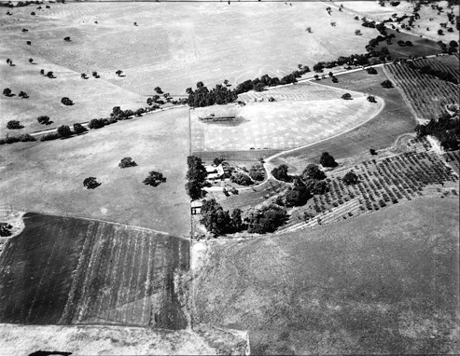
Photo "Courtesy of M. Eaton." Aerial photo of home (off Arastradero Road, Palo Alto) around 1925. 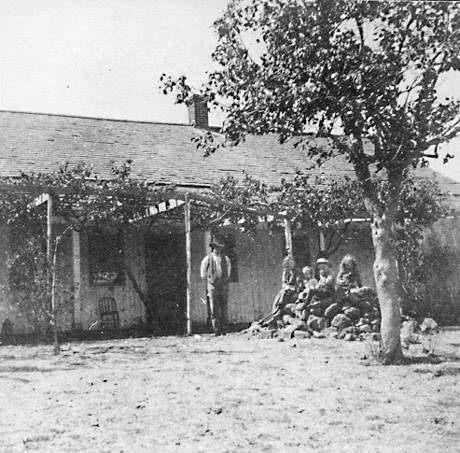
Photo "Courtesy of M. Nott Ginsberg." Briones' rancho home, in 1880s or early 1890s. There's some speculation that portions may have been built over Gorgonio's house. Briones' home was demolished in 2011 after a long legal battle. It is difficult to believe that only a section of one of its uniquely constructed walls was salvaged. Plans are to make a permanent Briones exhibition, including the wall, at the Palo Alto History Museum. Palo Alto Stanford (PAST) Heritage member, Clark Akatiff: "The legend of Juana Briones grows by the year. All of us engaged in the long lost cause of saving the Casa can take heart in the fact that though we lost the house, we saved the persona and advanced La Causa."15 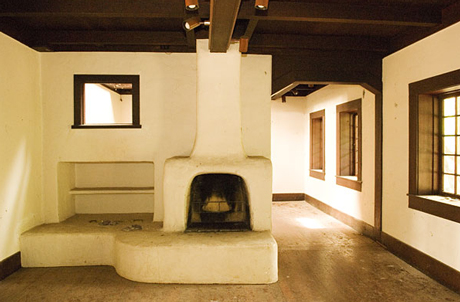
Photo: L.A. Cicero. Briones house hearth16 The persona of Briones has been reconstructed in recent years by storyteller Olga Loya. She created a one-woman Chautauqua where she becomes Juana Briones, which she has also adapted for performance as a more conventional, third-person narrative. For years, students from nearby Juana Briones School came annually to the Briones house to learn about the Briones legacy and to create art on site, which they would then display in an exhibition. Stanford history Professor Albert Camarillo served as a guest curator for the 2014 exhibition mounted by the California Historical Society in San Francisco about the life and times of Juana Briones—Juana Briones y Su California, Pionera, Fundadora, Curandera. The remnant wall was prominently displayed. "The story of Juana Briones is important to us all as Californians for many reasons," Camarillo said. "She was a humanitarian and folk healer, a woman who cared for sick and needy people regardless of their ethnic, racial or class background, or whether they spoke Spanish, English or some other language. She was also a person of great integrity who persevered through tumultuous times in the 19th century and fought against great odds to protect her rights as a property owner, as a mother and wife, and as a businesswoman." Camarillo said the exhibition offered new perspectives and an "appreciation for a little-known historical figure whose stories reflect some of the best qualities we as people possess." At times Camarillo's students at Stanford have created projects related to Briones and an accompanying exhibition. My thoughts about Briones and art go beyond the red lacquered Chinese chest given to her, the stone mortar and pestle found on site, the music in extended family gatherings, her dramatic recounting of events, or the dressmaking and sewing business in which she employed Indian women skilled from working in the missions. They go beyond the unusual construction of her homes, an architectural interest she may have first learned from Indian women who, having built their own homes, were construction experts. Rather, I think about her creating an environment that fostered innovation and freedom. What is an art scene or a creative scene without personal freedom? More than once, she carved out a space and built on it—for herself and others—at a time when that was definitely not easy for a woman to do. I marvel at her mastery of the art of creative problem solving in multiple arenas, in part learned from Indians: the arts and science of using native habitat for food and herbs along with gardening, farming, and ranching; the arts and science of healing, setting bones, and attending births. Briones was known for her hospitality. In Briones' 1800s, social separations increased. A patriarchal military elite culture advanced in the Presidio and anti-indigenous practices multiplied. Yet Briones did not limit her cultural appreciation; rather, she valued locally made textiles and ceramics alongside imports from England, Mexico, and China. She valued people. With her openness to individuals across lines of race, ethnicity, gender, and class, she showed us the art of community building. Modeling courage and opportunities for women, she fought for her land rights up to the Supreme Court and won. As it says on her gravestone, "She Cared." Connecting Multiple Cultures and Art Movements: Marjorie Eaton (1901–1986) Painter/actress Marjorie Eaton initiated a family-like arts colony in the Palo Alto foothills, on the stage Juana Briones had set with her home on the hill. Eaton was raised in San Francisco, but spent much of her life living in or next to the historic home of Juana Briones. In 1925, Eaton's stepmother, Edith Cox Eaton, a leading San Francisco dress designer and a key figure in Marjorie Eaton's life, purchased Briones' historic Palo Alto house, which had been enlarged by Stanford botanist Charles Nott after he bought it from Briones's daughter. The 20th century brought new expansion and finery to the Briones/Eaton hilltop. People dressed for dinner. While Eaton's father, physician Dr. George Eaton, and Edith Eaton employed three generations of a Chinese family as household staff in San Francisco, the dinners on the hilltop were more a family affair, often gourmet meals cooked by Edith Eaton herself. To understand the arts colony, we need to understand about Marjorie Eaton's art. Marjorie Eaton was a seminal figure linking multiple cultures, women arts leaders, and the proliferation of major 20th century art movements: Cubism, Expressionism, Social Realism, conceptual art, and abstraction. After completing her first oil painting in 1922 at the San Francisco Art Institute, she studied or worked in San Francisco, Carmel, Boston (Art Institute of Boston), New York, Taos, Florence, Italy, Paris, and Mexico, among other locations. Her independence and peripatetic experience were evident early on, laying the foundation for creating her complex artist colony, as we see in her recounting of how she befriended art dealer/collector/teacher Galka Scheyer in 1928:
I recall vividly when I met Galka. She had come up from Los Angeles and was living at a little hotel on Sacramento Street near the Fairmont Hotel. She had with her all the paintings that she had brought from Germany of the German Expressionists, including Paul Klee. … This was the first trip, and she was showing to people [who] bought these things. I imagine she didn't go back for a couple of years at this time.
I had taken a job as a [department store] stylist in Oakland, and I was commuting back and forth. I was so tired most of the time that I stayed at the YWCA—I couldn't make it back again.17 Fortunately, staying at the relatively new San Francisco Chinatown YWCA enabled Eaton to work and forge cultural connections.18 Scheyer was giving lectures at the YWCA and "bringing her art right to the level of the people." As an energetic arts impresario who saw that art could make a change in people's lives, she brought fellow artists Paul Klee, Lyonel Feininger, Vasily Kandinsky and Alexei von Jawlensky together to form the Blue Four (so named due to their association with the Blue Rider group of Munich Expressionists), and introduced their work to American audiences.19 Eaton bought a Klee, her first acquisition. Eaton was impressed by Scheyer's accomplishments and commitment. She invited Scheyer to her studio and showed her paintings. "She must have been in her early forties. She was German ... an artist, a poet, a painter herself. She had gone to Oxford." Scheyer's recognition and support meant a lot. "Galka was so enthusiastic about my work…that she attacked my father for letting me ... waste my time, standing on my feet in a department store … wasting my life on transportation." Through a friend of a friend, Eaton was introduced to Lloyd Rollins, joint director of the de Young Museum and the Legion of Honor.
He was young and full of ideas. In fact, I introduced him to Galka, and he had a big show of the Blue Four at the de Young Museum. They [Lloyd and Galka] came to blows a little bit, because she wanted to have one picture very high up and another picture low down, below the eye level, and another one at the ceiling … diagonal movement on the walls.
Scheyer was clearly full of ideas, also. The standard museum eye-level installation, however, was not a convention Rollins felt he could challenge. I was very instrumental in Galka meeting people, and yes, she for me. You see, our lives were interwoven. They continued to be interwoven. And she would come down on the weekends [to Palo Alto] to recover from her wild life lecturing. After meeting Eaton, Rollins offered, "Marjorie, if you go and give up being a stylist at this department store and settle down for three years and paint, I'll give you a show at the Legion of Honor." The offer was just what Eaton needed. Eaton drove down to Taos and joined her friend, painter Katie Skeele. She saw "the most beautiful" Indian—"Leonardo da Vinci was right there in his face"—and asked him to pose for her. "Katie gave me some canvas, stretched a canvas for me, good canvas, and said, 'You can have my paints, but you can't have my brushes.'" So Eaton painted her first painting of Juan Mirabal with her fingertips. A friendship grew. She shared her arts knowledge with Mirabal, who would come to paint indigenous experience with a modernist interpretation and become known as one of three Taos Pueblo painters. Eaton's favorite work, Paulita Mirabal, was done in Taos. Other Taos works include the oil paintings Taos Girl, Corn Mother, A Dream, Juan Braiding, and numerous drawings and watercolors. At the end of 1931, Eaton submitted art for the juried Sixth Annual Exhibition of the San Francisco Society of Women Artists at the Legion of Honor. This exhibition included paintings by invited New York artists. Eaton's painting Blue Lakes had good company, including a Mary Cassatt, Agnes Pelton, and Frieda and Diego Rivera by "Senora Frieda Rivera" of Mexico City.20 Eaton painted in Taos for three years. Rollins gave her a show at the Legion of Honor in 1932, featuring two rooms, one of drawings and one of paintings. Then Eaton left Taos and went to New York, although she really had intended to go to Europe to meet Klee, Kandinsky, and Jawlensky. "[l] had letters to them, and Hitler came into power in '33 and nobody was going there, you know." So she went to the Art Students League, studied with Hans Hofmann, and that's when "I met Louise Nevelson and I met Arshile Gorky and I worked with him … and I knew Diego Rivera already. I introduced him to Louise.21 That year, 1933, Eaton and Nevelson came to share an apartment, with Rivera and Kahlo living above them. Nevelson worked a bit on murals with Rivera. Eaton learned new fresco techniques.
He [Diego] invited me to come to Mexico to work with him there. So I did go to Mexico and spent three years there … painting. I used to take my work once a year to Diego, and he would look at my sketches and my paintings. … There was never any patronage. … He just treated me as an equal. It was fantastic. … I went away to an obscure village, Pahuatlan, in the country, and lived there for a year with the … very poor people and the Indians…. All the young painters asked me to help them. … I did all that I could. … I came back, finally … and wept. I [was sad] to leave Mexico.22
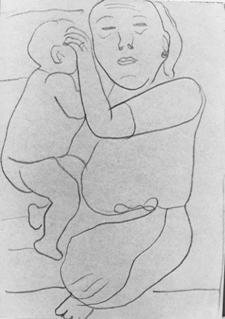
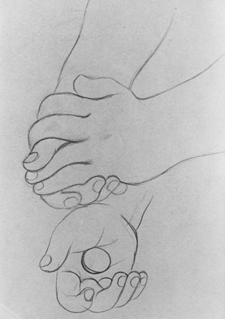 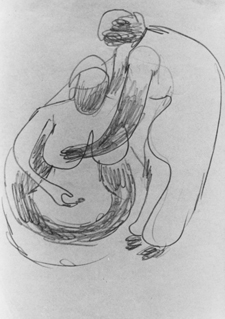
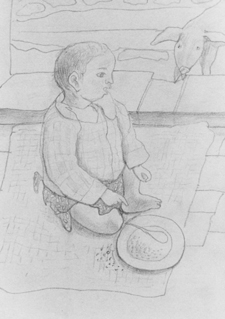
Marjorie Eaton pencil sketches from Mexico around 1935. In Mexico, Eaton made numerous line drawings of children and mothers, including Five Indian Children, Concha and Baby, Xavier Eating Beans with Pig. She got so involved drawing Xavier eating beans that she didn't notice how much he was eating—and he spent a very uncomfortable night. Eaton also captured the birth ritual in a sequence of gesture drawings that caught split-second actions (one for example: Midwife Giving Carmen Her First Bath in Herbs After Birth). She loved children, always wanted one. She found herself drawing them all the time. 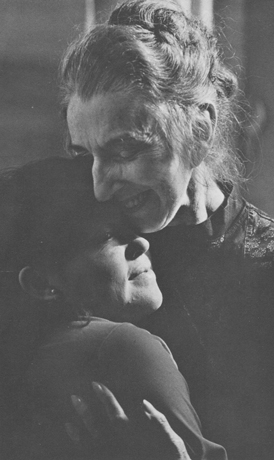
Photo by Hella Hamid, whom Eaton met in 1939. Marjorie Eaton with one of her many godchildren. Although after her father's divorce Eaton chose to live with her stepmother Edith, she ultimately wanted a space apart. In 1939, adjacent to the Briones house, with construction labor from Mexico, Eaton started building her own adobe house. The design honored the Briones home site, while combining her own ideas, giving a nod to Picasso, and employing modernist architect Gregory Ain. The home was built with adobe bricks handmade on site, the theater of action reminiscent of the manual labor for the Briones adobe almost a century earlier. Ain designed the home on a diagonal, based on Pablo Picasso drawings held by Eaton's friend, Galka Scheyer. All the adobe bricks had angles to them: a joining of heart and art.23 The hillside became the amphitheatre; the house, a stage. Her home highlighted a large Mirabal mural. Despite long absences due to her subsequent acting career, she resided there until she died. Eaton used the big house (the original Briones home plus later expansions) as her home base when she lived in New York and Southern California, working in film and on stage, including Broadway plays. Her film career included roles in Anna and the King of Siam (1946), Mary Poppins (1964), and Street Music (1981). During long absences, she rented out her new adobe, at one point to Alan Cranston and family before he became a senator. One writer lived there for many years rent-free. Eaton's colony never had a name. Its true years as an artist community began around 1941, when Eaton invited artist Lucretia Van Horn, who was having a difficult time in her later years, to come visit. She never left. Invited by Edith Eaton, the Nakatas, a Japanese-American family who had been interned, stayed in the cottage that had been the chicken coop for a decade after the war. The colony grew from Eaton's friendships and generosity, in part the result of a convivial sequence of dinners, visits short and long, events, and ultimately, architectural expansion. Some artists lived in the big house, which spanned the art vs. craft divide with décor that included painted furniture by Arthur and Lucia Mathews, who brought the spirit of the Arts and Crafts movement to Northern California in the early 1900s. Some stayed for years. Things were not always rosy. Consuelo Cloos, painter and opera singer, was so difficult, Eaton had a separate cottage built for her by a master carpenter from New York. It was essentially one huge room on poles, over to one side of the big house, and three-storied in back. Mosaicist Thomas Hunt came in 1956 and lived at different times in the big house and in a cottage at the rear of the compound (the Nakatas' former chicken coop-cum-cottage became his studio). Hunt took care of maintenance, did all the cooking after Edith's stroke, and grew into a devoted collaborator. He became the executor of Eaton's estate when she died. Susan (Cox) Kirk, who grew up spending summers and holidays with her family at "the ranch," remembers the apricot and almond orchards, the aromas from Aunt Edith's fabulous cooking, dinners at the Arts and Crafts table, the music room with grand piano, the five fireplaces, the imposing wood staircase, and the gardens. She depicts a Bohemian Marjorie seemingly at odds with her Victorian stepmother Edith. "Edith, San Francisco's leading couturier, traveled to Europe for fabrics every other year with large steamer trunks. Often Marjorie went along. Dr. Eaton had run off with his nurse leaving Marjorie and Edith to fend together. Marjorie always strove for her father's acceptance. Her deep longing affected her trajectory in life." Kirk's father, Charlie Cox (Edith's nephew), and Marjorie were raised side by side since the age of 12. Together, they took care of Edith in her wheelchair years. "For Charlie and Marjorie, it was all about people," Kirk reminisces. "So many gathered around that table—artists, politicians, writers, family, friends—and held stimulating conversations about the times. I was raised to connect with people." Decades later Eaton told Kirk she envied her life raising two children, and called it "the real work." For Eaton, who had no siblings or children, the colony and the life she chose in the theatre after 1940 provided more than community. "I created a family," she declared in First Generation's artful documentary video of Eaton.24 In terms of architectural history, Eaton repurposed and built on the Juana Briones house, which had been modified by the previous owner, Nott; Briones herself had built on what appeared to be portions of an earlier structure, possibly Gorgonio's adobe house. The sequence hints at the repurposing cycles that flourished in the 20th century, when artists and other creative people took over neglected or ill-functioning architectural forms, often in undesirable neighborhoods, and turned them into art spaces, re-envisioning what is possible. It is easy for a multidisciplinary artist like Eaton, working in different geographies, to slip through the art-historical cracks. My understanding is Eaton has not been featured in Maurine St. Gaudens' upcoming book Emerging from the Shadows: A Survey of Women Artists in California, 1860–1960, because she painted primarily in Taos and Mexico, not in California. However, growing research places Eaton with the husband-and-wife team, architect Rudolph Schindler and activist Pauline Gibling Schindler, and father-and-son photographers Edward Weston and Brett Weston, at salons in Los Angeles and at Eaton's ranch. They were part of a modernist circle of people exchanging ideas and contacts in the arts and architecture, many with a strong social conscience, leading educational, labor, and social movements.25 As editor of the Carmel-based progressive weekly, The Carmelite, in the late 1920s, Pauline Schindler had featured Dorothea Lange on one of her magazine covers. Eaton and her friend Pauline Schindler both had ideas regarding architecture, and offer less discussed perspectives on architectural goals and purposes. Pauline Schindler had worked with Jane Addams in Chicago's Hull House, and the continued influence of its progressive communal philosophy found expression in Schindler House, aka Kings Road House (1922), the Southern California modernist architectural icon the Schindlers created that served as an experiment in communal living, artistic salon and left-wing meeting house. Hull House, founded by Ellen Gates Starr (1859–1940) and Jane Addams (1860–1935), was known as a settlement house, and served as a successful center for social reform, providing opportunities for immigrants and the working poor, including through the arts. The Schindler House, however, while a work and social hub, turned out to be not very livable as designed. John Cage lived there briefly, as did Galka Scheyer in 1931. After Rudolph's death in 1953, Pauline made changes for comfort and aesthetics, including audaciously painting her side of the communal house pink.26 Pauline Schindler's own vision had a resonance with the family-like colony Eaton would build:
One of my dreams is to have, some day, a little joy of a bungalow, on the edge of the woods and mountains near a crowded city, which shall be open just as some people's hearts are open, to friends of all classes and types. I should like it to be as democratic a meeting-place as Hull House where millionaires and laborers, professors and illiterates, the splendid and the ignoble, meet constantly together.27
Other Eaton contacts include the Mexican muralists Diego Rivera, José Clemente Orozco, and David Alfero Siqueiros, speaker/writer Jidda Krishnamurti, and artists and activists Henrietta Shore, Beatrice Wood, and Tina Modotti. Working with Scheyer, Eaton built a substantial contemporary art collection. At the time she bequeathed it to the Oakland Museum of Art, it was valued at approximately $2 million. Eaton, born elite with a silver spoon in her mouth, lived relatively simply, but she traversed borders and supported diverse aesthetics morally, financially, and across cultural boundaries of social or economic status, gender, and ethnicity. "Try not to stop [she pauses] until something stops you."28 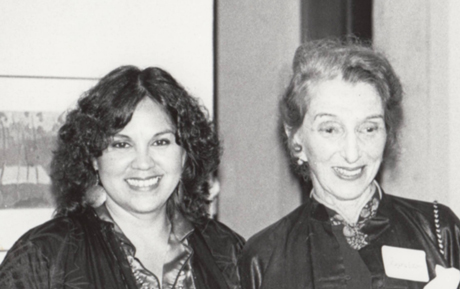
Photo (detail): Helen Carlisle Fleming. Artists Patricia Rodriguez and Marjorie Eaton in the exhibition Staying Visible, The Importance of Archives in 1981. Rodriguez, from San Francisco, resonated well with Eaton—both created art that was cultural and emotional, and both were activists. Rodriguez propelled Mujeres Muralistas, a group of Chicana/Latina artists in the Mission District that pioneered large-scale, woman-painted outdoor murals in the 1970s, when the mural tradition was overwhelmingly male. Their first mural was on a garage door in their alley—now well known as Balmy Alley. Twenty years later, the spectacular mural Maestrapeace (1994) turned the San Francisco Women's Building into one of the city's most distinctive and memorable architectural statements—educational, inspirational, and meaningful to the community. The multicultural, multigenerational collaboration of seven women included one of the Mujeres Muralistas, Irene Pérez. Both murals are prime examples of rethinking and repurposing. Shaping New Creative Environments When I knew Eaton in the early 1980s, she was still running a small international arts colony from her property. Imagine the scene: Wisteria blooms from century-old vines blowing across the tile floors, piling near Briones' old adobe and redwood walls; Eaton, a slight woman with a dramatic air, playing host to a diverse and lively array of artists and others. Some, like Nevelson would come and stay for a month; others, like artist Lucretia Van Horn, lived there many years. Mirabal visited from Taos. Photographer Imogen Cunningham came and took photographs of the ranch. An opera singer, an African American playwright, a French harlequin, and other artists lived on site in the early '80s. Salon-type events were a regular occurrence. Kirk, a jazz singer who lived in the house on and off from 1945 to 1993, hosted elegant dinners and staged concerts. She recalled visits from notables across all fields, including scientist Linus Pauling, author Wallace Stegner, entrepreneur Steve Jobs, and the Palo Alto City Council. The Women's Heritage Museum (WHM), founded in Palo Alto by Jeanne Farr McDonnell, arranged with Kirk to conduct public tours at the ranch, telling the history and imagining what life was like there. With such tours, hundreds of local school children were able to get a flavor of the house's colorful history and its female visionary lead characters.29 For decades, away from the confines of rigid systems, creative people developed new insights at the Briones/Eaton ranch on the Palo Alto hilltop. Empowering People with "Thread Knowledge": Consuelo Jimenez Underwood Contemporary artist Consuelo Jimenez Underwood wove baskets in 1971–1973 in Los Angeles as a young mother, having read a childhood book about Dat So La Lee (ca. 1829–1925, Nevada), one of the last great Native American (Washoe) basket weavers. Understanding basketry allowed Underwood an easy transition to other textile arts, including weaving. Working with fiber to convey concepts sparked her creative process. In 2005, her solo exhibition at Moviemiento de Arte y Cultura Latino Americana (MACLA) in San José, centered on Tortillas in Basket constructed at her nearby Cupertino studio: "The tortilla baskets celebrate the survival of indigenous culture." 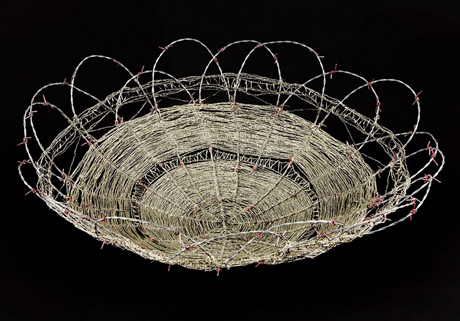 Undocumented Tortilla Basket, 2008. Barbed wire, aluminum wire, 9.5"x29" diameter. Undocumented Tortilla Basket, 2008. Barbed wire, aluminum wire, 9.5"x29" diameter.
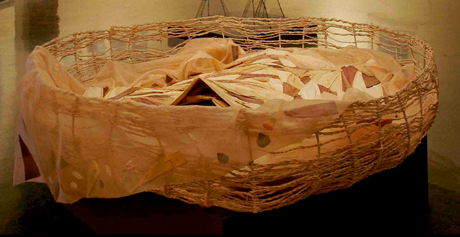
Tortillas in Basket, 2005. Reed, silk, corn leaves, thread, 20"x5' diameter. Part of her exhibition entitled Tortillas, Chiles, and Other Border Things at MACLA that commented on the "true American food that has survived 500 years of colonization—the tortilla de maiz. In 1992, the tortilla outsold 'white' bread in the U.S. That is incredible, when you consider that the tortilla was invented by the Amerindians." Underwood's life and art span border issues and three cultures. She grew up crossing the U.S.–Mexico border, starting in 1949 soon after she was born in Sacramento, California. Her mother, born in 1906, was a first generation Californian, whose ancestral family had a connection with the Tarahumara (northwestern Mexico), the people who run long distances. It is from her maternal side that Consuelo draws "tenacity and strength of will." Her father, from Jalisco, was one of the first braceros during World War II. His mother was full-blooded Huichol, who married a Mexican and lived and worked on a hacienda in Jalisco, Mexico. Since she was never permitted to speak in her native tongue, Underwood's father never learned Huichol. Years later, when Underwood was a very young child, it was her father who introduced her to weaving and taught her the magic and mystery of life. He inspired Underwood with "songs and stories, where forces like wind and fire were main characters." While it is with her Huichol grandmother that Underwood connects, she never met her. Honoring her Huichol grandmother and all the Amerindian anonymous woman elders who wove with a backstrap loom, Underwood vowed in the 1970s, early on her artistic path, to always make art with a textile process or material. She insisted on focusing her artistic studies on learning how to spin, dye and weave with thread. "I learned three ways of seeing and understanding the world—the English, Spanish and Amerindian, all very distinct." Underwood has spoken about the past, her Amerindian connections, survival skills, and the mixing of peoples and cultures. "There was no border in California, just two little stalls at the border crossing at Mexicali/Calexico." Recalling the Chinese, Underwood recounts, "They go way back. It was difficult for them in Mexico and the United States (Chinese Exclusion Act). In the late 1880s, they were sent back to China. Some were sent to Yaqui Land [the fertile valley on the banks of the Yaqui River in the Sonoran Desert]. They have burial grounds there. So there are Chinese descendants in Yaqui Land." Underwood's husband, electrical engineer Dr. Marcos Underwood, is a Yaqui member of the Pascua Yaqui Nation in Tucson, Arizona. The Underwood family participates annually in the spring and fall rituals in Yaqui Land. While others built an arts colony in Palo Alto or a Chicano movement in San José, Underwood worked the fields. She knows many would like to forget the borders and the struggles. Instead, she loves large walls as creative opportunities to rethink artificial divisions, see a larger picture, and imagine a more humane world where we don't need road signs warning of families running across the highway. Through her large, colorful and inviting fiber art installations, she has honored a strong connection with the land and living things, and countered the human tendency to use architecture and walls to create divisions, like the scar on our southern border. 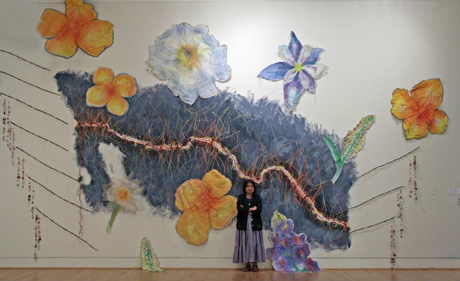
Consuelo Jimenez Underwood, Undocumented Border Flowers, 2009. Fiber, 17'x24'x5". Installation, Triton Museum of Art, Santa Clara, California. "My artwork is intended to alert the public about the devastating and irreversible environmental chaos that the US/MX border is creating on our southern homelands. My fear is that soon we will require even our state flowers to acquire proper documentation if they wish to grow on both sides of the border. Yikes!" Based in Cupertino since 1980, Underwood became a professor at San José State University. She went on to develop and head the university's Fiber/Textile Area for 20 years (1989–2009), where she took on the recurring arts vs. crafts division in the art world and empowered people with "thread knowledge." Respected as a star educator and internationally known for her fiber art, Underwood created a provocative and evocative solo exhibition of multiple wall installations in 2013 at the Triton Museum of Art in Santa Clara, entitled Consuelo Jimenez Underwood: Welcome to Flower-Landia. San Jose Mercury News reporter Joe Rodriguez reviewed the 2013 Triton Museum exhibition. He noted how Underwood spoke with the Santa Clara University students of associate professor Juan Velasco: "I've learned the power of generational knowledge," she said. "When you pass knowledge to the younger generation, not everyone gets it. But if one, two, or three get it, then we won." Winning connects with opening minds and hearts and, at its most basic, with survival for the marginalized. María Ester Fernández, curator of the Flower-Landia exhibition, elaborates:
[Underwood's] indigenous heritage gave her the strength and purpose to infiltrate, play the game and survive. Trained as a child to cross borders real and psychological, Underwood walks between opposing issues. Living in the middle as an infiltrator, she has learned to navigate contested territories: as a picker in the fields, as a student in school, and as an artist using indigenous weaving tradition as fine art. This exhibition is an attempt to recreate that journey, to relive the tension of a highly volatile border region embodied by a young girl, and to re-imagine the border as a place where the spirit can roam free.
Regarding Underwood's self-portrait, Tenured Petals, Fernández adds:
Ten is a magical number; the age at which Underwood realized that as long as she played the game and learned the rules; she could win. At ten, she created a life plan to free the spirit. It also touches on the artist's academic career, having achieved tenure at San José State University and retained her identity as a weaver after much pressure to succumb to a more traditional fine art practice.
Underwood is the subject of an individual profile I am writing that will include discussion of her stunning Borderline Encounter #1, a performance in the ocean commissioned for an exhibition by MACLA and photographed by SJSU Professor Robin Lasser. Underwood's influence continues to grow. A 2014 Artist Laureate for Silicon Valley Creates, she has been interviewed by the Smithsonian Institution, and has major installations planned in Reno, Nevada (2015); then a very large wall in Washington, District of Columbia (2016). Underwood is delighted to be taking her art to where they make policy, the political home of this nation. But the first six months of 2015 she dedicated to weaving a new rebozo (shawl) "for the Virgen." 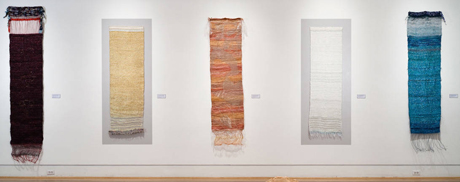
Rebozos For Our Mothers, 2013 Woven wire, linen, silk, rayon, gold and silver threads. Left to right, Mother Mundane, Virgen de Guadalupe, Mother Earth, Mother Moon, and Mother Ocean. 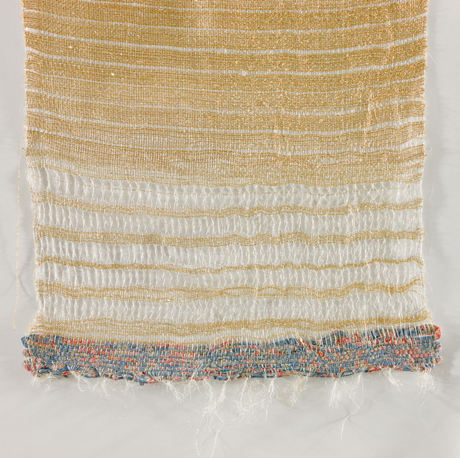
Virgen de Guadalupe, 70"x20" (detail), 2013 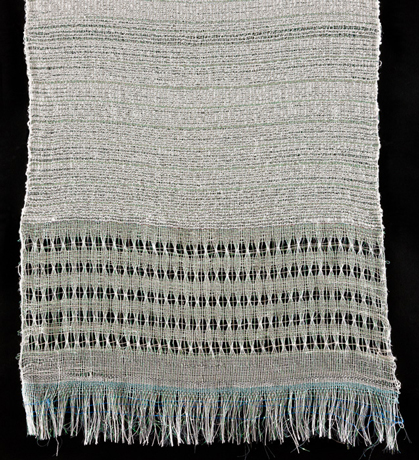
Mother Moon, 70"x20" (detail), 2013 A Spiral Through Time Underwood's baskets remind us of the workload women have carried, and her one-of-a-kind woven forms bear witness to the ongoing creativity, energy and innovation of Silicon Valley, and her unique spirit. Her gigantic fabric flowers also evoke spirit, transcendence, as well as the too long ignored, real world struggle to sustain natural habitats. Following Underwood's art and career yields stories that illuminate the realms of border crossing and take us on a beautiful spiral through time, starting with the early art of Ohlone women, through the intercultural appreciation and courage of Briones, followed by the expansive cultural and art-world connections of Eaton, up to today. Underwood's fiber art raises ongoing questions about local cultural development, about the nature and challenges of borders—geographic, generational, academic, social, and in the art world—and about imaginative travel through time. "I need the old ways." She speaks of the "ancient ones" as if they were intimate family members. A convivial vision comes to my mind of a wonderful, intergenerational circle of women. All are admiring, perhaps with smartphones at hand, Underwood's exquisite woven rebozos for the "ancient ones," the first weavers: Consuelo with Dat So La Lee, Juana Briones and Marjorie Eaton; Angela Colos with Jean La Marr—sharing tales, oohing, aahing, nodding in approval, and smiling—a natural gathering of community in Silicon Valley, as it was in the beginning with the ancestral Ohlone. Returning to real time, construction proceeds on the huge, synchrotron-like Apple Computer headquarters—a circular building echoing the Ohlone tupentak meeting space. The Cupertino site will have 85% open space, trees, an old barn, and a flavor of the agricultural past. Companies, organizations, educational institutions, and cities choose building sites with a hilltop or coastal view or the advantages of a nearby major transit artery—a good mix of art, technology, and community. Dark, streamlined buses ply these routes from San Francisco to Silicon Valley, bringing workers who, like Briones before them, weave together cultural experiences, employment opportunities, and creative styles. Fleets of these black-windowed shuttles cause their own disruption and resentment. As in centuries past, constant travel, trade, and immigration has built new workforces and economies, brought class struggles and injustices, and engaged new ideas. This investigation began with local indigenous people, examining changes in Ohlone art and lives in relation to socioeconomic and political changes that continue to this day. What do various creative—and caring—communities feel like in terms of architecture, institutions, and informal get-togethers? How does the example of creative people like our circle of women connect with contemporary transmissions of values held most dear? These are ongoing questions that thoughtful leaders must address. This historical bridge is excerpted from a manuscript in process, written in collaboration with others. This essay and related article, "Ohlone Art and Community Building," would not have been possible without discussions and insight from Nancy Hom, Judy Goddess, Dr. Laurel Bossen, Lucy Cain Sargeant, Alan Leventhal, Jean LaMarr, Dr. Lee Panich, Consuelo Jimenez Underwood, Mary Parks Washington, Connie Young Yu, Clark Akatiff, Ann Sherman, Jeanne Farr McDonnell, and others. Information about the Ohlone and Indian tribes in California: Field, Les W. with Alan Leventhal and Rosemary Cambra, "Mapping Erasure," in Recognition, Sovereignty, Struggles, and Indigenous Rights in the United States, A Sourcebook. Ed., Amy E. Den Ouden and Jean M. O'Brien. University of North Carolina Press, Chapel Hill, 2013. ---, with Alan Leventhal, Dolores Sanchez, and Rosemary Cambra, "Ohlone Tribal Revitalization Movement, A Perspective from the Muwekma Costanoan/ Ohlone Indians of the San Francsico Bay," California History 71:412-431. 1992. Lightfoot, Kent. Indians, Missionaries, and Merchants: The Legacy of Colonial Encounters on the California Frontiers, University of California, Berkeley, 2005. The Muwekma Ohlone Tribe website, www.muwekma.org Rindfleisch, Jan. Ohlone Art and Building Community Information about Juana Briones life and times: Juana Briones Heritage, www.brioneshouse.org Palo Alto Stanford (PAST) Heritage, www.pastheritage.org (Palo Alto Stanford Heritage Newsletter) Stanford University Research at the Presidio of San Francisco Tennessee Hollow Watershed Archeological Project Technical Reports of the Market Street Chinatown Archaeology Project (MSCAP), Stanford Archaeology Center McDonnell, Jeanne Farr. Juana Briones of Nineteenth-Century California. University of Arizona Press, 2008. California Historical Society, San Francisco. Juana Briones y Su California, Pionera, Fundadora, Curandera. 2014. Exhibition. Included Kristine Samuelson's video of Al Camarillo narrating at the Briones site as the demolition loomed; and artist Rebeca Méndez's Of the Earth 1, a 5-minute video portrait of the land Briones held so dear. Information about Marjorie Eaton and "the Ranch" arts colony: Rindfleisch, Jan. Staying Visible: The Importance of Archives, 1981; Betty Estersohn, Jan Rindfleisch, Deanna Bartels, "Marjorie Eaton." Also, Carol Holzgrafe, "Consuelo Cloos." A separate publication includes information about Tom Hunt: Holzgrafe, Carol. "Mosaics," in Art, Religion, Spirituality. Jan Rindfleisch. 1982. Susan Kirk remembering, Palo Alto Stanford (PAST) Heritage 2007. Conversations and correspondence with Susan Kirk, artist Tom Hunt, Deanna Bartels Tisone and others. First Generation—Deanna Bartels, Betty Estersohn, and Joan Valdes—created a 1970s award-winning video, Marjorie Eaton. John Crosse conversations and correspondence related to Pauline and R.M. Schindler/Edward Weston circle Mayfield, Signe. Marjorie Eaton: Paintings and Drawings from the 1930s. Palo Alto Cultural Center. 1992. Exhibition catalogue. Information about Consuelo Jimenez Underwood: Rodriguez, Joe. "Artist weaves flowery tapestry of hope from thorny U.S.–Mexico border," San Jose Mercury News. October 29, 2013. Hernandez, Ester. Text panels for Flower-landia exhibition. Triton Museum of Art, Santa Clara, California. 2013. Perez, Laura. "Threads." Craft in America. PBS. KQED, San Francisco. May 11, 2012. "Threads," SPARK*. PBS. KQED, San Francisco. June 2003.Television.
1
On October 16, 1838, two Mission Indians residing in south San José, married at Mission Santa Clara. A year later, their daughter Maria Asuncion de Los Angeles was born on the Bernal rancho. The family then moved to the Bernal-Pico-Sunol rancho between Sunol and Pleasanton. Maria Asuncion was later known as Maria de los Angeles Colos or Ângela Colos. She was interviewed by five anthropologists, starting in 1904. She died around 1929, before she was able to enroll with the Bureau of Indian Affairs. On October 12, 1929, John P. Harrington, a linguist from the Smithsonian Institution, interviewed Angela Colos and she stated, "The Clareños were much intermarried with the Chocheños [Indians from Mission San José]. The dialect(s) were similar. Muwékma, la gente (the people)."
Anthropologist C. Hart Merriam collected baskets from Ascencion Solarsano de Cervantes (died 1930) and her mother Barbara Serra (Mission San Juan Bautista) during the early 1900s, which are curated at UC Davis.
2
For more information, see Projects - Ohlone Art and Building Community
3
"Mapping Erasure," Les W. Field with Alan Leventhal and Rosemary Cambra, in Recognition, Sovereignty, Struggles, and Indigenous Rights in the United States, A Sourcebook, edited by Amy, E. Den Ouden, and Jean M. O'Brien, 2013, University of North Carolina Press.
4
Rosemary Cambra is the elected chairwoman of the Muwekma Ohlone Tribe of the San Francisco Bay Area whose enrolled membership is descended from Missions Santa Clara, San José, and Dolores. As a previously federally recognized tribe, the tribe is seeking reaffirmation as well as honoring their cultural traditions and identity. For ethnohistory and tribal recognition background in the context of a recent local reburial, see "Final Report on the Burial and Archaeological Data Recovery Program Conducted on a Portion of the Mission Santa Clara Indian Neophyte Cemetery (1781–1818): Clareño Muwékma Ya Túnnešte Nómmo [Where the Clareño Indians are Buried] Site (CA-SCL-30/H)." Chapter 1 "Introduction: Project Overview" by Alan Leventhal, Rosemary Cambra, Norma Sanchez, Diane DiGiuseppe, and others. Chapter 10: "An Ethnohistory of Santa Clara Valley and Adjacent Regions; Historic Ties of the Muwekma Ohlone Tribe of the San Francisco Bay Area and Tribal Stewardship Over the Mission Santa Clara Indian Neophyte Cemetery: Clareño Muwékma Ya Túnnešte Nómmo [Where the Clareño Indians are Buried] Site (CA-SCL-30/H)" by Rosemary Cambra, Alan Leventhal, Monica V. Arellano, Shelia Guzman Schmidt, and Gloria Arellano Gomez
5
"Archaeology, Indian memories, and plodding through mission records flesh out lives of the original Californians," Marion Softky, The Almanac, 5/14/2001.
6
"Final Report [on the Burial and Archaeological Data Recovery Program Conducted on a Portion of the Mission Santa Clara Indian Neophyte Cemetery (1781-1818): Clareño Muwékma Ya Túnnešte Nómmo [Where the Clareño Indians are Buried] Site (CA-SCL-30/H)."] Chapter 11: "Reburial of the Muwekma Ohlone Tribe's Ancestral Remains from the Mission Santa Clara Indian Neophyte Cemetery: Clareño Muwékma Ya Túnnešte Nómmo [Where the Clareño Indians are Buried] Site (CA-SCL-30/H) and Final Site Management Recommendations" by Rosemary Cambra, Alan Leventhal, Charlene Nijmeh, Norma Sanchez, Diane DiGiuseppe and David Grant.
7
The Muwekma website, cited two Muwekma presentations for the Society for American Archaeology 80th Annual Meeting in April 2015. For the Society of California Archeology 2015 Annual Conference, plenary session organizer Kaely R. Colligan wrote that the meeting's theme "Beyond Boundaries" was chosen to emphasize "the influence of cultural and physical boundaries on our perspectives within the archaeological record. In the spirit of 'Beyond Boundaries,' we have built a plenary session featuring papers co-authored by Native Americans and archaeologists." The session included "Meaningful Relationships between the Muwekma Ohlone Tribe of the San Francisco Bay and the Anthropological/Archaeological Communities: A Process of Reciprocal Benefits and Collaborations in Language Revitalization, Biological Anthropology," Alan Leventhal, Rosemary Cambra, Monica V. Arellano, Sheila Guzman-Schmidt, and Gilbert Martinez
9
Juana Briones' father was already in California and about twelve years old when the Anza expedition passed through. He was with his father at Mission San Luis Obispo. Barbara Voss states that in 1790 California census (missions plus six nascent cities), 71% of the adults in Alta California originated in the Sinaloan/Sonoran/Baja California region. Briones' father had come from San Luis Potosi, her mother from Villa de Culiajan. In terms of the Presidio, Voss writes not one of the original settlers was born in Spain; in modern terms, their national origin would be best described as Mexican. The Archaeology of El Presidio de San Francisco: Culture Contact, Gender, and Ethnicity in a Spanish-colonial Military Community, Barbara Voss, 2002, Ph.D. Dissertation, University of California, Berkeley. P. 148
10
For general information about the archeological project, see Stanford University at the Presidio of San Francisco Tennessee Hollow Watershed Archeological Project, which includes an excerpt from Chapter 9, "The Presidio Landscape," in The Archaeology of El Presidio de San Francisco: Culture Contact, Gender, and Ethnicity in a Spanish-colonial Military Community [Barbara Voss, 2002, Ph.D. Dissertation, University of California, Berkeley]. Voss gives insight into Briones' relationship with presidial society: (In the following, Guadalupe Briones is Juana's older sister.)
…The residential strategies of the Briones sisters thus highlight the variability within military society in Alta California during the early and mid 1800s. Without repudiating the trend towards "seigneurial" patriarchal[8] control of land, women, Native Californians, and livestock, the biographies of women such as the Briones sisters expose diversity within the presidial settlement and engender more complicated, nuanced interpretations of the archaeological record. While the presidial community was reviving and expanding its main quadrangle in the late 1810s, Guadalupe Briones and her family moved out of the quadrangle into the adjacent valley. At a time when "respect and honor prevailed between the patriarch and the rest of this family… [and] wives were not to be abused" (Monroy 1998:186), and when gendered relations were becoming increasingly central to the formulation of Californio ethnic identity, the case of Juana's troubled marriage exposes the vulnerabilities of the adult women who lived at colonial settlements like El Presidio de San Francisco. It also demonstrates that, despite the growing power of family patriarchs, at least some of the wives of presidial soldiers actively sought independent remedies to their problems and took action to advance their own interests, and that, at least in Juana's case, these actions were intimately tied to manipulations of landscape and space. Perhaps not all of the presidial residents fully participated in the adoption of a "Spanish" Californio identity with all its implications. Additionally, in some cases colonists may have actively incorporated Native Californians into their households rather than sought to distance themselves from the indigenous people of the region. Certainly, the case-study of the Briones sisters is notable in great part because their lives stand in contrast to the written accounts left by the military and religious elite of Alta Californian military society. But rather than being seen as an exception to a larger rule, the Briones sisters illustrate that within the military hierarchy, the patriarchal ideology, and anti-indigenous practices of Spanish-colonial and Mexican presidial society, non-elite subjects were able to create physical spaces in which to advance their own and their families' interests and to protect themselves, to some measure, from the abusive excesses of their social superiors.
11
In January 1848, surveyor Chester Smith Lyman observed the Briones household: "Find our quarters at Madam Briones quite comfortable. The family is composed of the Widow Briones 3 daughters (2 grown up) 2 or 3 boys, half a dozen Indians, 2 little pet pigs in the cook house & 15 or 20 dogs. The two older girls do the cooking; they are rather pretty looking, but like most Californians dirty & slovenly. There are two sick persons in the house, an Indian girl, of fever, & a man, a sailor, apparently a Portuguese, who has a very bad cough." California Historical Society - Juana Briones Exhibit
12
Briones, who lived at the Mission at one point, testified in favor of canonization of Padre Magín de Catala, who died in 1830 and served Mission Santa Clara for 30 years. Catala baptized Gorgonio, as well as one of Briones' children (1827), and many children of her relatives. In her book Juana Briones of Nineteenth-Century California, Jeanne Farr McDonnell mentions that Gorgonio may well have been an assistant who accompanied Catala everywhere he went.
13
For decades, historian Connie Young Yu, based in Los Altos, has researched events like this and offered unique perspectives on Chinese culture locally going back more than a century. Yu's stories elucidate historic dynamics of our economy, politics, and art: Chinese labor on the railroads; Chinese Exclusion Act; and Chinese art purchased by museums, collectors, and religious institutions. Portions of her family's historic art collection instruct patrons at Stanford's Cantor Arts Center. A recent project collaboration of Yu with historian Leslie Masunaga captures the joint history shared by San José's Chinatown and Japantown.
14
Briones died in Mayfield, at her home located at the corner of Washington and Second Street, an intersection now known as Page Mill Road and Birch Street. She was buried in Holy Cross Cemetery in Menlo Park. Her name is the first entry in the register.
16
From Stanford News as demolition was looming in 2007.
17
Except where noted, the basis of this early narrative is derived from an audiotape interview of Marjorie Eaton by Betty Estersohn, July 16, 1981, along with information from conversations with my co-authors Estersohn and Deanna Bartels for "Marjorie Eaton," Staying Visible, 1981.
18
Established in 1916 in an old saloon on Stockton and Sacramento streets, the Chinatown YWCA made a name for itself providing services sensitive to the community. White and Chinese American leaders and activists supported the YWCA for rejecting stereotypes. By the mid-1920s there was a need for a new building; the designer chosen was Julia Morgan. Background information on the location and times can be found at Chinese Historical Society of America website. "Julia Morgan's status as a pioneer of women architects and her dedication to the women's movement shone through her work with the YWCA. Because Morgan embraced the Chinese American community with an uncommon sensitivity for the perspective and needs of Chinatown, an amazing architectural achievement was created. It reflected the emergence of a distinct Chinese American cultural perspective. The '20s and '30s were a time when Chinese American social, cultural, and political identity were borne out of interactions with the broader society and a desire to create a community with sustainability and integrity. The Morgan-designed YWCA building is an iconic institution that celebrates the spirit of those collaborative times."
19
Galka Scheyer (1889-1945), who continued to have a close relationship with Eaton, is a complex art figure. See Darcy Tell's East of Borneo article. [For example, in a 1936 letter to the artists, she recalled that "the Blue Four was founded . . . to share the spirit embodied in these works and to get away from art dealers."]
20
The misspellings of Frida Kahlo's name may have come from leading San Francisco philanthropist Albert M. Bender, who loaned the work. Bender attributed his local arts support to his cousin, artist Anne Bremer, who was an early leader in the San Francisco art community. There were also works by Claire Von Falkenstein and Lucretia Van Horn from Berkeley, Elizabeth Norton, Palo Alto, and Dorr Bothwell, San Diego.
21
First Generation—Betty Estersohn, Deanna Bartels, Joan Valdes—videotape interview of Marjorie Eaton, "Creative Women Over Seventy Series," documentation for California History Center, De Anza College, 1977. Their timely research moved past stereotypes, including ageism. Interview filmed in 1976 at Eaton's adobe in Los Altos.
22
First Generation video. Ibid.
23
See "Marjorie Eaton," Staying Visible, 1981. Estersohn audiotape. Ibid.
"The house I live in now ... we started it in 1939 ... and I went down with the first plans [for the house] to visit Galka [in Los Angeles].... Hella Hammid was there, a girl of seventeen, who was mounting all the drawings by Picasso that were under her [Hella's] bed . . . Picasso sent all the drawings to Galka. Galka had arranged a show at the Stendahl Gallery [in Los Angeles] of the Guernica ... These drawings were just in a box . . . beautiful drawings for the Guernica. They had never been matted, and Hella Hammid was mounting them. … And Gregory [Gregory Ain designed and built Eaton's house] came down ... to look at my [house] plans. Gregory was so excited over these [Picasso] drawings with that diagonal thrust running through them—that that [along with a pre-existing planting of almond trees] started the thrust in my house. The Picasso drawings inspired Gregory ... so that all the [adobe] bricks that had to be made for the house had angles through them. …
"Archipenko [the sculptor] might have been teaching at Mills [College] .... I knew him. ...Hofmann, Schoenberg. ... Oh yes! It was very alive."
24
First Generation video. Ibid.
25
Researcher John Crosse has been piecing together a story of the deeply intertwined lives of the Weston and Schindler families, who first met when Pauline Schindler began teaching at the Walt Whitman School in 1921 in Los Angeles ("The Schindlers and the Westons and the Walt Whitman School"). Crosse links articles on mutual friends and relationships, of which Marjorie Eaton is a significant one. Eaton and architect R. M. Schindler were close personal friends. Schindler and the de Young Museum's Director Lloyd Rollins met at Eaton's ranch in 1931, which eventually led to an architecture show of Schindler in 1933, at the same time as a photo exhibition with Edward Weston, Ansel Adams, Imogen Cunningham et al, at the de Young. Pauline Schindler was also a very close friend with Eaton. The exhibition The Schindlers and the Westons: An Avant-Garde Friendship is slated for 2015 at the UC-Santa Barbara Art, Architecture and Design Museum.
26
After studying California modernist architecture, a student declared, "It all looks the same." The differences in valuing systems struck me. As a student of ideas in the arts, I long for a fuller picture of California modernist architecture, of people involved both beforehand and afterwards in making a design not just impressive, but also functional and relevant—from early decisions like site choice to making a finished design radiate and breathe a personal or group identity. Briones and the Eatons (Edith and Marjorie) made decisions that imbued the ranch with character, life, and history—a unique California architecture and living legacy to remember.
27
Robert Sweeney, "Life at Kings Road: As It Was 1920-1940", in Elizabeth A.T. Smith and Michael Darling, The Architecture of RM Schindler, exh. cat. (New York: Harry N. Abrams, 2001), p. 87. Interesting observations about Pauline Schindler and the painting of her side of the house pink can be found in "Rhapsody in Pink: Stephen Prina Prints," by Thomas Lawson, East of Borneo, April 11, 2013.
28
First Generation video. Ibid.
29
Regarding the study and preservation of women's history regionally, Jeanne Farr McDonnell, who started the WHM in 1985 and was its executive director for 10 years, envisioned the organization covering the California world. The WHM later moved to San Francisco to reach a wider audience, and changed to an international focus, becoming the International Museum of Women (IMOW) in 1997, then merging to become the Global Fund for Women (2014). Its larger mission, however, left a vacuum for dedicated promotion, documentation, and discussion of regional women's heritage.
Euphrat,
1979-2011
Since we resurrected the organization in 1979, we have accomplished
a lot together. I have deepest appreciation for our passionate dedication
to education and artistic innovation, the struggles and triumphs we
shared, and the wonderful friendships we have made through the years.Now I work in the larger art and community scene. Through projects and collaborations, our call to action continues with our awareness, networking, advocacy, and commitment to excellence. Our experience in connecting art, issues, creativity, and community still plays a unique and vital role in trans-disciplinary education and activism today. We must build on this outstanding legacy.
Key
Euphrat Accomplishments (1979-2011),
The thirty-three years (1979-2011) under my leadership were an exceptional
time of growth and achievement for the Euphrat. We formed a spectacular
college/community partnership that has grown vibrant museum programming
for over three decades. Kudos to the Euphrat campus/community family
and the Euphrat Board/Council, particularly Euphrat Council Presidents,
Margaret Kung and Helen Lewis, who oversaw the building of our new
Euphrat Museum of Art. Our shared vision and dedication created an
amazing legacy, including the following accomplishments. Jan Rindfleisch, Executive Director
Rescued, Developed, and
Expanded the Organization
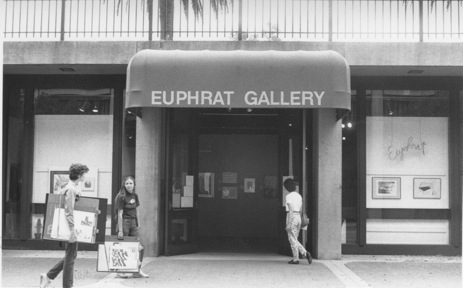
The original Euphrat, next to Flint Center for the Performing Arts, had a long bunker structure, with earth and plants on three sides. Before my directorship, Proposition 13 (1978) had eliminated funding for the Euphrat and about two thirds of the original Euphrat had been turned into classroom space. In the years to come, the remaining Euphrat space was threatened continually with being turned into computer labs. In building up the Euphrat after 1979, we created a bright blue awning and a neon sign/logo in the script of designer Sam Smidt, enhancing daytime and evening visibility for students and Flint Center community audiences.
Curated Ground-breaking
Exhibitions
Initiated and Developed
the Award-winning Euphrat Arts & Schools Program
Developed Collaborations
and Fostered Campus/Community Outreach
Improved the Lives of At-Risk
Youth
Steered the New Building
Expansion
An early exhibition, Staying Visible: The Importance of Archives (1981), included the work of young Mildred Howard and research on, and collection of, Agnes Pelton (1881–1961). Both are art stars today. The new Euphrat's inaugural exhibition Looking Back, Looking Ahead (2009), evoked essences of Silicon Valley, trans-disciplinary, depicting the historical and the contemporary, serious issues as well as humor and satire, traditional art forms alongside the latest technological advances. With student, academic, and community involvement, these diverse elements came together. This type of innovation and risk-taking distinguishes the decades in which I was director.
San José Art History Up To
1985
The First San José BiennialCatalogue essay, Jan Rindfleisch, 1985, for San José Museum of Art and related series of exhibitions in San José It seems to me that San José's first Biennial coincides nicely with the progress this city has made from being a midway point on California's map to a world leader in education, technology and communications. This essay, then, in many respects, is a State of the City in Art. But not every artist and art form will be recognized, not every controversy chronicled and not every source of inspiration honored. Instead I would like to take some time to present you with a history, highlight some early players who helped to shape the art scene in San José, and, along the way, ask some questions that might prompt you to think about where our art is taking us. And where we, in San José, are taking our art.1
The
Cast Of Characters, The Early Players
"How far back do you want to go?"
John
DeVincenzi
asked me. "In 1875, The Art Association was formed
in San José and had its first show at the Normal School, now San José
State University, in June 1876." SJSU Art Professor John DeVincenzi
instigated and organized most of the committees and boards that have
produced the major arts organizations of the South Bay. His voluminous
files archive the South Bay art scene.2
In 1938, a group of San José artists, mostly San José State teachers and students, formed the San José Art League to stimulate public interest in art.3 In 1946, they began holding public art shows at the City Library-a first step in what they really wanted which was a decently large place for permanent and changing exhibits. In the post-WWII migration to California, houses and shopping centers were built in outlying areas, and San José faced problems in the downtown area that continued to escalate over the next thirty years. The Art League believed in improving the downtown image, bringing culture to the city center.4 The Art League started a building committee in 1950, followed by what came to be yearly fundraisers,5 and organized the San José Art Gallery Association in 1952,6 but the City Council dragged its feet on the art gallery question until 1957, when it appointed an official committee headed by attorney Robert Morgan. The Building Committee recommended to the Citizen's Committee that a Civic Art Gallery, an Art Gallery Advisory Board, and a Fine Arts Commission be established by the City. On its own, in 1959, the Art League purchased the 73-year-old Francis Bates home at 482 South Second Street and renovated the property into its own gallery. Of course, art and visiting artists were continuously featured in the SJS Art Department long before 1959, but displays sprawled from classrooms to corridors and the library. In 1959, the art building was constructed-containing the first professionally designed galleries in the California State University System. Early exhibits in the Art Department Galleries, under Director Warren W. Faus , were of June Wayne's prints and Mark Adams's tapestries. The San José Fine Arts Commission was established in 19617, and the City of San José funded the visual arts for the first time in 1967. Fred Spratt, current SJSU Art Department chair, recalls, "The sixties were a heady time of growth and recognition. The artists who joined the SJS faculty came from around the country. There was real ferment; every week something happened in the studios of Sam Richardson, Willis Nelson, John Hunter , Don Potts (then a student)… Critics and dealers would drive down from San Francisco. For the first time, South Bay artists were considered for SECA (Society for the Encouragement of Contemporary Art) awards. In 1966-67, the Richmond Arts Center called attention to art of this area in a major exhibition entitled Bay Area South; most of the artists were SJS Art Faculty or alumni." Artist enthusiasm didn't translate to City Council action on a civic art gallery. A 1968 memorandum to the City Council contains a long list of official committees authorized by the administrators of San José over twenty-three years of planning and postponing. Perseverance by a committee chaired by DeVincenzi paid off; in 1969, the City Council approved the committee's plan to develop the old public library into a first-rate exhibition space? The library site was once the center of the old pueblo of San José established in 1777 The Romanesque building, originally the post office, was built in the 1890s and was the first federal building constructed in San José. The old library was transformed into the San José Museum of Art and declared a California Historical landmark in 1972. A major renovation in 1975 provided functional contemporary gallery space and space for an art classroom. A permanent collection began to take shape, as forty of the area's leading artists donated works of art in 1970. Dr. Delmar Kolb was the first director of the Art League in 1974; he also served as the first director (1971–1973) of the San José Museum of Art-followed by Albert Dixon (1973–1982) and Acting Director Martha Manson. Major shows of the 70s included the American Series ? The eighth in the series, Post-War Modernism , coincided with the bicentennial celebration of the City of San José in November 1977. In 1979, the San José Mercury News , a long-time contributor, sponsored The United States And The Impressionist Era .10 The SJS Art Department was closely aligned with the Museum, providing artwork, staff, volunteers and support on a variety of projects. It was the lifeblood of the burgeoning arts community and a great resource when the city didn't have the money to support the arts. The Department is one of the largest in the state and highly respected. Today, it is the only publicly supported university art program in Northern California that is accredited at the level of a professional school of art. It was first accredited in 1973 when Kathleen Cohen chaired the Department. During her term, 1972–1980, Cohen gave strong support to building the Art Department Foundry and strengthened the Art Department Galleries in part by developing a series of small galleries where students could gather and find out what other students were doing. Throughout the 70s the Department sponsored over twenty nationally and internationally recognized visiting artists each year, including José Luis Cuevas . Robert Irwin, Pol Bury, Bruce Nauman , Mary Beth Edelson, Joyce Kozloff, Peter Plagens and William Wiley.11 A growing development of the 70s was the training of professional artists as opposed to artist teachers. By the mid-seventies, artists, under the leadership of another SJSU faculty member, Jessica Jacobs, were clamoring for city exhibition space with more representation and freedom than the now "established" Museum provided. Jacobs and a number of her students pioneered what were really the very first modern art galleries in San José-starting with the Merz Gallery, later replaced by Wordworks on San Fernando Street, near St. Joséph's Church. When the building housing Wordworks was torn down, Jacobs called a community meeting of artists and proposed creating a significant "alternative" art space, democratically organized and run. Enthusiasm was high-money was scarce. Meetings lasted throughout the summer. A board of twelve was chosen, along with a name: WORKS. That fall the WORKS Board leased the building at 248 Auzerais. Within several months, Jessica Jacobs left WORKS arguing that a gallery needed a director Board members, however, preferred the democratic approach and chose to continue operating without an artistic director. SJSU Professor Tony May became the first president of WORKS (1977-78); Jim Thomas Robert Barth , Gillian Ellenby , S. Barrett Williams and Michael Selic have also served in that role. Jacobs and the people who believed in a directorial system founded a separate space on First Street and resurrected the name which had become Jacobs's trademark: Wordworks. After Jacobs left for Southern California in mid 1980, Wordworks was reopened as the San José Institute of Contemporary Art, a.k.a. SJICA (si-jeye-ca), with Founding Director Susan Kirkpatrick , followed by Bob Tomlinson (1983–1984). In 1981 and 1982, SJICA published Presentense, an ambitious publication of art dialogue, documentation and politics. SJICA has sent a travelling show to Europe, exchanged shows with Mexican artists and linked up with New York in Pam McCormick 's exhibit Correspondances. WORKS/San José (to many artists, "WORKS" for short) exhibits are determined by an Artist Selection Committee-three artists selecting and organizing shows over a six-month period. This structure has provided a continuous and changing esthetic format. To date, thirty-nine artists have served, putting on more than 160 exhibits and events, including an early appearance by Laurie Anderson.12 The Shows
For this first Biennial,
many of the galleries selected shows that in some way help complete
the history of South Bay art. 1. San José ART LEAGUE The Early Years 1938–1972 showcases seven name artists from the Bay Area and Southern California-artists of diverse styles, media and imagery, who exhibited during the early years of the League, before the Museum opened. Much of the imagery is very reflective of the natural settings of the Santa Clara Valley in those years. Artists include Claire Falkenstein (sculptor, printmaker, painter), Friedolin Kessler , Fran Malovos, N. Eric Oback (watercolorist and popular SJS professor, 1950–1979), John DeVincenzi and Margaret O'Keefe . 2. San José STATE UNIVERSITY ART DEPARTMENT GALLERIES The School of San José exhibit shows work from SJSU faculty influential in the '60s-an exciting time of artistic exchange, discovery and experimentation. In the catalog Northern California Art of the Sixties , published by the de Saisset Museum in conjunction with a 1982 exhibit, Georgianna Lagoria wrote about the Department's particular intrigue with industrial techniques and materials: "teachers and students had gathered a library of information on techniques of working with plastics;" artists' studios were "workshops filled with sights and sounds commonly associated with industry." Fletcher Benton used sections of colorful plexiglas in his kinetic sculptures. Sam Richardson used plastics in his small-scale landscape sculptures. John Battenberg developed a war theme in fiberglass and resin, in aluminum and bronze. The activity even lured design majors over to the Art Department, such as Michael Cooper , Jeff Sanders and Robert Strini. One could make some observations on the "School of San José": a preference for materials and objects as opposed to performances, a balanced art-less likely to be radical. "There has not been a radical movement," says Fred Spratt. "Emphasis seems to have been on process-the making of things." San José Mercury News critic Dorothy Burkhart comments, "Most of the artists who work in San José came through SJSU. In the '60s and early 70s, the instructors (mostly male) and their students (also mostly male) earned reputations as producers of elegant objects. Many of these male students, as they matured, continued to follow their mentors' esthetic. The impact of the women's movement hit the University in the early-to-mid 70s, with increased female enrollment. Attempting to find a place for themselves and taking their cue from the increasing number of professional women artists, women students artists looked inward, making personal, often autobiographical, figurative work." More recently, Burkhart sees San José artists "doing their own thing;" she sees "widely varying esthetics."13 3. WORKS San José The artists in The Artist Selectors' Show have already exhibited major art forms in the gallery as curators of the creative shows they assembled for the Artist Selection Committee. In the current exhibit, we see another side of these artists-their own objects, installations, performances. Over 80% of the artists who have served on the gallery's selection committees are participating, including Gillian Ellenby, David Hatch, Anna Koster , Tonia Macneil, Dan Max, Carla Malone , Margaret Stainer, Michele Thomas and Robert Windle . 4. San José INSTITUTE OF CONTEMPORARY ART In New Sites, New Work SJICA Director Loida Sorensen calls attention to the far-reaching influence of artists who once worked or lived in the South Bay-a group which has included Robert Graham , sculptor of the monumental bronze gateway for the 1984 Summer Olympics in Los Angeles. Exhibiting artists include Michael Arata and Ralph Loynachan (Los Angeles), Mark Calderon and Robert Strini (Seattle), Stephen Daly (San Antonio), Jan Harrison (Cincinnati), Peter Greene (New York) and Mark Tansey (New York), whose paintings were selected for the prestigious Whitney Biennial in 1983. Susan Sagawa, a SJSU art graduate who didn't leave San José, and composer Brian Mitchell transform an adjacent gallery into a major installation entitled Tonal Park, San José. The work relates to both the specific architecture of SJICA and to city sounds outside the gallery. 5. San José MUSEUM OF ART The First San José Biennial: A Contemporary Perspective and the Biennial idea itself were initiated by Russell Moore, director from 1983 to 1985.14 Moore chose Julia Brown Turrell, senior curator of The Museum of Contemporary Art in Los Angeles, to serve as guest curator.15 Turrell has chosen an electric cross-section of recent work. For the lovers of paint and color, Bonnie Cooks pastel Dream With Tulips . For the lovers of paint and wood, Sam Hernandez 's life-size Spy VS. Spy sculpture. For the lovers of paint, color and fabric, the painted quilts of Therese May- Red Button Bed . For the lovers of color and photography, Linda Heiliger 's abstract prints of portions of walls. Lusciousness of color, light-hearted titles, the emphasis on surface richness and on content that seems accessible and then glides away-the show lures the viewer to the artists' enjoyment of their media and their personal visual languages James Lagiss : eight-foot-high sculpture drawings-glazes, textures, tonalities of white. Peter Wayne Lewis : abstract expressionism with symbolism galore, magical statements, eye shapes- Moondance, Red Bird, Frog Prince . Lisa Newman : an installation of river rock, leaves and other natural materials behind a suspended door. Bill Helderich : pastel, finely surfaced ceramic men and women, with flattened geometric bodies, a short line here, a dangling dab there to show their sex. Diane Shultz: large paintings with recurring anthurium flowers, reds, purples, triangles, gangly bodies and weird perspectives, narrative titles- I Couldn't Fall Asleep That Night . Some remind one of Silicon Valley penchants or lifestyles: Reed Estabrook 's Exercises in Solid Geometry , Bonnie Stone's Celestial Futon. In "projections of the past for the future of San José," Kim Yasuda projects images, such as the Leaning Tower of Pisa, on the faces of major San José buildings (the Museum, Sears Office Building, Morris Daily Auditorium) to propose a new self-image for San José. 6. THE INDEPENDENTS Patterned after the French Salon des Refuses of 1874, an exhibit that included some salon rejects who later became more famous than the official favorites, The Independents' Exhibition of 1986 includes artists bypassed by the "official" San José Museum of Art exhibit. Approximately three hundred artists active in the area applied for the Museum show; since Julia Brown Turrell picked only twenty, controversy was assured. "A decrepit development," said one painter. The quickly titled Independents were the first to question her criteria and artists. Erica Vegter-Kubic , SJSU art history instructor, became the unofficial coordinator. The Independents' Exhibition was open to all artists in the area. Committees, fund-raising packets, logos and t-shirts were developed. Vegter-Kubic met with the Biennial Consortium and began to inspect spaces that would ideally house some seventy artists with three to four works apiece. "This Show covers a wider range of media than the Museum show-photography, some with social content, more sculpture, fiber, installation." Look for a Sharon Ingle installation: bamboo, fiber, light-poetic and symbolic. And for an Anna Koster installation: trompe I'oeil paintings in real environments so one can't tell where the painted area stops and starts. In their list of exhibitors, I noticed that while a fifth are in school, half are between forty and sixty years old. 7. AND MORE EVENTS Some artists chose not to participate in the large unjuried Independents' Exhibition . Instead, they wanted the public to visit their studios. Artists Robert Windle and Ana England organized Open Studio San José 1986 with about fifty participating studios. This is a first-time event in the South Bay and, once again, conceived, managed and marketed by artists. I hope it will become an annual event. A great way to see art-peering into artists' studios and meeting the artists. Open houses include the studios in the Citadel building and the Fine Arts in Metal Inc., Art Foundry, founded by Alan Osborne in 1979. The latter is the current center for metal sculpture. The Foundry finished a major commission in 1985 for sculptor Fiore De Henriquez from Italy; upon completion, the Foundry had a jammed reception with Mayor Tom McEnery giving Fiore the keys to the city.
How
Do We Measure Up?
Cordell Koland, arts writer
for The Business Journal
and a former arts commissioner, sees a terrific, extremely talented,
art community here. He considers South Bay artists comparable to the
New York community. "They just get more money and promotion. We need
to educate the public, need more outlets and opportunities for artists
to make a living." There isn't a San José style; it's "all kinds of
things, realistic and abstract." Vegter-Kubic, feels the time is coming when magazines like Art in America will focus on San José as they do on Chicago and Houston. She feels however that critics exaggerate regional style differences-she too doesn't see a difference in art expression from city to city-"the stuff is wild, interesting." Dorothy Burkhart, art critic for the San José Mercury News , is more critical. "With the greater acceptance of California artists on the east coast, there's more interest in California artists. True. But those being courted appear to be from San Francisco and Los Angeles, not San José. Those who have left seem to fare better…. Still, they're not exactly the big faces looking? at us from the covers of glossy art magazines… San José certainly is a boomtown, and its visual artists, riding on that coattail, have a collective sense of inflated importance. But, in truth, there's a lethargy here and a failure to grow."
The
Eighties
THE ART LEAGUE continues to showcase established and emerging artists,
and to prod as well as cooperate with other organizations who feature
art galleries. Director George Rivera,
initiated the popular plan of having the downtown galleries hold their
exhibit openings at the same time. Rivera was also instrumental in
the early organization of the Biennial. The new director for the League
is Helen MacKinlay. The San José STATE UNIVERSITY ART DEPARTMENT GALLERIES, counted as one of the top five "major campus art gallery programs" in the State system, provide over 25 different exhibits a month. The current director is Andy Ostheimer. The Galleries are an integral part of the changing role Fred Spratt sees for the SJSU Art Department. Spratt has led the Department into projects with foundations and the local community. He views the community as an exhibit space and plans to use the Art Department to bring site-related sculpture to new building construction in San José. Spratt also launched the 1984 and 1986 CADRE Institute projects (Computers in Art, Design, Research and Education). The 1984 Conference, managed by Professor Marcia Chamberlain , consisted of exhibitions, concerts, industry tours and symposia. The First Silicon Valley Festival of Electronic Arts in 1986 celebrated computer art and music through exhibitions and performances at the area's cultural facilities. Both projects led the way in joining the richness of the arts with the new processes introduced by computers, forcing an age-old question: how are information and perception related in art? (Catalogs are available for both projects.) WORKS San José has just opened a new space at 66 S. First Street in the Letitia building, built in the late 1800s by James Duval Phelan, a California State Senator. The gallery has had its ups and downs. A gallery directed by volunteers, WORKS supporters are engaged in a labor of love. WORKS is special because it invites more participation than other galleries. That's what makes it chaotic and difficult to manage, but also what makes it worthwhile. President Michael Selic: "What also separates WORKS San José is the amount of responsibility the exhibiting artist has; there is no all-powerful curator." SJICA's new director, Loida Sorensen, sees SJICA as both backing the local arts community and taking more risk than the Museum. The art community is directly involved in several of SJICA's fundraisers, including the Annual Valentine Exhibition and Auction. Sorensen likes SJICA's current South First Street location. She would like to stay there when the area is fully gentrified and "reap the benefits from having developed the area." The San José MUSEUM OF ART boasts an enhanced location, a building project, a new director and chief curator. The Museum is the cornerstone of construction now underway for the eight-block Fairmont Hotel retail-office complex known as San Antonio Plaza. The city donated land for a new wing, which will provide over 40,000 square feet of climate-controlled gallery, storage and preparatory space. "There will be exquisite gallery space, with a twenty-foot ceiling and skylight in one gallery. The basement of the old building will house the art education functions; the first floor, the bookstore, cafe and lecture hall"-new Director John Olbrantz has worked with Museum board members on the proposed design of the new addition and on the creation of an ambitious comprehensive plan for the Museum's future. Miriam Roberts from The Art Museum Association of America has been chosen for the new chief curator. The exhibit schedule includes Focus: Seattle , the first of an ongoing series focusing on different cities. Opening May 1987 is Viet Nam: An Artist's Perspective , a locally conceived exhibit guest-curated by Lucy Lippard; Olbrantz's plans are city-wide in scope, to coordinate the exhibition with offerings by the San José Symphony and Channel 54. A source of continuing pride is The Museum Art School, a very successful program currently under the directorship of artist Ruth Tunstall-Grant. The School offers students in the community an opportunity to explore art as both creator and critic.
Support
and Identity
San José artists have developed a support system in galleries, museums,
publications, collections. As Fred Spratt remarked,"… the initial
and basic element in these so-called 'support systems' was the support
which the artists themselves provided each other." By "establishing
a rigorous, but amiable, testing ground…artists hone and certify
their priorities and gain the experience necessary for artistic maturity….
Out of this growth, not preceding it, communities fashion their character."
Artists don't automatically move away anymore. We lost Chris Bruce , Chris Daubert, Katherine Huffaker, Michael Crane , Stephen Moore But Scott Miller and Janet Burdick came back. And Museum ex-Director Russell Moore stayed to open up Allegra Gallery on First Street. The rapid cultural growth occurring in all the arts parallels the renewal of the city's center. While organizations compete for funds, there is a sense of the common good, of developing audiences, an increased awareness of the need to work together, talk. Cordell Koland reflected, "If there is a birth of culture in San José, then the San José Fine Arts Commission is as responsible as any, with a proud heritage. It has supported several alternative galleries and minority programs. It has been courageous the last ten years, played venture capitalist in the art world here and done so very successfully, taken a chance on far-out ideas-WORKS, SJICA. Conrad Rushing was a tremendous influence in getting the Commission credibility, and a driving force in the early years. Dr. Victor Corsiglia was a person of vision, compassion-always with the best interest of the community at heart, yet not afraid to vote no when appropriate. In recent years, Pierre Prodis has been a very good leader, tries to strike a balance between opposing sides-is tremendously community conscious." The Fine Arts Commission, now in its 25th year and giving three-quarters of a million dollars to thirty groups, has placed major efforts on Arts in Education Week, "1 % for art" monies, the hotel motel tax, and arts advocacy in general. "They come out," said former Directors George Rivera and Susan Kirkpatrick. "They attend openings." The Arts Council of Santa Clara County, a relative newcomer in the art-support network, was started in 1982. County Supervisor Rod Diridon sponsored the ordinance to create a local arts council. Along with County and increasing business support, the initial budget of $83,000 has grown to over $310,000. In 1985 the Council awarded $40,000, providing financial backing for individual artists and arts groups. The Council's new program, Business Volunteers for the Arts, taps business expertise for the needs of art organizations. As Hewlett Packard was instrumental in the technological growth of Silicon Valley, so both the Hewlett and Packard Foundations have been the greatest supporters of cultural growth. Other consistent givers have been IBM, Saga Foods and the San José Mercury News under the leadership of Anthony P. Ridder -Dean Bartee, a senior vice president at the paper, is chairman of the Museum's Board. I hear compliments about individuals and companies: Carl Cookson , Santa Clara Land Title Company ("always there"), Jack Black , Pacific Bell ("consistent, helps large and small"). There is no reason to feel smug or secure however. Black states that the business community in Santa Clara County is at the bottom rung in terms of contributions to the arts when compared with other counties of the same size. Drew Gibson, as president of Koll Company, has been an important force. Gibson was the first to establish a corporate art collection, both indoor and outdoor, and was influential in making the display of art a standard, legitimate concern of business. Consuelo Santos Killins , a member of the San José Arts Commission from 1977 to 1983 and former president of the California Arts Council, often talks of the unique cultural identity that San José has developed over the last few years. Killins identifies a 13-hour serial produced by KTEH (filmed by Daniel McGuire) as pivotal in establishing a local cultural identity, out from under the shadow of San Francisco. Killins sees hope in the new galleries (even the temporary ones as Aartvarks), projects like the CADRE Institute, increasing newspaper coverage, the attention to art and design in downtown-even in the prospects for murals on the walls of all the construction sites in the city. The process of choosing art specifically intended for a city identity gets people thinking and talking. Jeri Yasukawa proposes fluorescent lighting for the intersection of freeways 280 and 101. Killins suggests painting all the rooftops in one area, a block of houses, to look like a computer chip board or a tech-age design, something beautiful, a trade-mark to be seen upon flying into the San José International Airport. Mayor Tom McEnery likes the idea. Then there's the Guadalupe River Project proposed by Newton and Helen Harrison when they were visiting artists at SJSU. They saw this project as a chance to enhance the beauty of the city with open space and a sculpture park with an area for local artists. The Gateway Project, the idea of architect Tom Aidala , a series of four archways representing the past, present and future, is intended as entrances to the City. The current jury has invited artists to submit bids, drawings and sketches. It is hoped that casting might be done locally at the Fine Arts in Metal Foundry.16 Killins feels the new power in the Valley is allowing the arts to breathe and grow more. But as far as greater cross-cultural awareness, Killins feels further efforts need to be made in these areas. She hopes that major institutions would consider serving as umbrella organizations for struggling ethnic arts groups. Certainly more measures need to be considered. From an early perspective, ethnic representation is minimal in the Biennial; the exhibits do not give a sense of our ethnic mix-and perhaps because of that, in part, do not in any way reflect the experiences of a major portion of our population-nor many of the problems or issues in this area-or in the world.
Improving
The World, The Process And The Growth
Like trying to improve the world, problems might be "heavy" subjects-but
not necessarily. Says SJSU Professor Tony May, "In the fall of '84,
I taught a class called Town Improvements. Art should do something
to improve the world, rather than make it worse. We wanted to do these
non-denominational art shrines, inspired by Shinto and European street
shrines. It became a performance. And politically complicated. We
revealed our intention too early-to use a doorway on the back of an
abandoned building. We went at night and painted the area black-nice
and neat. Someone tipped off the owner. Proposals and refusals followed.
They led us along. Finally, on a Sunday morning, we just did it-a
polychromed spectacle, gold leaf, mosaic tile, mirrors, like a David
Best or Lois Anderson (sculpture). Anarchy was involved; it was a
process development piece. Nice contrast: a five-story building, five
floors of scum contrasted with polychrome tile on the stairs, copper,
mylar, mosaic door covering-like an entrance to a mysterious Chinese
health club. It's still there, at 3rd and Santa Clara, in the parking
lot. I wanted to do more but now they've torn down most of the derelict
buildings I had my eye on." While some artists beautify corporations. Tony May targets deteriorating buildings; he promotes an awareness of the city and the ability, however small, to affect it. "I think the Tumbleweed Gardens (1980) were my favorite. My Special Projects class constructed them next to the Fox Theater-"the fox hole," a transient-haven kind of place with one part at basement level. We built a formal garden out of tumbleweed with arches and walkways-trimmed it with hedge clippers. "Once, when I was out of town, my class decided to invent a show for the main gallery at SJSU. They pulled stuff out of a creek bed, went exploring hobo apartments. In the show called Recent Acquisitions , they passed these items off as museum pieces. They used Plexiglas cases for such items as newspaper logs, set them up in a dark gallery with directed light beams. We had a black-tie reception with high-brow music." What good can come from art? A Biennial is one opportunity to look and comment. While art can be used to bring business people into the cultural mainstream, art has also been known to separate people. Erica Vegter-Kubic, originally from Holland, states, "In Holland, artists are respected even if they're poor. Here there are fundraising parties that artists can't afford; the fun part should be meeting the artists." Someone who makes a point of bringing people together with art is José Colchado, an artist and an art educator, brought in six years ago to establish links between the SJSU Art Department and secondary and elementary school students, particularly Chicanos. Through interdisciplinary courses such as Community Concepts 157, he and his student teaching assistants have addressed social problems-gangs, latch-key children-and found art to be one of the most productive ways to involve all ages. "We ran a summer program for the East Side Youth Center and the high school district, for students with difficulties who needed to pick up units. We knew if the program were just academic, we'd lose them. Two graduate students and I took on eleven kids-all non-academic, non-art 'throwaways.' They wanted to do a mural on Hispanic cultural heritage and wanted to research it but didn't know how to use the library. During the six-week program the kids worked overtime on this 12 x40' mural. They painted images on paper first, cut them out and moved them around-figuring out the whole composition on paper at the actual size. They painted it at Newberry's (department store at the intersection of Story and King Roads) in less than two weeks. The mural surprised everyone, even the students. People in the community would ride by and blow their horns in support. Those who walked by would be given a brush. It's still there. "I often scrounge for supplies. Businesses supply money and prizes. Local grocery stores give food; Newberry's supplies most of the paint. These are not corporations; I don't even try them. These are mom-and-pop small businesses. They give sodas to the kids; they know the value of art." Colchado talks in a barren office (rare for an arts person)-and he has no desire to decorate. "I hate this office; I want to be out there at East Side, Grant, and Independence (high schools). "I am a facilitator; I don't paint murals. I could, but I have a different purpose-the students, the process, the growth." In many respects this Biennial is an opportunity to re-commit our efforts and resources to art in San José. Our process and growth-ongoing and unlimited I should think.
1This essay can in
no way cover the arts activity in Santa Clara County (population:
1.38 million) Public exhibit spaces include the Rosicrucian Egyptian
Museum, the San José Historical Museum, the de Saisset Museum, the
Stanford University Museum and Art Gallery, the Triton Museum of
Art, the ALBA Museum, the American Museum of Quilts, the Euphrat
Gallery, Montalvo Center for the Arts, the Palo Alto Cultural Center.
Arts festivals include The Great American Arts Festival held each Fourth of July, the Cinco de Mayo Festival, the Nikkei Matsun (festival), Juneteenth Day (Emancipation celebration), the Italian-American Cultural Festival, The Obon Festival, The 16th of September Festival (Mexican-American celebration) and the Asian New Year Festival.
2DeVincenzi
is finishing a history of the San José Art League; he shared his
rough draft, from which much of the history of the Art League was
taken.
3The
first public show of The Art League was held in the Civic Auditorium
in 1940. One early juror was
Lucien
Labaudt
, prominent San Francisco artist and instructor at
Saratoga's Montalvo Foundation. Another was
Marta
Morgan
, a San Francisco art critic Morgan later became the
editor of the art section of the San José News and played a vital
leadership role in the county through her 36 years as head of this
newspaper art section.
4By
1950 contributing members (non-artists interested in furthering
the plans of the League and lending financial support) had increased
to include Alex J. Hart
of the department store,
Paul L.
Lion
of the furniture store. Paul L. Davles of Food Machinery
Company. Curtis Lindsay,
Ernest H. Renzel,
William
Weston
, Duncan Oneal,
and many other prominent individuals.
5Yearly
fundraisers were started in the gardens of
Dr.
and Mrs. Joséph Giansiracusa
and for many years were held
in the gardens of
Professor and
Mrs. John DeVincenzi
and
Professor
and Mrs. Wayne Champion
.
6The
Art League organized and took an active part along with The Women's
Art Society of Santa Clara County, the Light and Shadow Camera Club,
and The Businessmen's Art Association in forming the Association.
Fred Kessler chaired the Association. DeVincenzi served as liaison
with the SJS Art Department.
7First
commissioners were
Dr. Chester
Mason
, George H. Burchill,
Alex Hart,
Virginia
Mitchell
,
Mrs. Nathan J.
Citron
,
Dr. A. Marguerite
DeCola
, Robert Morgan,
Pauline Pace, and
Earl
Lewis
.
8DeVincenzi
accepted the chair on the condition that his committee be allowed
to work for three years to develop a gallery plan and strong community
support that would convince City Council members of the need for
a major gallery and its chance to succeed. After this time DeVincenzi
spearheaded the development of the San José Civic Gallery Association
along with Barbara Cassin,
who became its first president.
9
American
Series, A Catalog of Eight Exhibitions
4/74-12/77. Albert
G. Dixon, Jr., director; Elizabeth Gaidos, curator. The fifth of
this series,
Americans Abroad-Painters
of the Victorian Era
, commemorated the renovation of the
Museum in 1975-76 (separate catalog).
10Albert
G. Dixon, Jr. director, Martha L. Manson, curator. Catalog essay
by Paul J. Karlstrom.
11Representative
exhibits are described in the Department's Evaluation Self Studies
produced m 1973 and 1979 for the National Association of Schools
of Art.
12Much
of the history of WORKS San José was derived from conversations
with Tony May or from a 1/31/85 interview of May by Gillian Ellenby
as part of the WORKS archives. Tony May was president of WORKS San
José (1977-78) and on the 1979 Artist Selection Committee. Gillian
Ellenby and Michael Selic, president of WORKS San José, have documented
all shows since WORKS inception, have lists of all Artist Selection
Committee members and have written detailed descriptions of selected
exhibits and events.
13Regarding
the male female faculty ratio,
Stephen
French
, acting head of the Department, notes that the women's
movement hit at a time when University resources that were needed
to make changes had been cut-thus the Department was not able to
respond quickly. In examining issues of stylistic change, he adds
that faculty and students are strongly influenced by major stylistic
movements in the art world.
14During
this time period exhibits included: Scrambling Space (artist
Milton
Komisar
) underwritten by Union Bank (catalog),
Nancy
Worthington, Reflection on our Times
(catalog) and
Mexican
Folk Art: The Daniel Collection
, underwritten by Mervyn's
Department Store-all curated by Martha L. Manson.
15A
graduate of Sarah Lawrence College, Turrell has worked for the National
Gallery, Washington, DC, the National Endowment for the Arts, and
the General Services Administration (as project manager of the Art-in-Architecture
program).
16The
Guadalupe Task Force and the Gateway Project are both projects of
the downtown Redevelopment Agency, headed by
Frank
Taylor
, a good example of a new esthetic awareness.
The
Early Years
Art, Education, and Community
Visionaries
Building community begins with collaborations. We are not in a vacuum;
we learn from each other. Learning isn't top down. It goes in all
directions. Having an expanded vision of art, education, and community,
which included reaching out to many marginalized networks, was ideal
for De Anza, an open door community college. Some of the exhibitions
were based on an under-valued art medium. For example, in
The
Power of Cloth
(1987), we exhibited political quilts at the
Euphrat at a time when the medium and messages were little recognized
by the art world. We also held exhibitions that included over-looked arts organizations and programs related to health, art with at-risk youth, social issues, politics, and community needs. Our early exhibitions included Staying Visible: the Importance of Archives (1981), Pork Roasts: 250 Feminist Cartoons (1981), Art, Religion, Spirituality (1982), Illustration, Design (1983), and ARTECH and Art by Hand (1983). We featured groups and networks that were marginalized in the beginning years: Physically Limited Program at De Anza College, an untitled group of feminist cartoonists, Galeria de la Raza, YLEM, SIGGRAPH, CADRE, and Creative Growth (San Francisco and Oakland). We worked with visionaries at the Oakland Museum of Art, the Archives of American Art, Apple Computer and Hewlett Packard, who were receptive to "openness," to doing something different. The activism included campus groups, academics at various universities, and community, whether from farm fields or a suburban tract household. The intersections of art with "real life" set a high bar. For example, Stanford Vice Provost Cecilia Burciaga and artist/poet José Antonio Burciaga , both former Euphrat Board members, chose to live at Casa Zapata (1985-94), a Stanford dormitory, and make an inspiring "home" for Latino students. José Antonio Burciaga continued his activist murals, writing, and performing. They were guiding forces in reaching out to the student in all of us. Poetry readings and events were always part of our outreach and activism. They were amazing, eye-opening, thought-provoking experiences. Mabel MacKay , Pomo Medicinewoman, introduced us to our regional history and Pomo spiritual life. She gave a basket-making demonstration in 1982 at Euphrat in collaboration with De Anza's Intercultural Studies. In the 1980s, poetry readings included Ishmael Reed , Quincy Troope, Sandra Cisneros, Etheridge Knight , Elaine Kim, Al Young, Piri Thomas , Gary Soto, Jabba Jones, along with George Barlow , Margarita Luna Robles, and Juan Felipe Herrera, who both read and helped develop the presentations. South African poet and activist Dennis Brutus read in 1983, sponsored by the Dennis Brutus Defense Fund and the National Lawyers Guild. He had just been released from Robben Island, where he occupied a cell next to Nelson Mandela. Art, education, and community came together in this collaborative, organic way. By strengthening communal activities, bonds and structures, and addressing shared values; we built community and a unique college/community museum. We opened creative opportunities for hundreds of thousands of participants of all ages. As told in countless testimonials, many lives were changed, particularly those of youth. And this activism never stopped. 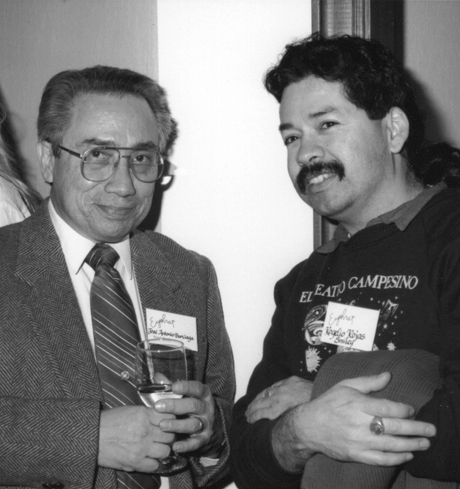 José Antonio Burciaga with Rogelio Smiley Rojas , founder of Teatro Familia Aztlán at Euphrat's Benefit for Art Education honoring Joan Barram , January 1994. They were featured artists in the exhibition Coming Across: Art by Recent Immigrants . Hosts David and Eppie Lam . 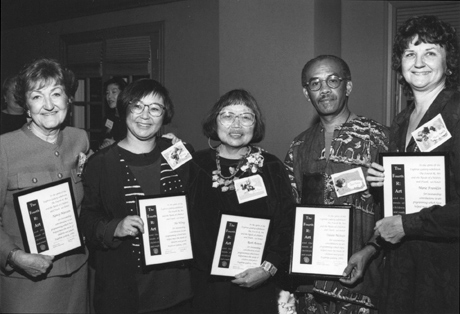 Ruth Asawa , center, with four "unsung heroes" in art education whom we honored at Euphrat's The Fourth R: Art benefit for arts and education in January 1992. Hosts George and Judy Marcus. Left to right: Nancy Marston, founder, the Los Altos Art Docents program in the Los Altos School District; Flo Wong, advocate, Sunnyvale School District, Resurrection School, workshops; Ruth Asawa, renowned leader in art, art education and public sculpture, SF Art Commissioner, collaborator, advocate, alumna of Black Mountain College; Talala Mshuja, founder of Nairobi Cultural Center, East Palo Alto; Marie Franklin , advocate and teacher at Stocklmeir School in Cupertino Union School District |
| Copyright © 2013-25 Jan Rindfleisch. All rights reserved. |

